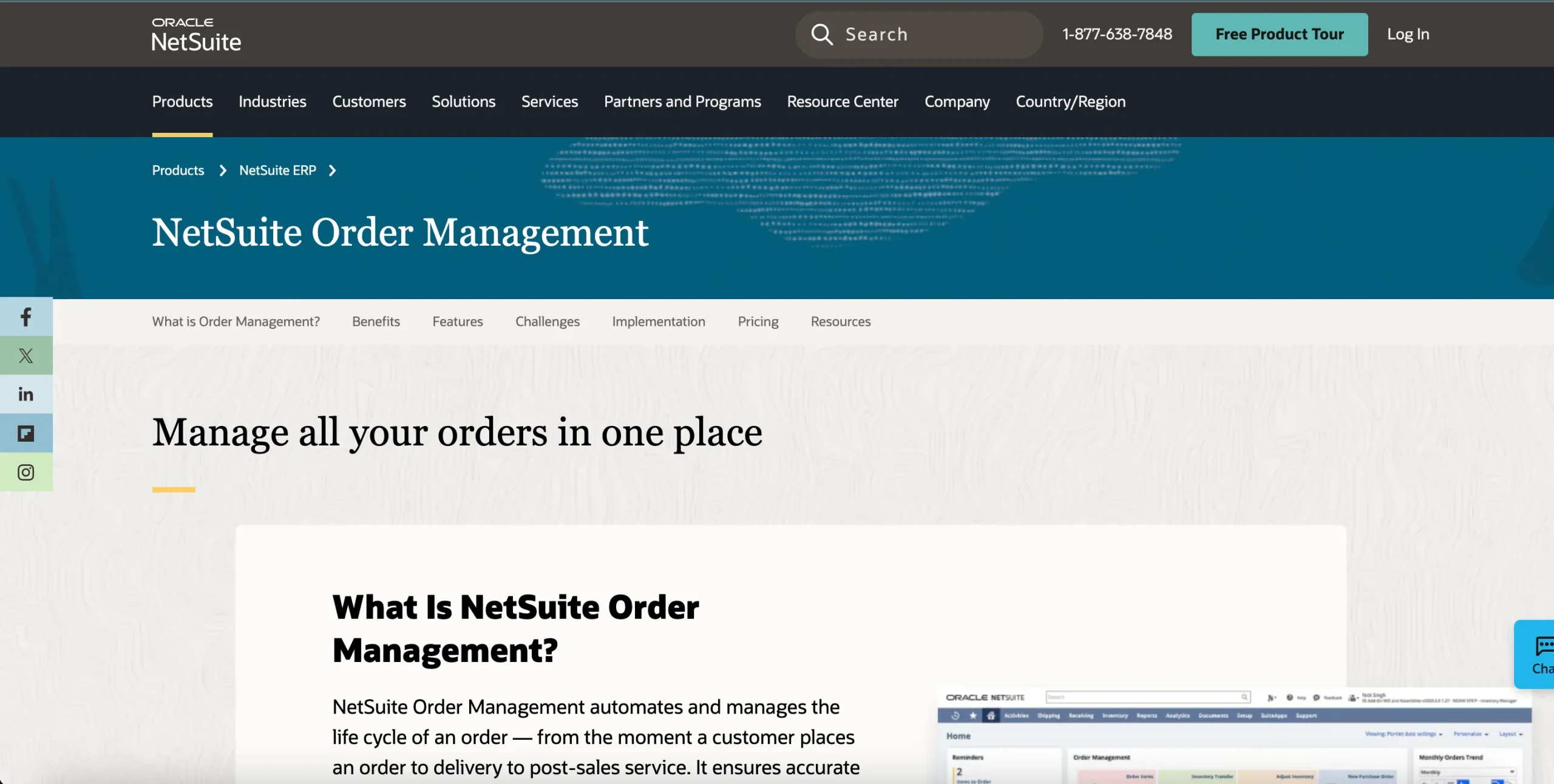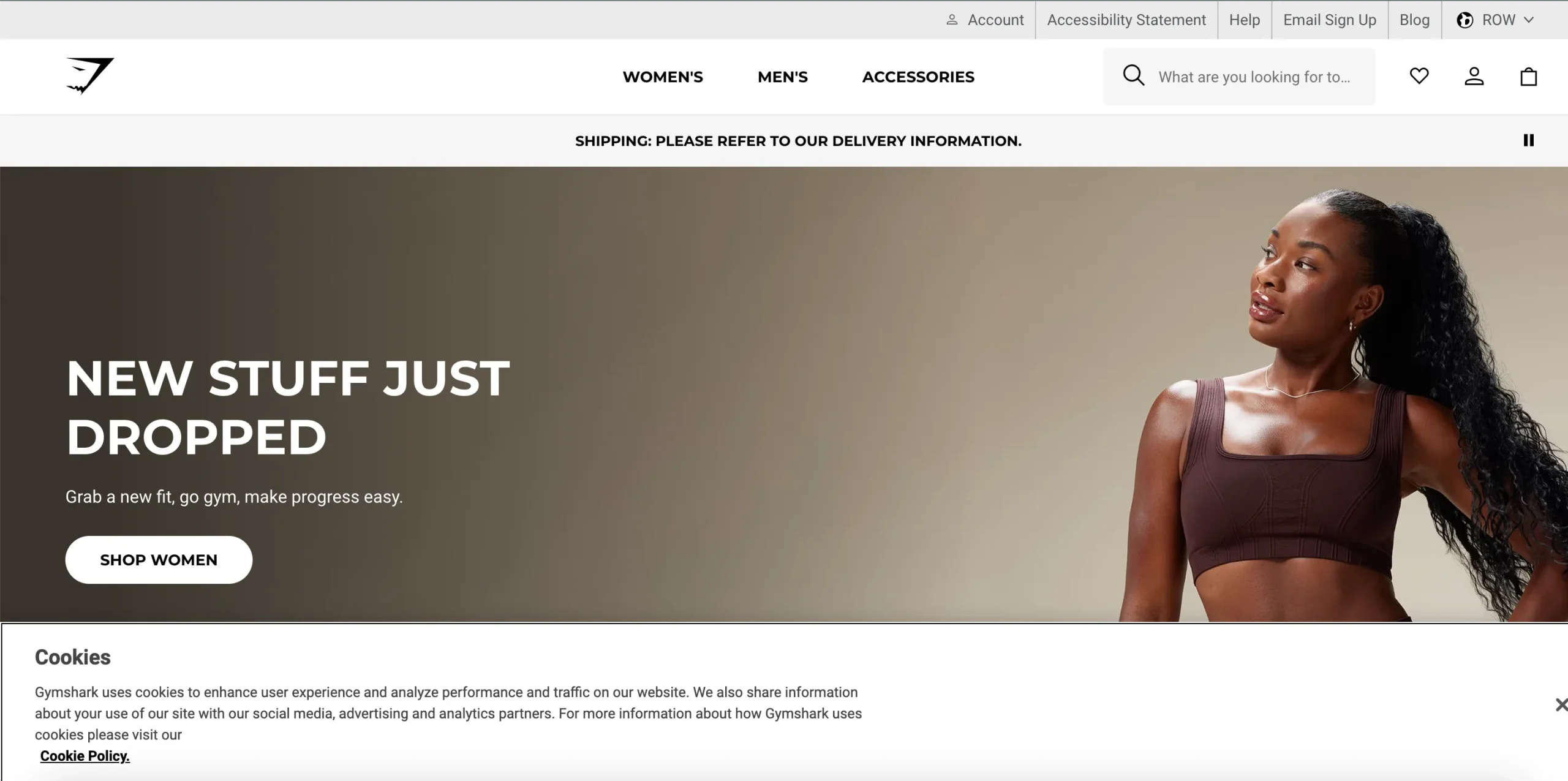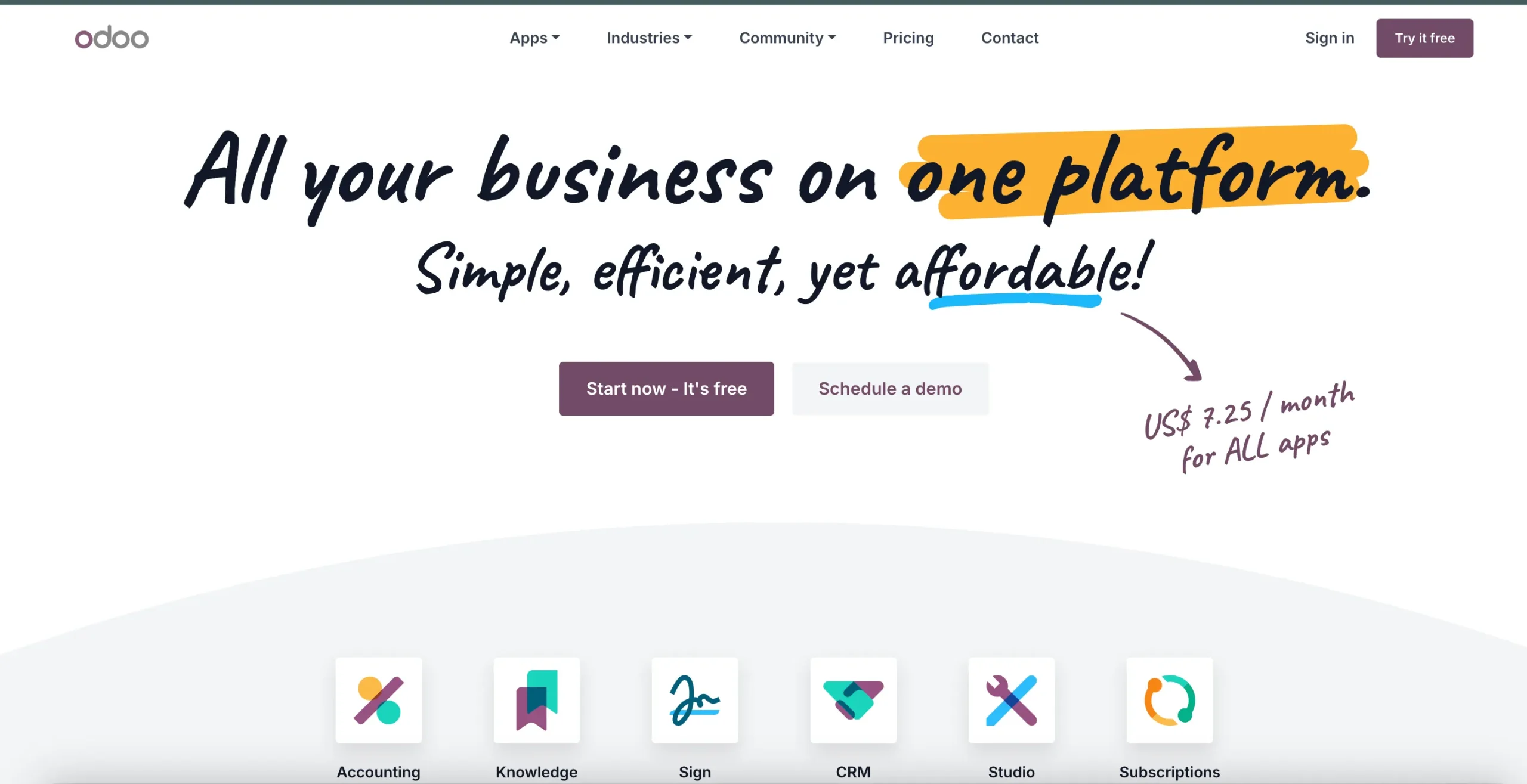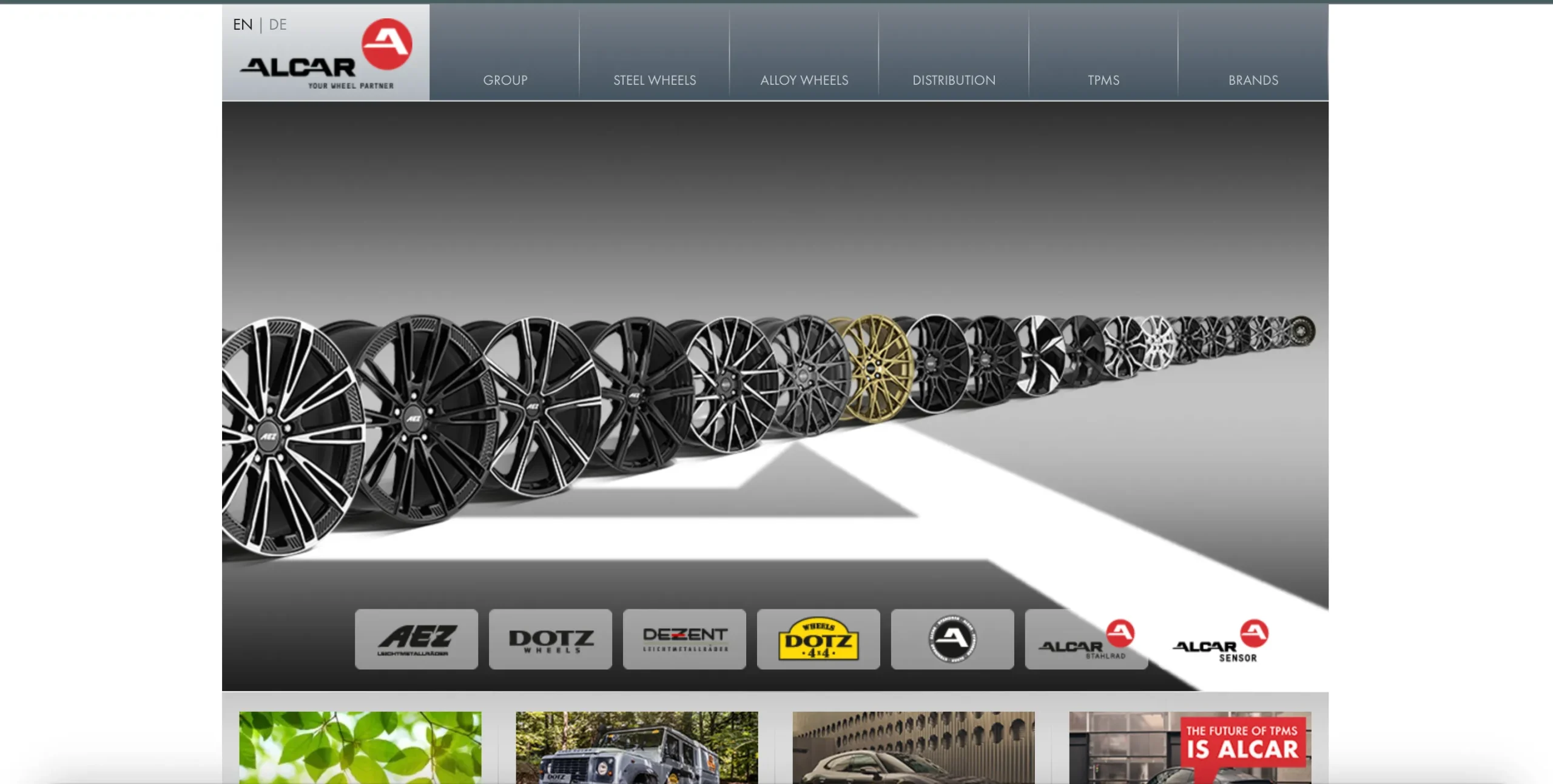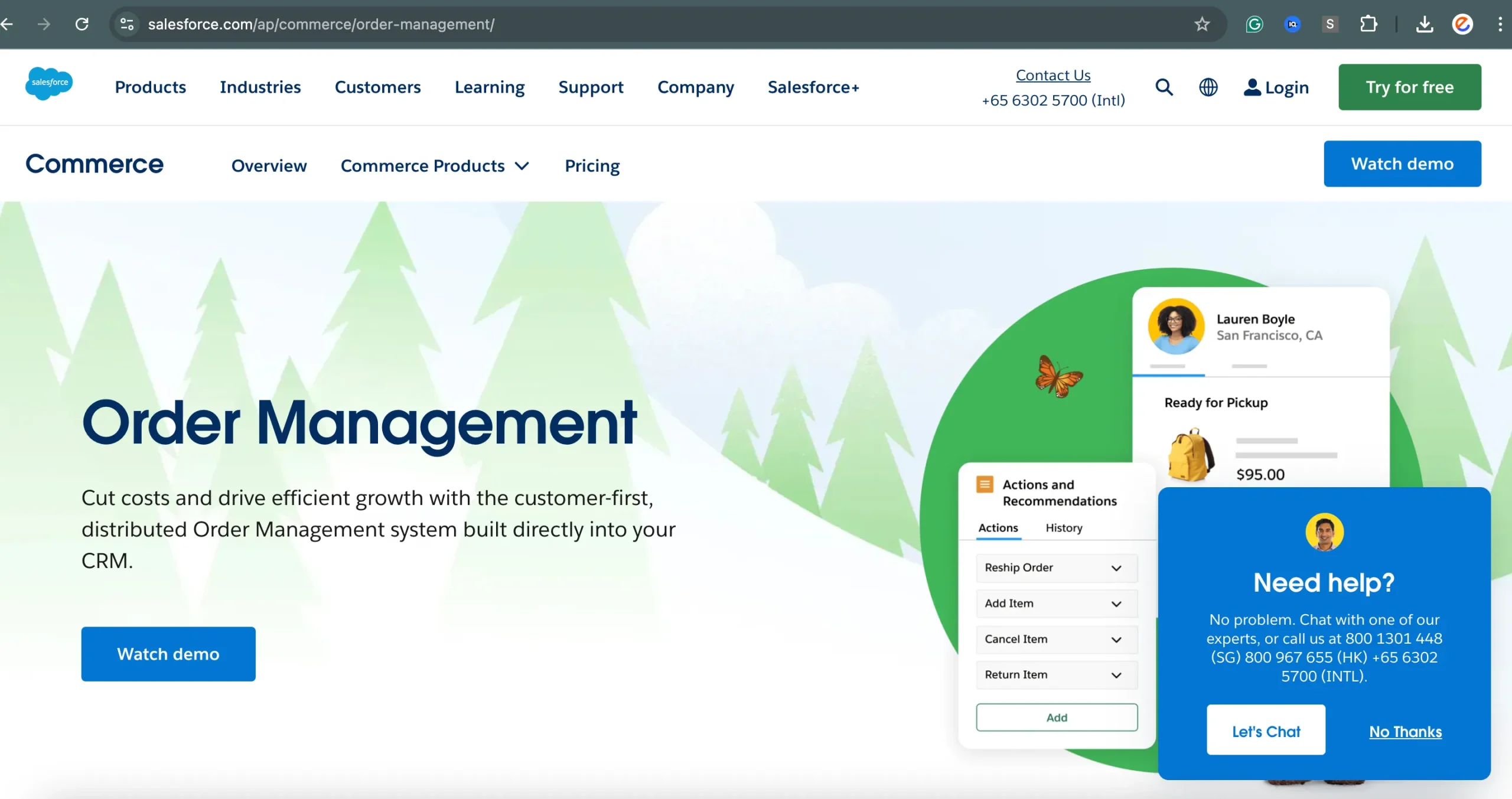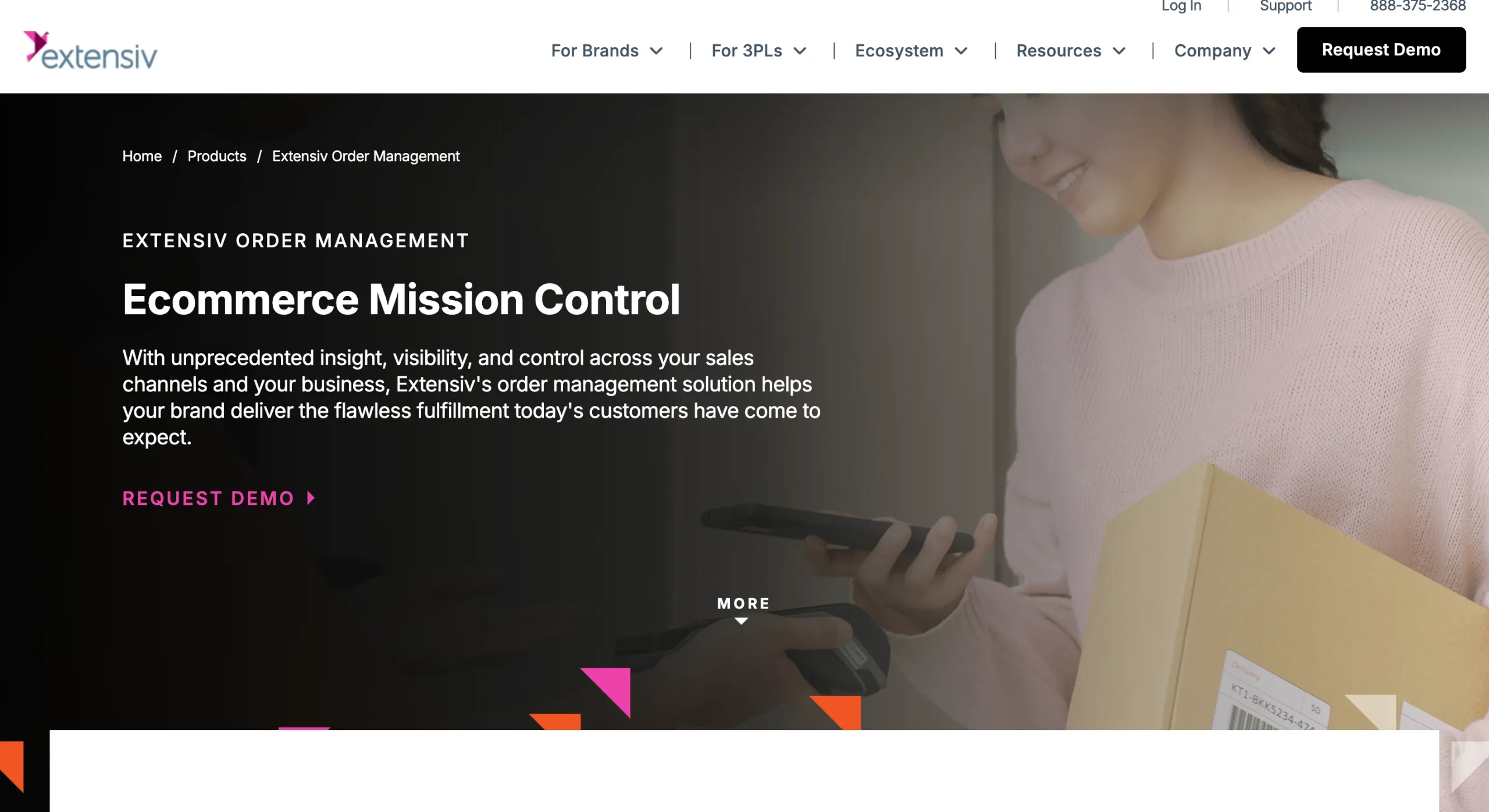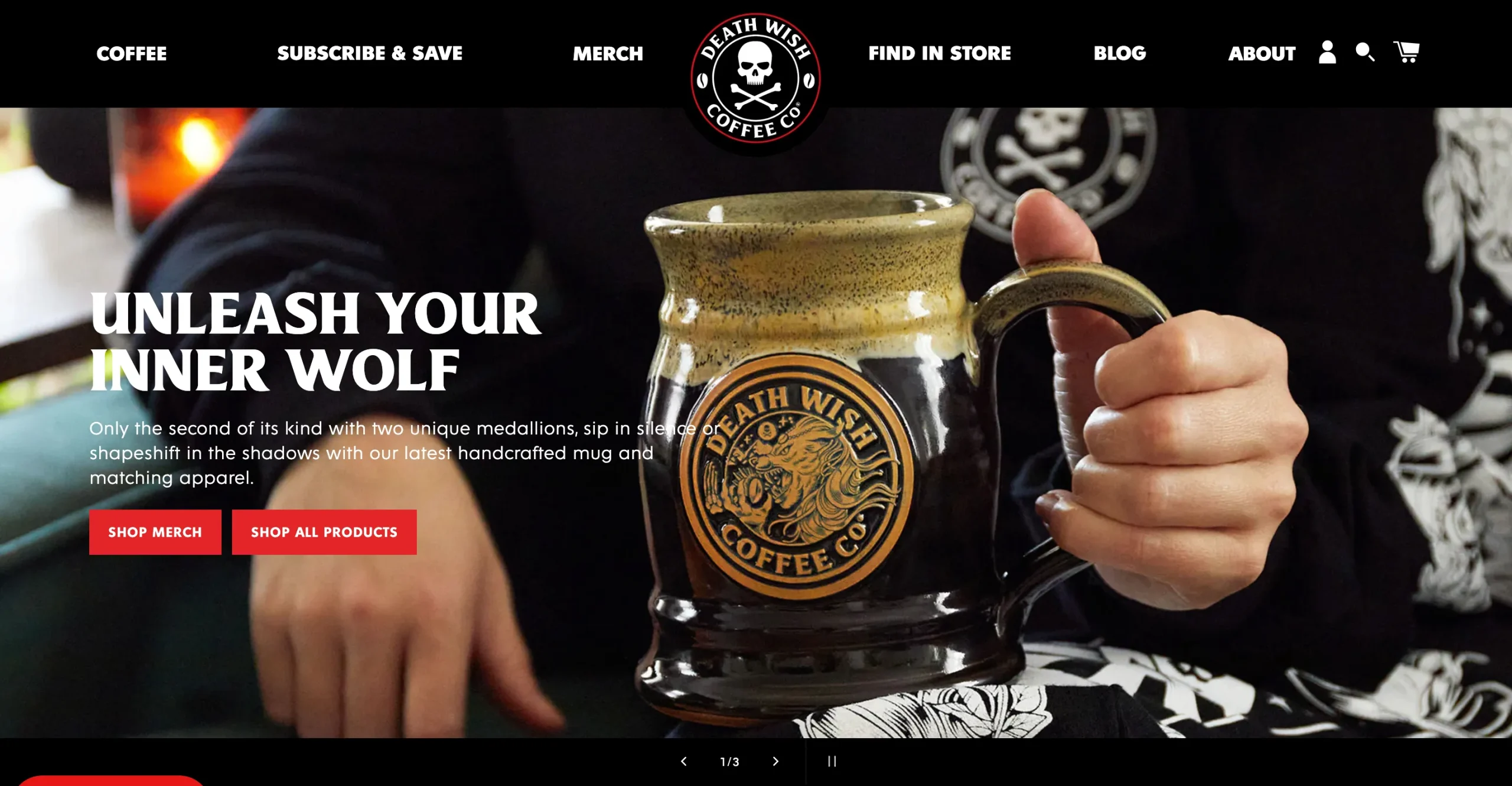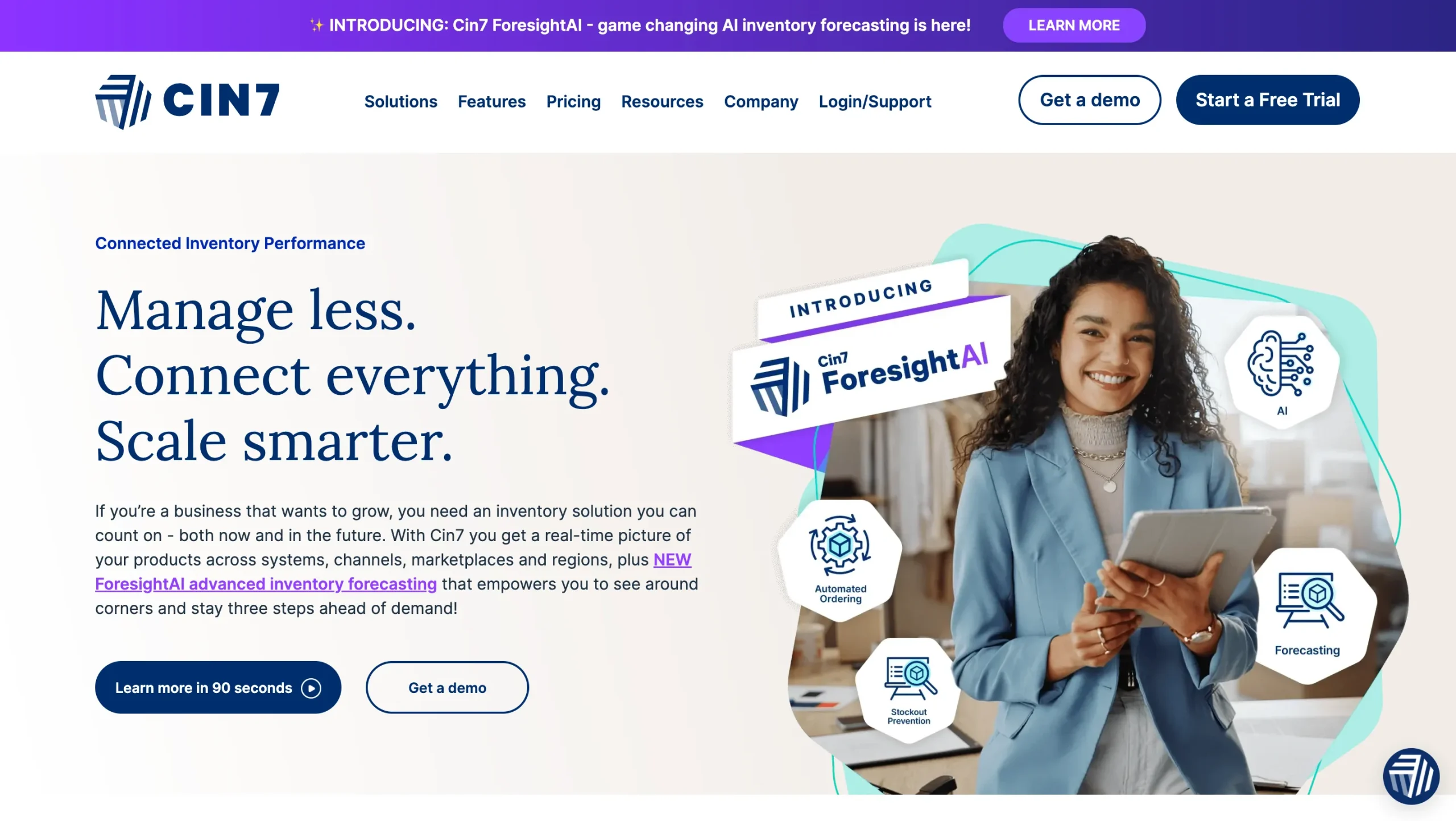Omnichannel order management has become a cornerstone for businesses striving to meet the evolving demands of modern consumers. Now customers expect a seamless shopping experience across all channels—whether they are purchasing in-store, online, or through a mobile app. As a result, effective omnichannel order management has emerged as a critical strategy for retailers to provide a unified and consistent experience across multiple platforms. This involves coordinating orders, inventory, and customer data in real-time to ensure that every purchase, return, and inquiry is handled efficiently and without friction.
Table of Contents
- Understanding Omnichannel Order Management
- Key Concepts of Omnichannel Order Management
- Core Benefits of Omnichannel Order Management
- Features to Look for in an Order Management System
- Top 10 Omnichannel Order Management Systems
- Challenges in Omnichannel Order Management
- Best Practices for Implementing Omnichannel Order Management
Understanding Omnichannel Order Management
What is Omnichannel Order Management?
Omnichannel order management refers to the process of seamlessly integrating and managing customer orders across multiple sales channels—whether it’s through an online store, a mobile app, or a physical retail location. This approach ensures that businesses can efficiently fulfill orders regardless of where the customer made the purchase, providing a unified experience that bridges the gap between different platforms. Omnichannel order management involves coordinating inventory, processing orders, and delivering products while maintaining a consistent flow of information across all channels. This means that whether a customer orders a product online and picks it up in-store or chooses to have it delivered from a warehouse, the experience remains fluid and cohesive.
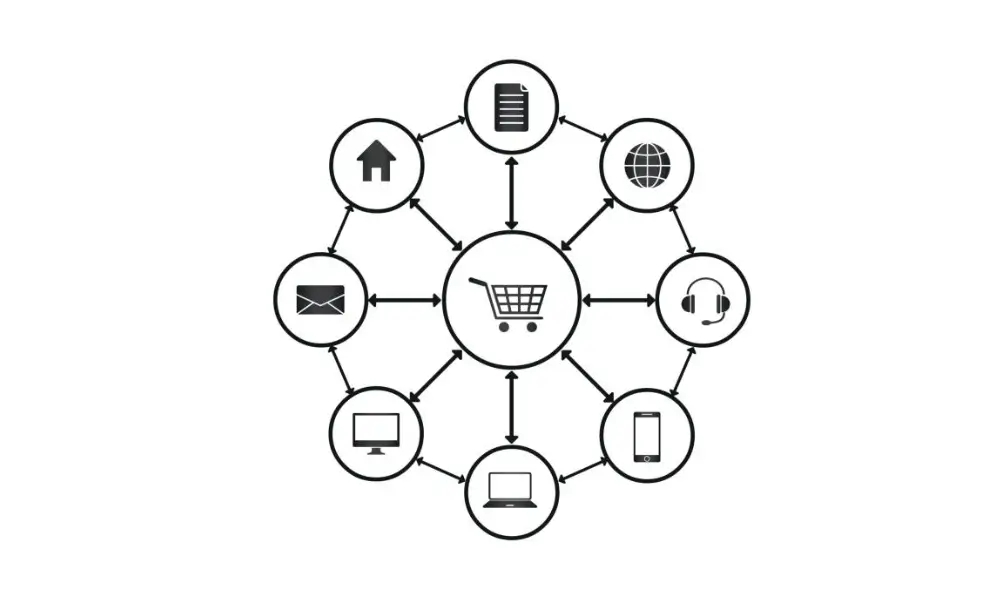
At the heart of omnichannel order management lies the ability to synchronize data in real-time. This synchronization enables businesses to track inventory levels, manage customer information, and streamline order fulfillment processes without discrepancies. By creating a single view of orders, companies can handle complex workflows, reduce inefficiencies, and improve order accuracy. In short, omnichannel order management allows businesses to cater to today’s digital-savvy consumers by offering flexibility, convenience, and a frictionless buying experience across various platforms.
Role Of Order Management In Customer Experience And Business Efficiency
Order management plays a crucial role in shaping both the customer experience and the overall efficiency of a business. In today’s fast-paced retail environment, customers expect timely deliveries, accurate order tracking, and the ability to switch between online and offline channels seamlessly. Omnichannel order management systems help meet these expectations by ensuring that orders are processed swiftly and accurately, regardless of the channel through which they were placed. This creates a seamless experience for customers, as they can trust that their orders will be fulfilled efficiently, whether they’re ordering online or in-store.
From a business efficiency perspective, omnichannel order management reduces manual processes and minimizes errors that can arise from disjointed systems. By automating various stages of the order lifecycle, including order processing, inventory updates, and shipping notifications, businesses can enhance their operational efficiency. Moreover, having a centralized system for managing orders across all channels helps businesses avoid duplication of efforts and ensures that their teams have access to the same information. This improves internal communication, reduces delays, and enhances the overall speed at which orders are fulfilled.
In addition to improving operational efficiency, omnichannel order management provides businesses with valuable data that can be used to optimize future sales and marketing efforts. By analyzing customer buying patterns across different channels, businesses can gain insights into consumer behavior, enabling them to tailor their marketing strategies and product offerings to meet demand more effectively. In turn, this data-driven approach enhances the customer experience and further boosts business performance.
How Omnichannel Order Management Fits Into The Modern Retail Ecosystem
Omnichannel order management is a key component of the modern retail ecosystem, as it addresses the increasingly complex needs of both businesses and consumers. In an era where customers expect flexibility and convenience, retailers must be able to manage orders across multiple touchpoints, while providing a consistent and unified experience. This has led to the rise of omnichannel strategies that go beyond traditional single-channel approaches to encompass various sales platforms, from eCommerce websites to mobile apps and physical stores.
In this evolving ecosystem, omnichannel order management functions as the backbone that ties these channels together. By integrating with other systems such as customer relationship management (CRM), enterprise resource planning (ERP), and warehouse management systems (WMS), omnichannel order management allows businesses to operate as a cohesive whole. This level of integration ensures that data flows smoothly between departments, enabling businesses to respond to customer needs faster and more accurately.
Furthermore, as consumers increasingly use digital channels to interact with brands, omnichannel order management systems help businesses stay competitive by providing the agility needed to adapt to changing market trends. Retailers that embrace this approach can offer services like buy online, pick up in-store (BOPIS), or ship-from-store, allowing customers to choose the most convenient option. In doing so, businesses can not only attract more customers but also build lasting relationships by delivering an outstanding omnichannel shopping experience.
Key Concepts of Omnichannel Order Management
Unified Inventory Visibility
The Importance Of Real-Time Inventory Tracking
In the world of omnichannel order management, real-time inventory tracking is a critical component that enables businesses to maintain visibility over their stock across all sales channels. Whether customers are shopping online, in-store, or via a mobile app, they expect accurate information about product availability. Real-time inventory tracking ensures that businesses can meet these expectations by continuously monitoring inventory levels and making adjustments as needed. This level of transparency is essential not only for providing an exceptional customer experience but also for improving operational efficiency.
For businesses engaged in omnichannel order management, real-time inventory tracking helps to streamline order fulfillment processes. With up-to-the-minute data on stock levels, companies can make informed decisions about where to source products—whether from a warehouse, a retail location, or a third-party supplier. This agility reduces fulfillment delays and allows businesses to optimize delivery times. Furthermore, real-time tracking empowers companies to better manage demand surges, ensuring that they can adjust stock levels promptly and avoid disappointing customers with out-of-stock products.
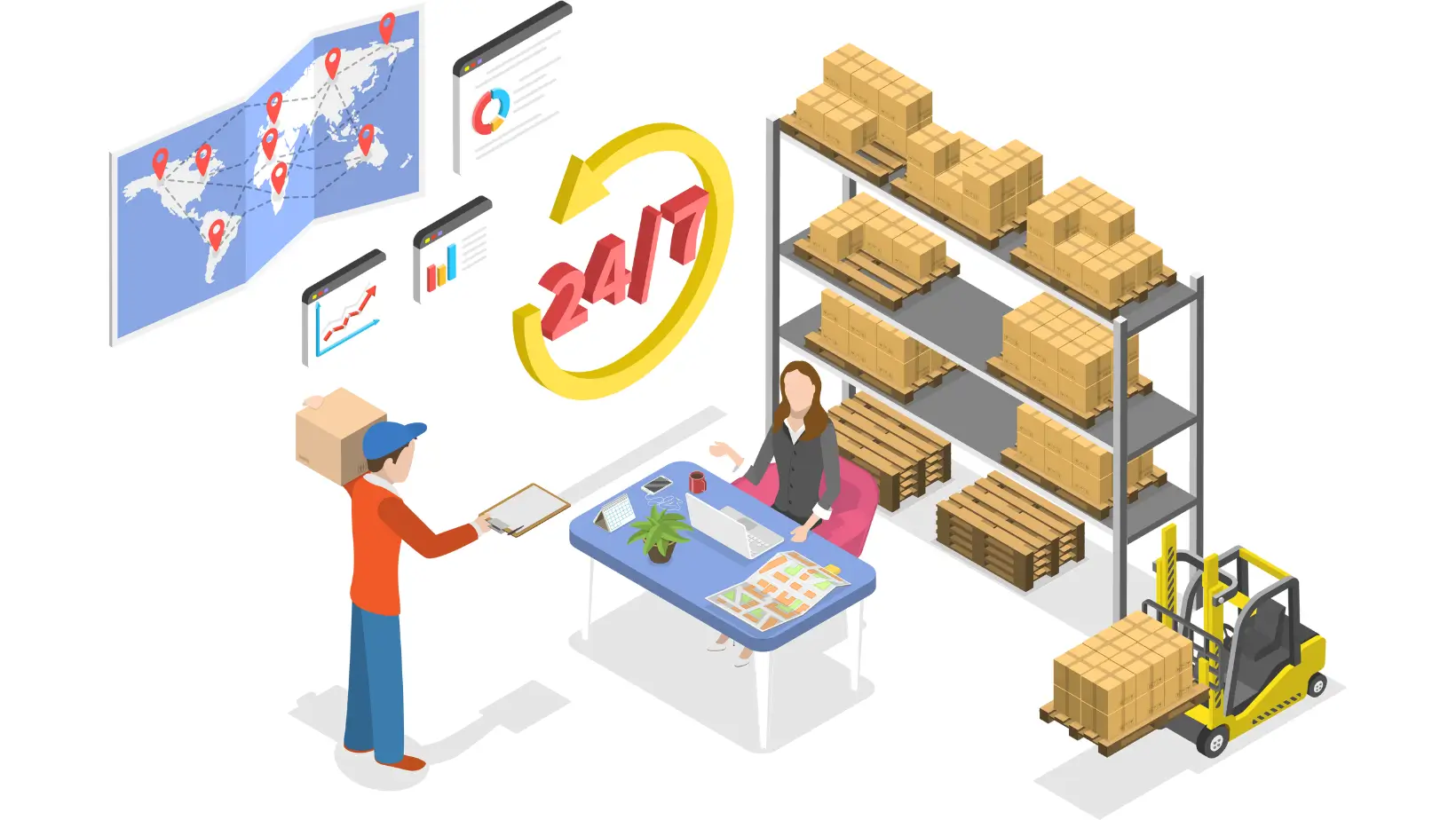
Additionally, real-time inventory visibility plays a crucial role in managing customer expectations. When businesses display accurate stock levels across all sales channels, they help build customer trust. If customers are assured that the product they want is available, they are more likely to complete the purchase. Conversely, if stock levels are inaccurate or not updated in real-time, it could lead to customer dissatisfaction, abandoned carts, and missed sales opportunities.
Integration Of Inventory Data Across Physical And Digital Channels
A seamless integration of inventory data across both physical and digital channels is foundational to effective omnichannel order management. With customers increasingly shopping across multiple platforms, businesses need to ensure that inventory data is synchronized and accessible no matter where a purchase is made. This requires creating a unified system where inventory updates from various sources—whether it’s a warehouse, retail store, or an online platform—are consolidated into one central database that is always up to date.
In the context of omnichannel order management, this integration allows businesses to gain a comprehensive view of their entire stock across different locations. Whether a product is sitting in a warehouse, on a store shelf, or in transit, businesses need to have accurate data that reflects the product’s current availability. This centralized approach minimizes the risks associated with fragmented systems where inventory data might be isolated across different platforms, resulting in inconsistencies.
Moreover, integrated inventory data across physical and digital channels allows businesses to provide more flexible fulfillment options to their customers. For example, businesses can offer services like buy online, pick up in-store (BOPIS), or ship-from-store, all while ensuring that inventory is appropriately managed across channels. This level of flexibility is increasingly expected by consumers and can give businesses a competitive edge in the retail space.
Avoiding Stockouts And Overselling Through Accurate Inventory
One of the primary challenges businesses face in omnichannel order management is balancing inventory levels to avoid both stockouts and overselling. A stockout occurs when a product is no longer available to fulfill customer orders, leading to lost sales and frustrated customers. On the other hand, overselling happens when a product is sold beyond its available stock, resulting in canceled orders and negative customer experiences. Both scenarios can severely impact customer satisfaction, loyalty, and a business’s bottom line.
Accurate inventory management through omnichannel order management systems helps businesses mitigate these risks by ensuring that inventory levels are always current and correct. With real-time updates and synchronized data, businesses can prevent overselling by accurately reflecting stock levels across all sales channels. If a product runs low in one channel, the system can automatically update all other channels, ensuring that customers are only able to purchase items that are truly available.
Similarly, accurate inventory management helps avoid stockouts by providing businesses with a clear view of stock levels and enabling proactive stock replenishment. Businesses can identify when inventory is running low and restock items in time to meet customer demand, thus avoiding missed sales. Additionally, businesses that operate multiple fulfillment locations can reallocate stock based on demand, ensuring that high-demand areas are always adequately supplied.
By integrating accurate inventory data into their omnichannel order management strategy, businesses can strike a balance between supply and demand, reducing the risks of stockouts and overselling. This ultimately leads to greater customer satisfaction, improved operational efficiency, and increased sales, as customers are more likely to find the products they want available when and where they need them. Omnichannel order management’s emphasis on unified inventory visibility and accuracy is essential for businesses looking to thrive in today’s competitive retail landscape.
Order Routing & Fulfillment Optimization
Different Methods Of Order Routing
Order routing is a pivotal aspect of omnichannel order management, as it determines how and where customer orders are fulfilled. In the context of modern retail, businesses often have multiple fulfillment locations, including warehouses, distribution centers, and brick-and-mortar stores. Efficient order routing is essential to ensure that each customer order is fulfilled from the most optimal location, which can reduce delivery times, minimize costs, and improve overall customer satisfaction.
There are several methods businesses can use to route orders, depending on the resources and infrastructure available:
- Routing to the closest warehouse: One of the most common and straightforward methods is fulfilling orders from the warehouse or distribution center closest to the customer’s location. This minimizes shipping time and cost, making it an effective strategy for companies with an extensive warehouse network. In omnichannel order management, systems automatically determine the nearest warehouse with available stock and route the order accordingly, ensuring timely delivery.
- Routing to the nearest store: For retailers with physical locations, routing orders to the closest store for fulfillment is another efficient method. This is particularly beneficial in scenarios where warehouses are located far from the customer but a nearby store has available inventory. Additionally, businesses can offer options like buy online, pick up in-store (BOPIS), where customers can collect their orders directly from the store. This method enhances convenience and reduces shipping costs.
- Routing based on inventory availability: When certain fulfillment centers are running low on stock, omnichannel order management systems can reroute orders to locations with sufficient inventory. This prevents backorders and delays, ensuring that customers receive their orders promptly. In this case, the system prioritizes fulfilling orders from locations with higher stock levels, even if they are not the closest.
- Hybrid routing methods: Many businesses adopt a combination of these strategies, optimizing fulfillment based on factors such as delivery time, shipping cost, and inventory availability. A hybrid approach in omnichannel order management allows companies to dynamically route orders, taking into account variables like warehouse proximity, stock levels, and customer preferences for delivery or pickup.
How Businesses Can Optimize Routing For Faster Delivery Times And Lower Costs
Optimizing order routing is essential for businesses seeking to enhance their omnichannel order management capabilities. The primary goals of optimized routing are to reduce delivery times, lower shipping costs, and improve customer satisfaction. To achieve these goals, businesses must adopt strategies that leverage technology, data analytics, and a flexible infrastructure.
- Utilizing real-time data: One of the key strategies in optimizing routing is the use of real-time data to make informed decisions. By integrating real-time inventory levels, customer location, and shipping partner availability into the omnichannel order management system, businesses can dynamically route orders in the most efficient way possible. For example, if a certain fulfillment center experiences delays due to high demand, the system can automatically reroute orders to an alternative location to avoid disruptions.
- Implementing distributed fulfillment models: Another effective way to optimize routing is to implement distributed fulfillment models. Instead of relying solely on large central warehouses, businesses can set up multiple smaller fulfillment centers or utilize stores as micro-fulfillment hubs. This decentralization allows orders to be fulfilled closer to customers, significantly reducing shipping times and costs. In addition, businesses can route orders based on proximity and customer preferences, ensuring a smooth and efficient process.
- Prioritizing cost-effective shipping options: Optimized order routing also involves selecting the most cost-effective shipping methods without sacrificing speed. Businesses can partner with multiple carriers and use their omnichannel order management system to compare shipping rates and times. This allows companies to choose the best option for each order, balancing cost with delivery speed. By automating these decisions within the system, businesses can ensure that every order is routed through the most economical and efficient shipping method.
- Optimizing for peak demand periods: During high-demand periods, such as holidays or sales events, businesses need to be even more strategic in their routing decisions. Omnichannel order management systems can be programmed to prioritize certain fulfillment centers or adjust inventory allocations to meet the increased demand. Additionally, companies can use predictive analytics to forecast demand spikes and ensure that the right stock is positioned in the right locations ahead of time.
AI And Machine Learning In Optimizing Order Fulfillment
As businesses continue to innovate in the field of omnichannel order management, artificial intelligence (AI) and machine learning (ML) have emerged as powerful tools for optimizing order fulfillment. These technologies enable businesses to automate and enhance their decision-making processes, leading to faster delivery times, lower costs, and improved customer experiences.
- Predictive analytics for demand forecasting: One of the most valuable applications of AI in omnichannel order management is demand forecasting. Machine learning algorithms can analyze historical sales data, market trends, and customer behavior to predict future demand with a high degree of accuracy. This allows businesses to optimize their inventory distribution and ensure that products are stocked in the right locations to meet anticipated demand. By positioning inventory strategically, businesses can reduce the likelihood of stockouts and overselling, improving order fulfillment speed and accuracy.
- Dynamic order routing based on AI insights: AI-powered systems can also dynamically route orders based on real-time data and predictive insights. For example, an AI-driven omnichannel order management system can automatically select the best fulfillment location based on factors such as delivery time, shipping cost, and inventory levels. Machine learning algorithms can continuously refine their decision-making processes, improving efficiency over time. This dynamic approach ensures that each order is fulfilled in the most optimal way possible, taking into account real-time changes in demand, stock availability, and logistics capabilities.
- Automating fulfillment workflows: In addition to improving decision-making, AI can also be used to automate fulfillment workflows, reducing manual intervention and increasing efficiency. For example, AI can be used to automate the assignment of orders to fulfillment centers, manage shipping labels, and coordinate with third-party logistics providers. By streamlining these processes, businesses can reduce errors, cut down on fulfillment times, and lower operational costs.
- AI-driven customer personalization: Beyond optimizing logistics, AI can enhance the customer experience by providing personalized fulfillment options. Machine learning algorithms can analyze customer preferences, purchasing history, and geographic location to offer tailored delivery options. For instance, AI can recommend the best delivery method for a specific customer based on their previous behavior, whether it’s same-day delivery, in-store pickup, or standard shipping. This personalized approach can improve customer satisfaction and boost retention rates.
Order routing and fulfillment optimization are crucial elements of an effective omnichannel order management strategy. By employing various routing methods, optimizing for speed and cost, and integrating advanced technologies like AI and machine learning, businesses can streamline their operations and deliver a seamless customer experience. As retail continues to evolve, these strategies will become even more important for companies looking to stay competitive and meet the demands of modern consumers.
Integration of Sales Channels (Online, Offline, Mobile)
Synchronization Between eCommerce Platforms, Physical Stores, And Mobile Apps
A central pillar of omnichannel order management is the seamless integration and synchronization of sales channels, including eCommerce platforms, physical stores, and mobile apps. In today’s retail environment, consumers frequently switch between these channels, expecting a consistent and unified experience regardless of how or where they interact with a brand. This makes synchronization a critical component, allowing businesses to maintain up-to-date and accurate information across all touchpoints, from inventory levels and product availability to pricing and promotions.
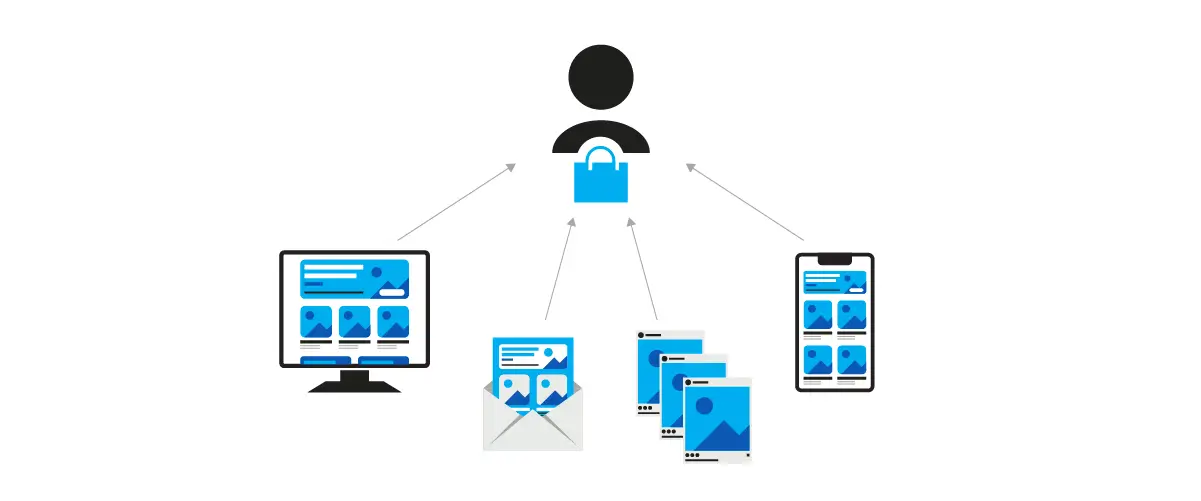
For omnichannel order management to succeed, data from each sales channel must flow in real-time, ensuring that customer orders, inventory updates, and shipping details are automatically reflected across all platforms. For example, if a customer purchases a product online, the system must immediately update inventory in physical stores and on mobile apps to prevent overselling. Similarly, if a product is returned in-store, it should be instantly available for online and mobile shoppers. Without this level of synchronization, businesses risk creating disjointed customer experiences and operational inefficiencies that can lead to lost sales, inventory errors, and dissatisfied customers.
Furthermore, integrating sales channels ensures that businesses can offer flexible fulfillment options such as buy online, pick up in-store (BOPIS) or return in-store for online purchases. By providing these options, businesses give customers greater convenience and control over their shopping experience, which in turn fosters loyalty and repeat business. Through omnichannel order management, companies can deliver a truly cohesive shopping experience that meets customer expectations, regardless of the sales channel they choose.
Ensuring Consistent Customer Experiences Across Multiple Channels
Consistency across all sales channels is essential for businesses seeking to provide a seamless and satisfying customer experience. In the context of omnichannel order management, consistency means that customers receive the same information, product availability, and service quality whether they shop through a website, mobile app, or in-store. This not only enhances the overall shopping experience but also strengthens the brand by creating a unified identity across all touchpoints.
A critical aspect of achieving this consistency is the integration of customer data. In omnichannel order management, customer information—such as purchase history, preferences, and loyalty points—should be accessible across all channels. For example, if a customer purchases an item online, they should be able to access their order history and make returns or exchanges in-store without any complications. Similarly, any personalized offers or rewards they have earned should be available whether they are shopping via a mobile app or visiting a physical store.
Additionally, businesses must ensure that product information, pricing, and promotions are consistent across all channels. Discrepancies in product descriptions or prices between online stores and physical locations can confuse customers and damage trust in the brand. Omnichannel order management systems help prevent this by synchronizing product data in real-time, ensuring that customers encounter the same accurate information regardless of the channel. Promotions and discounts also need to be aligned, so customers can enjoy the same deals whether they shop online, in-store, or through a mobile app.
Consistency in customer service is another key factor in omnichannel order management. Whether customers are engaging with a business via an online chat, calling customer support, or interacting with sales associates in-store, the level of service and support they receive should remain consistent. Omnichannel order management systems allow businesses to track and manage customer interactions across all touchpoints, ensuring that customer service representatives have access to relevant order details and can provide assistance no matter the channel.
By ensuring consistency in product information, pricing, promotions, and customer service, businesses can create a more unified and satisfying customer experience. This not only helps retain existing customers but also attracts new ones by demonstrating reliability and coherence across all channels.
Managing Sales From Marketplaces Like Amazon, eBay, Shopify, etc.
In today’s retail ecosystem, businesses often expand their reach by selling on multiple marketplaces such as Amazon, eBay, and Shopify, in addition to their own eCommerce websites and physical stores. Managing sales from these marketplaces presents unique challenges, as each platform comes with its own rules, inventory management systems, and customer expectations. However, with an effective omnichannel order management system in place, businesses can streamline the management of these sales channels and ensure that their operations remain efficient and cohesive.
One of the key benefits of omnichannel order management is the ability to centralize sales data from multiple marketplaces into one unified system. This centralization allows businesses to monitor and manage orders, inventory, and customer information from all sales platforms in real-time. By integrating marketplace data with the rest of the business’s sales channels, omnichannel order management systems prevent stock discrepancies, over- or underselling, and fulfillment delays.
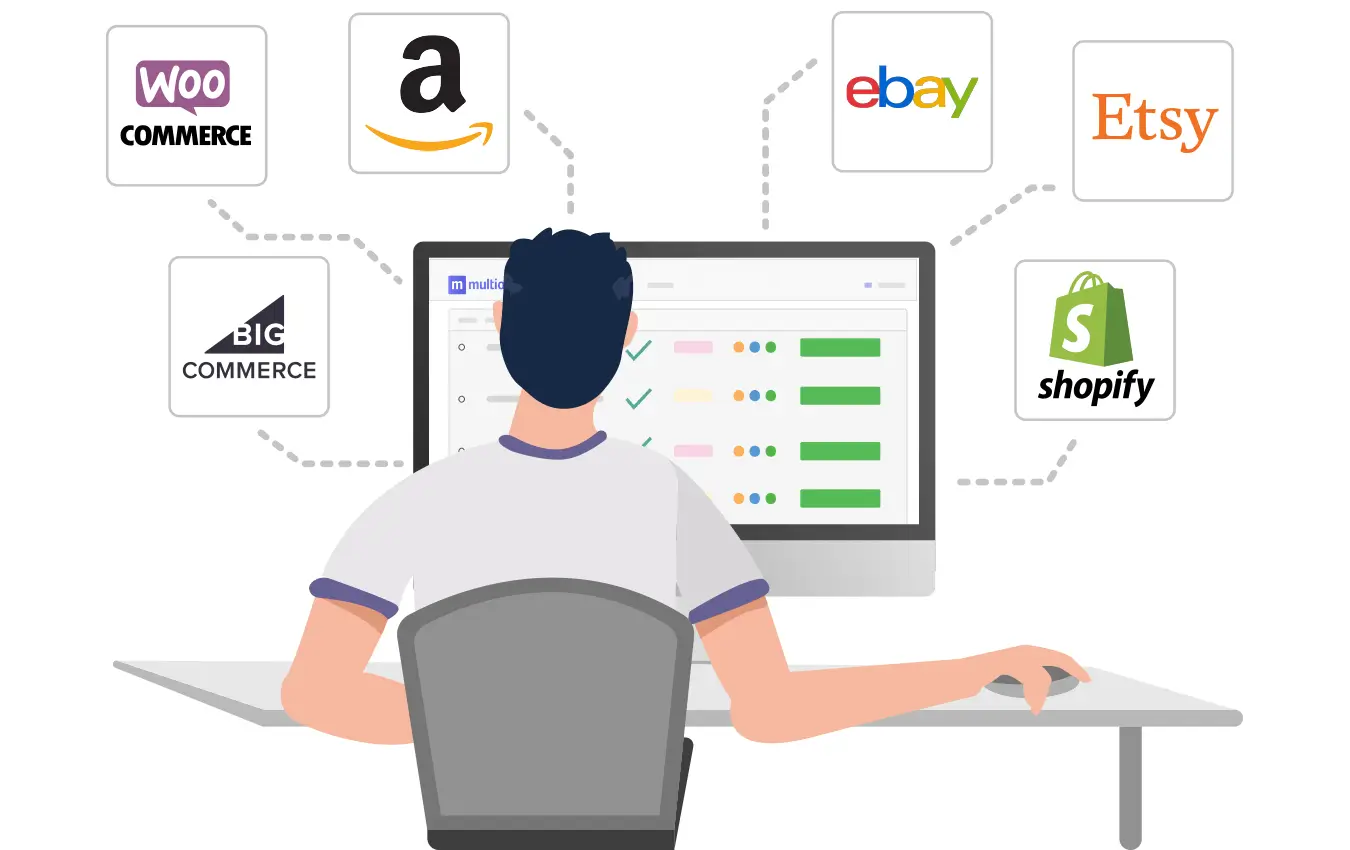
For example, if a product is sold on Amazon, the system will automatically update the inventory across all other sales channels, including eBay, Shopify, and the business’s own website, to reflect the sale. This real-time synchronization ensures that businesses are not caught off guard by unexpected sales volumes or inventory shortages, which can lead to order cancellations and negative customer feedback. Furthermore, by consolidating marketplace data into a single dashboard, businesses can easily track performance across different platforms and make informed decisions about inventory distribution, marketing, and fulfillment strategies.
Another critical aspect of managing sales from marketplaces is the fulfillment process. Different marketplaces may have specific requirements for shipping, packaging, and customer communication. Omnichannel order management systems can automate these processes, ensuring that each order meets the specific criteria of the marketplace where it was sold. This reduces the risk of errors, improves efficiency, and ensures that customers across all platforms receive the same high level of service.
In addition, managing returns and exchanges from marketplaces is simplified with omnichannel order management. Whether a customer returns a product purchased on Amazon or requests an exchange for an item bought on eBay, the system can handle these processes seamlessly, updating inventory and customer records across all platforms. This consistency helps businesses maintain a smooth flow of operations and enhance customer satisfaction, even when selling across multiple marketplaces.
Core Benefits of Omnichannel Order Management
Enhanced Customer Satisfaction
Faster Delivery Times And Accurate Order Fulfillment
Customers increasingly expect their orders to be fulfilled quickly and with precision. Omnichannel order management plays a crucial role in meeting these expectations by optimizing the entire order fulfillment process, from the moment a customer places an order to the point of delivery. With real-time inventory tracking and data synchronization across all channels, businesses can efficiently route orders to the nearest or most appropriate fulfillment center, whether it be a warehouse, distribution center, or physical store.
This efficiency reduces the time it takes to process, package, and ship orders, resulting in faster delivery times for customers. When orders are fulfilled quickly and accurately, customers are more likely to have a positive experience, increasing the chances of repeat business and brand loyalty. In contrast, delayed or inaccurate orders can lead to dissatisfaction, negative reviews, and potential loss of future sales.

Moreover, omnichannel order management allows businesses to dynamically adjust fulfillment strategies based on factors such as demand, inventory levels, and shipping costs. This flexibility ensures that orders are always fulfilled in the most efficient way possible, further improving delivery speed and accuracy. In addition to faster delivery, omnichannel order management systems can automate notifications, keeping customers informed about the status of their orders, which adds an extra layer of transparency and builds trust.
Accurate order fulfillment is another essential component of customer satisfaction. By synchronizing inventory across all sales channels and fulfillment centers, omnichannel order management reduces the risk of errors such as overselling or stock discrepancies. This means that customers can shop with confidence, knowing that the items they purchase are in stock and will be delivered as promised. Fewer mistakes in the fulfillment process lead to fewer returns, exchanges, and customer complaints, creating a more positive overall shopping experience.
Offering More Options For Order Pickup (In-Store Pickup, Curbside, etc.)
Flexibility in how orders are fulfilled is another critical factor in enhancing customer satisfaction through omnichannel order management. As consumers increasingly demand convenience and control over their shopping experiences, offering multiple options for order pickup has become a valuable feature for businesses looking to meet these expectations. Omnichannel order management enables companies to provide customers with a range of pickup options, such as in-store pickup, curbside pickup, and even locker-based pickup at designated locations.
In-store pickup is one of the most popular fulfillment options that omnichannel order management facilitates. Customers can order products online and pick them up at a nearby store, often within hours. This eliminates shipping time and costs, offering customers immediate access to their purchases. It also provides the added benefit of allowing customers to inspect items in-store before taking them home, which can reduce return rates and improve satisfaction. For businesses, in-store pickup also presents opportunities for additional sales, as customers may browse and make additional purchases while picking up their orders.
Curbside pickup has gained significant traction, particularly in the post-pandemic retail environment, as it offers a contactless and convenient option for customers. With omnichannel order management, businesses can streamline the curbside pickup process by coordinating order fulfillment and providing real-time updates to customers. Shoppers can place orders online, drive to the designated location, and have their items brought directly to their vehicle. This level of convenience has become a competitive advantage for businesses, especially for customers who value quick and easy pickups without entering the store.
In addition to traditional pickup methods, omnichannel order management allows businesses to offer innovative solutions such as locker-based pickup. These lockers can be placed at convenient locations, such as near stores or in public areas like train stations or office complexes. Customers can pick up their orders at their leisure by using a unique code sent to them after their order is fulfilled. This flexibility enhances the shopping experience by giving customers more control over when and how they receive their purchases, further boosting satisfaction.
By offering these diverse order fulfillment options, businesses can cater to a wide range of customer preferences, making shopping more convenient and tailored to individual needs. Omnichannel order management systems ensure that all of these pickup options are seamlessly integrated into the fulfillment process, allowing businesses to meet customer expectations without compromising efficiency.
Increased Efficiency and Reduced Costs
Automation In Order Processing
Automation is a key element of omnichannel order management that enables businesses to handle a high volume of orders quickly and accurately. In a traditional setup, order processing often requires manual input and oversight, leading to potential errors, bottlenecks, and delays. However, with an automated system in place, many of the labor-intensive tasks associated with order processing can be completed without human intervention, freeing up staff to focus on more strategic activities.
Omnichannel order management systems automate a wide range of processes, from order confirmation and payment processing to inventory updates and shipping label generation. For example, once a customer places an order, the system automatically confirms the order, checks the availability of the item, processes the payment, and updates the inventory in real-time across all channels. This not only speeds up the entire process but also eliminates the risk of human error, ensuring that orders are processed accurately and efficiently.

Automation also extends to communication with customers. Omnichannel order management systems can automatically send order confirmations, shipping notifications, and delivery updates, keeping customers informed at every stage of their purchase journey. This level of transparency not only enhances the customer experience but also reduces the workload for customer service teams, as automated updates minimize the need for customers to reach out for information about their orders.
Moreover, automation in order processing can help businesses scale more easily. As a company grows and handles an increasing number of orders across multiple sales channels, automation ensures that the system can process these orders swiftly and accurately, regardless of volume. This scalability allows businesses to handle peak shopping periods, such as holidays or promotional events, without compromising efficiency or customer satisfaction.
Efficient Warehouse And Stock Management
Efficient warehouse and stock management are central to the success of any omnichannel order management strategy. Managing inventory across multiple channels—whether it’s an online store, a physical location, or a marketplace—requires real-time synchronization and accurate tracking. Omnichannel order management systems provide businesses with the tools to optimize inventory management, ensuring that products are available where and when they are needed, while minimizing waste and stock discrepancies.
One of the key advantages of omnichannel order management is the ability to track inventory in real-time across all sales channels. This centralized view of stock levels allows businesses to make informed decisions about where to fulfill orders from, reducing the chances of stockouts or overselling. If an item is running low in one location, the system can automatically reroute orders to a different warehouse or store with available stock, ensuring that orders are fulfilled without delay.

In addition to real-time inventory tracking, omnichannel order management systems enable businesses to optimize their warehouse operations. By implementing automated picking and packing systems, businesses can reduce the time it takes to prepare orders for shipping, thus increasing the efficiency of warehouse staff. Advanced systems can also group orders based on delivery locations or product categories, enabling more efficient order batching and reducing the time spent on individual shipments.
Furthermore, omnichannel order management systems provide detailed insights into inventory turnover rates and demand patterns. This data allows businesses to forecast future demand more accurately and plan stock replenishment accordingly. By optimizing stock levels and ensuring that popular items are always available in the right quantities, businesses can reduce carrying costs and avoid the pitfalls of excess inventory or deadstock. In the long run, this improves cash flow and reduces waste, contributing to overall cost savings.
Reduced Shipping And Handling Costs Through Strategic Fulfillment
Shipping and handling costs are a significant expense for businesses, especially those managing multiple sales channels. However, with omnichannel order management, companies can reduce these costs through strategic fulfillment. By optimizing the routing of orders to the closest or most efficient fulfillment centers, businesses can minimize shipping distances, reduce delivery times, and lower transportation expenses.
Omnichannel order management systems enable businesses to route orders based on factors such as customer location, inventory availability, and shipping costs. For example, if a customer places an order online, the system can automatically determine whether it’s more cost-effective to fulfill the order from a nearby store, a warehouse, or a third-party logistics provider. This flexibility in fulfillment options allows businesses to reduce transportation costs by leveraging the most efficient resources available.
Additionally, businesses can reduce shipping costs by implementing strategies such as buy online, pick up in-store (BOPIS) or curbside pickup, both of which eliminate the need for shipping altogether. Customers appreciate the convenience of these options, and businesses benefit from lower shipping expenses while still offering a high level of service.
Handling costs can also be reduced through automation and better warehouse management. Omnichannel order management systems streamline the fulfillment process by automating tasks such as label printing, packing, and shipping carrier selection. This reduces the time and labor required to prepare orders for shipping, leading to lower operational costs. Moreover, businesses can negotiate better shipping rates with carriers based on the volume of orders being processed through a centralized system, further reducing shipping expenses.
Finally, the ability to manage returns more efficiently is another cost-saving benefit of omnichannel order management. Businesses can process returns across multiple channels—whether the purchase was made online, in-store, or through a marketplace—allowing for faster restocking and minimizing the financial impact of returns. By optimizing return logistics, businesses can recover value from returned products more quickly and efficiently, further contributing to reduced handling costs.
Improved Inventory Management
Real-Time Data On Inventory Levels
One of the most valuable aspects of omnichannel order management is the ability to access real-time data on inventory levels across all sales channels. Traditional inventory management systems often struggle to keep up with the complexities of modern retail, especially when stock is distributed across multiple locations, such as warehouses, retail stores, and even third-party fulfillment centers. Omnichannel order management systems, however, provide businesses with a single, unified view of inventory, allowing them to monitor stock levels accurately and in real time.
Real-time inventory tracking is essential for meeting customer expectations in today’s market, where consumers expect immediate product availability, regardless of where or how they choose to shop. Omnichannel order management allows businesses to synchronize inventory data across all channels, ensuring that every point of sale reflects the most up-to-date stock levels. Whether customers are shopping online, browsing in-store, or using a mobile app, they can confidently make purchases knowing that the items they want are in stock and ready for fulfillment.
Moreover, real-time data enables businesses to make more informed decisions about product allocation and replenishment. If a product is selling faster in one location or through a particular sales channel, omnichannel order management systems can alert the business to adjust inventory accordingly. This level of visibility and control helps ensure that businesses always have the right products in the right places, reducing the chances of stockouts and lost sales.
For businesses operating across multiple geographic regions or fulfillment centers, real-time inventory data also provides the flexibility to fulfill orders from the nearest or most convenient location. This not only enhances the efficiency of order fulfillment but also reduces shipping times and costs, contributing to a more streamlined operation and a better customer experience.
Reduced Risks Of Overstocking And Stockouts
Overstocking and stockouts are two of the most common inventory challenges businesses face, both of which can have a detrimental impact on profitability and customer satisfaction. Overstocking ties up valuable capital in excess inventory that may not sell, while stockouts result in lost sales opportunities, disappointed customers, and potentially damaged brand reputation. Omnichannel order management helps reduce these risks by providing businesses with real-time insights and predictive tools to optimize their stock levels.
Through the centralized inventory management capabilities of omnichannel order management, businesses can avoid overstocking by better aligning supply with demand. Instead of relying on manual inventory checks or siloed systems that don’t communicate effectively, omnichannel order management systems track inventory movement across all sales channels in real time. This visibility allows businesses to quickly identify slow-moving products and adjust stock replenishment strategies accordingly, minimizing the likelihood of over-ordering and reducing excess stock.

At the same time, omnichannel order management helps mitigate the risk of stockouts by ensuring that businesses maintain adequate stock levels to meet demand. By integrating inventory data from all locations, businesses can set automatic reordering triggers when stock levels reach a certain threshold, ensuring that popular items are replenished before they run out. This not only prevents stockouts but also enhances customer satisfaction, as customers are less likely to encounter situations where their desired items are unavailable.
Omnichannel order management systems can also route orders to alternative locations if one fulfillment center or store is low on stock. For instance, if a particular product is out of stock in one location, the system can automatically check inventory at other nearby locations and fulfill the order from there. This flexibility minimizes the risk of losing sales due to stockouts and helps businesses maintain a consistent flow of goods across all channels.
Better Decision-Making With Accurate Demand Forecasting
Accurate demand forecasting is another key benefit of improved inventory management through omnichannel order management. Predicting customer demand accurately is essential for businesses looking to optimize inventory levels, reduce waste, and ensure timely fulfillment. Omnichannel order management systems utilize real-time data and advanced analytics to provide more precise demand forecasting, allowing businesses to make better-informed decisions about inventory replenishment, production planning, and sales strategies.
Demand forecasting within an omnichannel order management system involves analyzing historical sales data, current market trends, and customer behavior across all channels. By drawing on this wealth of data, businesses can predict future demand with greater accuracy, helping them avoid both overstocking and stockouts. For example, if a particular product sees a spike in demand during certain seasons or promotional periods, omnichannel order management systems can flag these patterns, allowing businesses to prepare accordingly by increasing stock levels before demand surges.

Better demand forecasting also enables businesses to plan more effectively for peak shopping periods, such as Black Friday, holiday sales, or back-to-school promotions. With insights generated from past performance and real-time data, businesses can anticipate demand fluctuations and adjust inventory levels in advance. This reduces the likelihood of stock shortages during critical sales periods and ensures that businesses can meet customer expectations without overcommitting resources to excess inventory.
Additionally, accurate demand forecasting helps businesses optimize their purchasing and supplier relationships. By understanding demand patterns, businesses can negotiate more favorable terms with suppliers, purchase inventory in bulk at optimal times, and minimize rush orders that may incur higher costs. This not only improves operational efficiency but also leads to significant cost savings over time.
Seamless Returns Management
Centralized Returns Processing Across All Channels
One of the key benefits of omnichannel order management is its ability to centralize returns processing, providing a unified platform for handling returns across all sales channels, whether the original purchase was made online, in-store, or through a third-party marketplace. Traditional returns management systems often struggle with channel-specific workflows, which can result in inconsistencies, delays, and confusion for both customers and staff. However, with omnichannel order management, businesses can create a streamlined returns process that integrates all sales channels, making it easier to manage and track returns from a single, centralized system.
Centralized returns processing allows businesses to gain a complete overview of all returns activities in real-time, regardless of where the return was initiated. For example, if a customer purchases a product online but wishes to return it in-store, omnichannel order management systems can seamlessly coordinate the return across both channels. The system updates inventory levels and sales records automatically, ensuring that both the store and the online platform reflect the return in real-time. This eliminates the need for manual data entry or separate systems to handle returns, reducing errors and delays.
By centralizing returns processing, businesses can also optimize their logistics and inventory management. Returned items can be routed to the most appropriate location, whether it’s a nearby store for restocking or a warehouse for inspection. This flexibility helps businesses manage returns more efficiently, minimizing disruptions to inventory and ensuring that returned products are quickly re-integrated into the sales cycle when applicable.
How Omnichannel Order Management Simplifies The Returns Process
Omnichannel order management simplifies the returns process by providing a consistent and user-friendly experience for both customers and staff. From the customer’s perspective, a smooth and straightforward returns process is essential for maintaining trust and loyalty. Customers should be able to return products easily, regardless of where or how they purchased them, and omnichannel order management systems ensure that this is possible.
For customers, omnichannel order management offers flexible returns options, such as returning online purchases in-store or shipping items back to a warehouse. This flexibility caters to different customer preferences, making the returns process more convenient and less time-consuming. By offering multiple return channels, businesses can provide customers with the freedom to choose the option that best fits their needs. In addition, omnichannel order management systems can automate return labels, authorization numbers, and tracking information, further simplifying the process for customers and reducing the need for customer service intervention.
From an operational standpoint, omnichannel order management eliminates many of the complexities associated with traditional returns processes. For instance, when a customer initiates a return, the system can automatically check the original order details, verify the product’s return eligibility, and process the return based on predefined rules, such as restocking fees or return windows. This automation reduces the manual workload for staff, accelerates the returns process, and ensures that all returns are handled consistently across channels.
Additionally, omnichannel order management systems allow businesses to track and analyze return data, offering insights into return patterns, product quality issues, or areas where the customer experience might need improvement. By identifying the reasons behind returns, businesses can adjust their product offerings, packaging, or return policies to reduce the overall return rate and improve customer satisfaction.
Enhancing Customer Loyalty Through Hassle-Free Returns
A seamless and hassle-free returns experience is crucial for enhancing customer loyalty in today’s competitive retail environment. Studies consistently show that customers are more likely to shop with a brand that offers a simple and transparent returns process, and a poor returns experience can drive customers away, even if the initial purchasing experience was positive. Omnichannel order management helps businesses create a returns process that not only meets but exceeds customer expectations, fostering long-term loyalty.
One of the ways omnichannel order management enhances customer loyalty is by providing a transparent and convenient returns process that puts the customer’s needs first. Customers value flexibility and the ability to return products without unnecessary hurdles. Whether it’s the ability to return an item purchased online to a physical store or the option to mail back a product with a prepaid label, omnichannel order management ensures that customers can easily choose the method that works best for them. By offering multiple returns options and minimizing complications, businesses build trust and encourage repeat purchases.

Furthermore, omnichannel order management allows businesses to offer faster refunds, which is a key factor in customer satisfaction. Once a return is initiated, the system can automatically process the refund, update the customer’s account, and notify them when the return is complete. Customers appreciate timely refunds, and this quick resolution helps reinforce their trust in the brand. Omnichannel order management also enables businesses to handle exchanges more efficiently, ensuring that customers who wish to swap a product for a different size or color can do so without delay.
Another important aspect of enhancing customer loyalty through seamless returns is the ability to offer personalized experiences. By tracking return patterns and customer behavior, omnichannel order management systems can help businesses tailor their returns policies to individual customers. For example, businesses might offer extended return windows or special perks for loyal customers, such as free return shipping. These personalized touches create a more positive customer experience and incentivize customers to continue shopping with the brand.
Features to Look for in an Order Management System
Centralized Inventory and Order Tracking
A Single Platform To Track Inventory And Orders In Real Time
In the modern retail environment, businesses operate across a variety of sales channels, including online stores, brick-and-mortar locations, mobile apps, and third-party marketplaces such as Amazon or eBay. Each of these channels represents a potential touchpoint for customer engagement and sales, but managing inventory and order fulfillment across multiple channels can become a logistical challenge without the right systems in place. This is where centralized inventory and order tracking becomes a vital component of an effective omnichannel order management strategy.
A centralized platform allows businesses to track inventory levels and order statuses in real time, providing a unified view of all available stock across channels. Whether an order is placed online, in-store, or via a mobile app, the system automatically updates inventory levels to reflect the sale, ensuring that stock availability is accurate at all times. This real-time synchronization prevents common issues such as overselling or stock discrepancies, which can lead to customer frustration and lost sales.
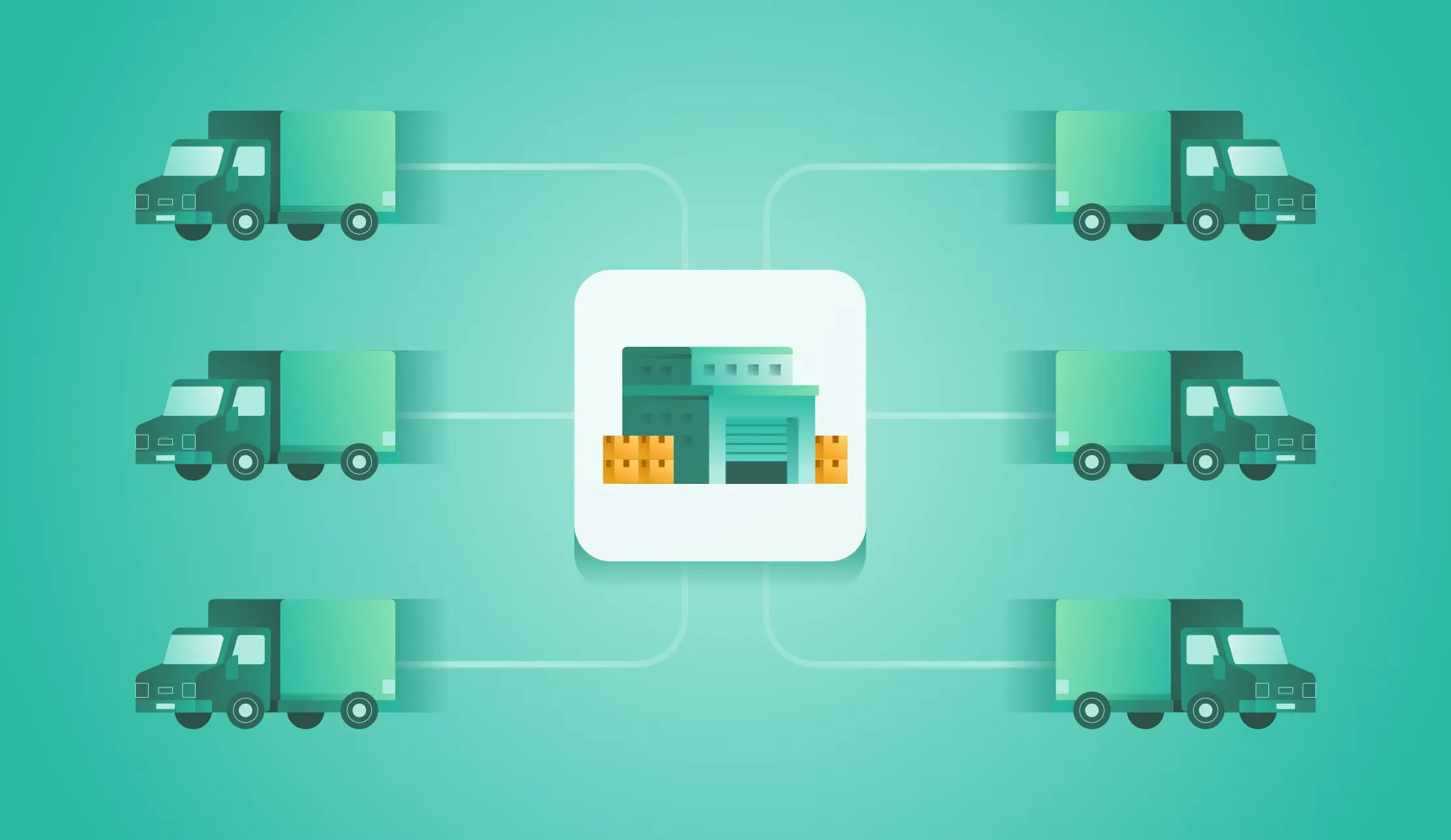
For instance, if a product is purchased online, the centralized system immediately reflects the sale across all channels, reducing the available stock in the warehouse or retail location where the order is being fulfilled. This transparency ensures that all sales channels display accurate inventory levels, allowing customers to confidently make purchases without worrying about stockouts or fulfillment delays. In addition, businesses can better manage high-demand products or limited inventory, avoiding potential pitfalls such as overselling during peak shopping periods or promotional events.
Beyond real-time inventory tracking, centralized order tracking offers businesses and customers greater visibility into the status of each order. With a single platform, businesses can monitor the entire lifecycle of an order, from the moment it is placed to fulfillment and delivery. This not only streamlines internal processes but also improves customer service, as businesses can quickly respond to inquiries about order status or delays. By providing accurate, real-time updates to customers, businesses build trust and enhance the overall shopping experience, further increasing customer loyalty.
Enables Businesses To Manage Stock Across Multiple Locations, Stores, And Warehouses
For businesses with multiple retail locations, warehouses, or fulfillment centers, managing stock efficiently across different sites is essential for both operational success and customer satisfaction. Centralized inventory management within an omnichannel order management system allows businesses to gain full visibility into their stock levels at each location, ensuring that inventory is allocated effectively based on demand and sales patterns. This capability is critical in optimizing the fulfillment process and avoiding costly stockouts or overstocking issues.
One of the most significant advantages of a centralized inventory system is the ability to manage stock across multiple locations seamlessly. For example, if a particular warehouse is running low on a popular item, the system can automatically route orders to another location with available stock, ensuring that customers’ orders are fulfilled without delay. This level of flexibility is invaluable for businesses with a complex supply chain or multiple distribution points, as it reduces the risk of inventory bottlenecks and improves overall fulfillment speed.

Additionally, centralized inventory tracking allows businesses to implement more advanced fulfillment strategies, such as ship-from-store or buy online, pick up in-store (BOPIS). With accurate, real-time stock data, businesses can fulfill online orders from the most convenient physical location, whether it’s a nearby retail store or a distribution center. This reduces shipping times and costs, improving the customer experience and allowing businesses to maximize the efficiency of their existing resources.
For retailers with a global or regional presence, centralized inventory and order tracking also enable better decision-making regarding stock replenishment and transfers. By analyzing inventory levels across all locations, businesses can identify trends and make informed decisions about when and where to move stock to meet customer demand. For example, if one store is experiencing higher-than-expected demand for a particular product, the business can transfer stock from another location where the product is not selling as quickly. This optimization of inventory ensures that stock levels are balanced across the business, reducing the risk of overstocking or stockouts at any given location.
Moreover, centralized inventory management provides critical insights into stock performance, helping businesses identify slow-moving products or items that are more popular in certain regions. By leveraging these insights, businesses can adjust their inventory strategies, improve sales forecasts, and ensure that they always have the right products in the right places to meet customer demand. This level of control is only possible with a centralized system that integrates data from all locations into a single platform, providing real-time visibility and actionable insights.
Cross-Channel Sales Synchronization
Real-Time Synchronization Of Sales From All Channels (Online, In-Store, Mobile, Etc.)
The backbone of successful omnichannel order management is the ability to synchronize sales in real-time across all sales channels. In today’s retail environment, customers often interact with brands through multiple touchpoints, making purchases through a variety of channels—online stores, brick-and-mortar locations, mobile apps, or even third-party marketplaces like Amazon or eBay. Each of these touchpoints represents a separate sales channel, but they must all be unified under one system to ensure seamless operation.
Real-time synchronization ensures that every sale is instantly reflected across the business’s entire ecosystem. When a customer places an order online, the system immediately updates inventory levels, reflecting that sale in-store, on mobile apps, and across other platforms. This instant update is crucial for maintaining accurate stock levels, particularly for businesses that operate with limited inventory or deal with high-demand products. Without real-time synchronization, there is a risk of overselling, leading to customer dissatisfaction, canceled orders, and potential revenue loss.
For instance, if a customer purchases the last available unit of a product online, real-time synchronization ensures that the in-store system is immediately updated to reflect that the item is out of stock. This prevents a situation where a second customer, unaware of the online sale, attempts to purchase the same product in-store, resulting in a frustrating experience for both the customer and the business. By ensuring that all sales channels operate with up-to-the-minute accuracy, businesses can prevent double-selling and maintain better control over their inventory.
Furthermore, real-time synchronization allows businesses to offer more flexible shopping experiences, such as buy online, pick up in-store (BOPIS) or click-and-collect services. These fulfillment options depend on accurate cross-channel synchronization to ensure that products are available when customers come to collect them. Omnichannel order management systems that offer real-time synchronization provide the visibility necessary to manage these orders efficiently, ensuring that customers enjoy a seamless and convenient experience across all platforms.
Ensures Accurate Reporting And Stock Levels To Avoid Double Selling Or Missed Orders
Accurate reporting is essential for businesses to make informed decisions about inventory, sales performance, and customer behavior. In the context of omnichannel order management, cross-channel sales synchronization plays a pivotal role in ensuring that businesses have access to accurate, real-time reports across all channels. Whether a product is sold online, in-store, or via mobile, omnichannel order management systems compile this data into a centralized system, allowing businesses to analyze sales trends, track inventory movement, and forecast demand with precision.
One of the most significant challenges faced by businesses that do not have synchronized sales channels is the risk of stock discrepancies. Without real-time updates, sales made on one platform may not be immediately reflected on others, leading to inaccurate stock levels. For example, if an item sells out in-store but the online store is not updated quickly enough, the product may still appear as available for purchase online, resulting in double-selling. This not only causes operational headaches but can also damage customer trust and lead to a loss of future sales.

Double-selling is a common problem in businesses that operate across multiple channels without proper synchronization. Customers who experience canceled orders due to stock unavailability are likely to become frustrated, and repeated issues of this nature can lead to negative reviews and loss of brand loyalty. Omnichannel order management systems that offer cross-channel sales synchronization eliminate this issue by ensuring that stock levels are always accurate across all sales platforms. The moment an item is sold, it is marked as unavailable on all other channels, preventing additional purchases of out-of-stock items.
Missed orders are another potential pitfall in systems that lack cross-channel synchronization. When sales data from different channels is not consolidated in real time, there is a risk that orders may go unnoticed or delayed, especially during peak sales periods or promotional events. Omnichannel order management systems help businesses avoid this issue by providing a centralized dashboard that tracks all incoming orders from every channel. This ensures that every order is processed and fulfilled without delay, leading to faster shipping times, better customer service, and higher customer satisfaction.
In addition to preventing double-selling and missed orders, cross-channel synchronization helps businesses maintain optimal stock levels. By having real-time visibility into stock movement across all locations, businesses can more effectively manage inventory replenishment. If one channel or location is running low on stock, the system can alert management to restock or transfer inventory from another location where demand may be lower. This level of control ensures that businesses avoid both stockouts and overstocking, helping to optimize cash flow and reduce the risk of unsold inventory.
Moreover, accurate reporting across synchronized channels allows businesses to identify sales trends and make strategic decisions about marketing, promotions, and product placements. For example, if a particular product sells better online than in-store, businesses can allocate more resources to promoting that product on their eCommerce platform or adjust pricing strategies to increase in-store sales. This data-driven approach enables businesses to make proactive decisions that enhance profitability and improve the overall customer experience.
Automation of Order Routing and Fulfillment
Automatic Allocation Of Orders To The Best Fulfillment Center
One of the most important aspects of omnichannel order management is the ability to automatically route orders to the most suitable fulfillment center. For businesses with multiple warehouses, retail locations, or distribution centers, ensuring that each order is fulfilled from the optimal location is essential for both operational efficiency and customer satisfaction. Automated order routing takes the complexity out of this process by automatically selecting the best fulfillment center for each order based on several key factors.
Proximity to the customer is one of the most critical factors in determining the best fulfillment location. The closer a fulfillment center is to the customer, the faster the delivery can be completed, and the lower the shipping costs. Omnichannel order management systems use real-time data to assess the customer’s location and identify the nearest fulfillment center with available stock. This not only reduces shipping times but also minimizes transportation costs, providing a win-win scenario for both the business and the customer. In today’s fast-paced retail environment, where customers expect rapid delivery times, proximity-based order routing is crucial for meeting these expectations and staying competitive.
Stock availability is another essential factor in automatic order allocation. If a fulfillment center is closer to the customer but does not have the required product in stock, it makes little sense to route the order there. Omnichannel order management systems automatically check stock levels across all fulfillment locations in real time. If the closest center is out of stock, the system can quickly route the order to the next nearest location that has the product available. This real-time synchronization of inventory ensures that customers receive their orders as quickly as possible without any delays caused by stock discrepancies.
Shipping costs also play a significant role in automated order routing. In addition to considering proximity and stock availability, omnichannel order management systems can factor in shipping costs when determining the best fulfillment location. For example, while one fulfillment center might be geographically closer, it may have higher shipping costs due to carrier availability or regional factors. By evaluating shipping rates alongside other criteria, the system can choose the most cost-effective option for both the business and the customer. This level of optimization helps businesses reduce operational costs while still providing fast and reliable delivery services.
Automating the allocation of orders to the best fulfillment center eliminates the need for manual decision-making, which can be time-consuming and prone to error. With automation, the entire process happens instantly, allowing orders to be processed and shipped out more quickly. For businesses handling high order volumes, particularly during peak seasons or promotional events, this automation is critical to ensuring that operations run smoothly without bottlenecks or delays.
Reduces Manual Labor And Speeds Up Delivery Times
One of the most significant advantages of automating order routing and fulfillment within an omnichannel order management system is the reduction in manual labor. Traditionally, order fulfillment involves a considerable amount of manual intervention, from deciding which fulfillment center to use to coordinating shipping details and updating stock levels. These manual processes are not only time-consuming but also introduce the potential for human error, which can lead to delays, misrouted orders, and dissatisfied customers.
By automating these tasks, businesses can streamline their operations and free up their staff to focus on higher-value activities, such as customer service or inventory planning. Omnichannel order management systems can handle the entire routing process automatically, from the moment the customer places an order to the moment it is handed over to the carrier for delivery. This automation reduces the chances of mistakes and ensures that orders are processed faster than they would be with manual methods.
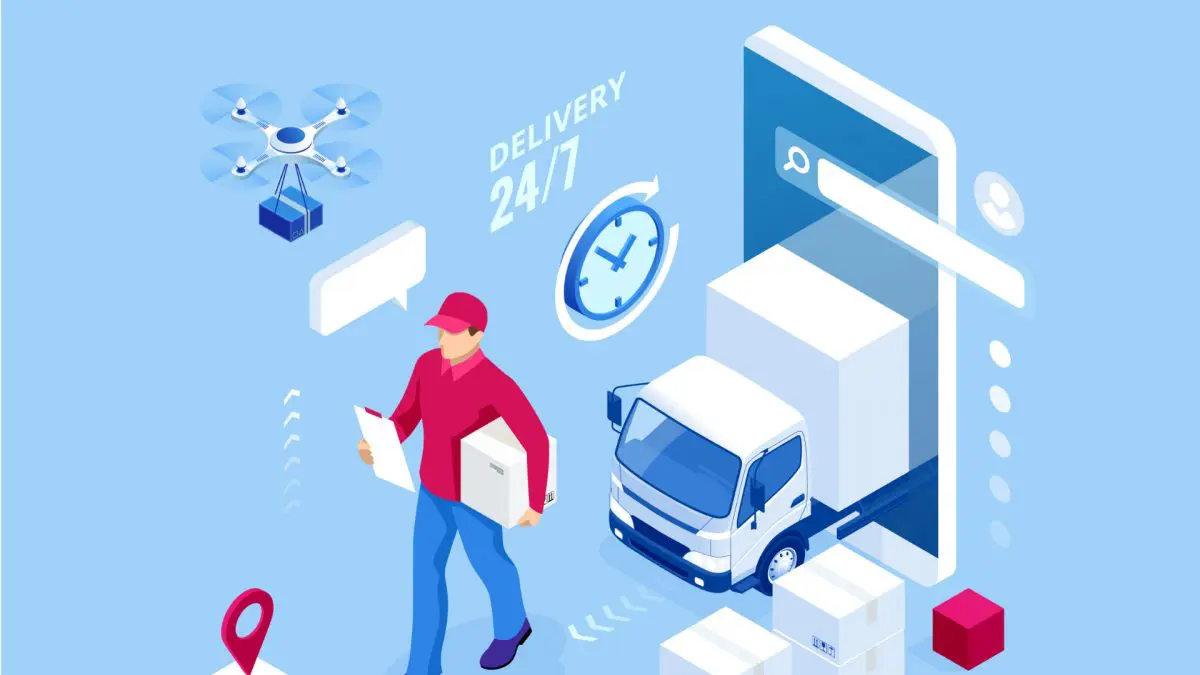
Faster order processing leads directly to shorter delivery times, which is a critical factor in maintaining customer satisfaction. In the age of same-day and next-day delivery expectations, businesses cannot afford to lose time in the order fulfillment process. Automated order routing enables businesses to process orders within minutes of them being placed, ensuring that they can be dispatched quickly and delivered on time. This speed is especially important for businesses that offer expedited shipping options or operate in industries where quick delivery is a competitive advantage.
Moreover, automation can also help with managing last-mile logistics, which is often one of the most expensive and complex parts of the fulfillment process. By automatically selecting the most efficient fulfillment center and carrier, omnichannel order management systems can minimize the time and cost involved in delivering products to the customer’s doorstep. This level of optimization allows businesses to offer faster delivery times while keeping shipping costs under control, which is critical for maintaining profitability in an increasingly competitive market.
Additionally, automation improves the scalability of operations. As businesses grow and the number of orders increases, manually managing fulfillment becomes unsustainable. With an automated system, businesses can handle larger order volumes without needing to hire additional staff or invest heavily in infrastructure. This scalability is particularly beneficial during peak periods, such as holidays or promotional events, when order volumes can surge dramatically. By automating the fulfillment process, businesses can ensure that they meet customer demand efficiently without overburdening their staff or risking delays.
Scalability and Flexibility
The System’s Ability To Grow With The Business
As businesses expand, their order management needs grow more complex. They face increasing volumes of orders, a wider range of products, and more intricate logistics networks. Therefore, it is vital to select an omnichannel order management system that can scale effectively to meet these demands. A scalable system ensures that as the business grows—whether through increased order frequency, additional sales channels, or geographical expansion—it can handle the rising complexity without breaking down or creating operational bottlenecks.
One of the primary benefits of a scalable order management system is the ability to process high volumes of orders efficiently, regardless of how rapidly the business expands. A system that can manage only a limited number of orders per day may work for a small business, but as the company grows, this limitation can lead to delays, processing errors, and customer dissatisfaction. An omnichannel order management system built for scalability, however, can automatically adjust to accommodate higher order volumes without compromising speed or accuracy. This is particularly important for businesses that experience seasonal spikes in demand, such as during holiday shopping periods or major promotional events.
In addition to managing increased order volumes, a scalable omnichannel order management system can support a broader and more diverse product range. As businesses expand their product offerings, they need a system that can efficiently track inventory levels, manage order fulfillment, and update product listings across multiple sales channels. A scalable system can handle larger and more varied inventories, ensuring that businesses continue to provide accurate stock information to customers while maintaining efficient fulfillment processes.
Moreover, scalability extends to the system’s infrastructure. As businesses grow, they may need to integrate with new software platforms, third-party logistics providers, or customer relationship management (CRM) systems. A scalable omnichannel order management system can easily integrate with these additional tools and platforms, ensuring that the business’s technology infrastructure grows in tandem with its operations. This seamless integration helps businesses maintain operational continuity while adapting to new requirements, preventing disruptions and inefficiencies that could hinder growth.
Flexible Options To Add New Sales Channels Or Fulfillment Centers
Flexibility is just as important as scalability when it comes to choosing the right omnichannel order management system. In today’s retail landscape, businesses need to be agile, ready to adapt to changing market trends, and capable of expanding into new sales channels or fulfillment models as opportunities arise. A flexible order management system allows businesses to add new sales channels or fulfillment centers easily, without requiring significant overhauls or costly downtime.
As businesses expand, they often explore additional sales channels, such as new eCommerce platforms, mobile apps, or third-party marketplaces like Amazon, eBay, and Walmart. Each of these channels represents a valuable opportunity to reach new customers and increase sales, but they also introduce new complexities in managing orders, inventory, and customer data. An omnichannel order management system with built-in flexibility makes it easy to integrate these new sales channels into the existing infrastructure. This ensures that all sales data, inventory levels, and customer information are synchronized across every platform, providing a unified experience for both the business and its customers.
For example, a business that starts by selling products through a single eCommerce website may later expand to selling via social media platforms like Facebook or Instagram. A flexible omnichannel order management system allows the business to integrate these new channels without disrupting existing operations. The system should be able to pull order data from each platform, synchronize inventory across all sales channels, and route orders to the appropriate fulfillment centers automatically. This flexibility ensures that businesses can scale their operations smoothly while maintaining an efficient and cohesive order management process.
In addition to expanding into new sales channels, businesses may also need to add new fulfillment centers to support growing demand. As customer expectations for faster delivery times increase, businesses often adopt distributed fulfillment models, leveraging multiple warehouses or retail locations to fulfill orders more quickly. A flexible omnichannel order management system allows businesses to easily add new fulfillment centers to their network, whether they are opening new facilities, partnering with third-party logistics providers, or using existing stores as micro-fulfillment centers.
For instance, when a business opens a new fulfillment center, a flexible omnichannel order management system automatically incorporates the new location into its fulfillment network. The system can then dynamically route orders based on factors like proximity to the customer, stock availability, and shipping costs, ensuring that orders are fulfilled from the most efficient location. As more fulfillment centers are added, the system can continue to optimize order routing without manual intervention, helping businesses meet customer expectations for fast, accurate deliveries.
Moreover, flexibility in an omnichannel order management system extends to fulfillment options such as buy online, pick up in-store (BOPIS), curbside pickup, or ship-from-store. As businesses adopt new fulfillment strategies to meet changing customer preferences, the system should be able to accommodate these options seamlessly. This allows businesses to offer a broader range of fulfillment choices to customers, improving the overall shopping experience while maintaining efficient operations.
Lastly, flexibility also allows businesses to scale internationally by adding fulfillment centers in new geographic regions. For businesses expanding globally, having an omnichannel order management system that can manage international orders, handle different currencies, and comply with regional regulations is critical. A flexible system ensures that these global operations are managed just as efficiently as domestic ones, allowing businesses to grow without limitations.
Real-Time Analytics and Reporting
Provides Insights Into Order Performance, Fulfillment Efficiency, And Inventory Status
One of the most valuable features of omnichannel order management is the ability to provide real-time insights into key aspects of the business, such as order performance, fulfillment efficiency, and inventory status. These insights are essential for monitoring the overall health of the business and ensuring that operations run smoothly across all sales channels and fulfillment centers.
Order performance analytics allow businesses to track critical metrics, such as the number of orders placed, the rate of successful fulfillment, and the time taken to process and ship each order. By having access to real-time data, businesses can quickly identify trends, such as which products are selling well, which sales channels are generating the most revenue, and where potential bottlenecks in the order fulfillment process may occur. These insights help businesses make informed decisions about where to allocate resources, how to improve product offerings, and which marketing strategies are most effective in driving sales.
For example, if a particular product is experiencing a surge in demand, real-time analytics will immediately highlight this trend, allowing the business to adjust inventory levels, plan for restocking, or even promote related products to capitalize on the growing interest. Without real-time insights, businesses may miss these opportunities or be slow to react, resulting in missed sales and unsatisfied customers.

Fulfillment efficiency is another critical area where real-time analytics can provide valuable insights. Tracking metrics such as the speed of order processing, the accuracy of fulfillment, and the rate of on-time deliveries helps businesses assess how well their fulfillment operations are performing. If there are delays in the fulfillment process or an increase in order errors, real-time analytics can quickly identify the root cause, enabling the business to take corrective action before these issues escalate and impact customer satisfaction.
For instance, if one fulfillment center consistently processes orders more slowly than others, real-time analytics can flag this discrepancy, prompting the business to investigate and resolve the issue—whether it’s related to staffing, equipment, or workflow inefficiencies. By using real-time data to monitor and improve fulfillment operations, businesses can maintain high levels of efficiency, reduce operational costs, and ensure that customers receive their orders on time and in perfect condition.
Inventory status is another critical area where real-time reporting plays a significant role in omnichannel order management. Real-time inventory data allows businesses to maintain accurate stock levels across all sales channels and fulfillment centers, ensuring that they always know what is available for sale and where it is located. This visibility is essential for preventing stockouts, overselling, and other common inventory issues that can lead to customer dissatisfaction and lost revenue.
For example, if a product is low in stock in one fulfillment center but available in another, real-time inventory data can facilitate inventory transfers or adjust fulfillment routing to ensure that the product remains available to customers without delays. By providing real-time visibility into inventory levels, businesses can avoid costly disruptions to their operations and ensure that they can meet customer demand consistently.
Data-Driven Decisions To Optimize Order Management And Improve Customer Service
Real-time analytics and reporting also enable businesses to make data-driven decisions that directly impact the effectiveness of their order management processes and the quality of customer service they provide. In today’s competitive retail environment, businesses must be able to respond quickly to changing customer expectations and market conditions. With real-time data at their fingertips, they can proactively address issues, refine their operations, and deliver a superior customer experience.
One of the most significant advantages of data-driven decision-making in omnichannel order management is the ability to optimize the entire order lifecycle. From the moment an order is placed to when it is delivered, businesses can use real-time data to monitor and optimize each step of the process. For example, businesses can track the performance of different shipping carriers to identify which are the most reliable in terms of delivery speed and accuracy. If a particular carrier is consistently causing delays, the business can switch to a more reliable partner, ensuring that customers receive their orders faster and without disruptions.
Data-driven decisions can also improve inventory management. Real-time reporting provides detailed insights into sales trends, seasonal fluctuations, and customer preferences, enabling businesses to forecast demand more accurately and plan their inventory accordingly. With this information, businesses can reduce the risk of overstocking or understocking, improving cash flow and minimizing the costs associated with excess inventory or stockouts.

For example, if a business notices that a particular product tends to sell out quickly during certain times of the year, real-time analytics can help predict these trends and ensure that stock levels are replenished before the next surge in demand. Conversely, if certain products are not selling as well as expected, businesses can adjust their marketing strategies or offer promotions to clear out excess inventory and make room for more in-demand items.
Beyond operational optimization, real-time analytics and reporting also play a crucial role in enhancing customer service. By analyzing customer behavior, order history, and feedback in real time, businesses can personalize their interactions with customers and provide more tailored support. For example, if a customer frequently makes large purchases during sales events, the business can offer exclusive discounts or early access to promotions as a way of nurturing customer loyalty.
In addition, real-time reporting allows businesses to track customer inquiries and complaints related to orders. If a particular issue, such as delayed shipping or incorrect items, is repeatedly flagged in customer service interactions, the business can use this data to identify patterns and take corrective actions. This proactive approach helps resolve customer issues more quickly, reduces the likelihood of negative reviews, and fosters stronger relationships with customers.
Finally, data-driven insights from real-time analytics can be used to evaluate the performance of various sales channels. By comparing the sales performance of online stores, brick-and-mortar locations, and mobile apps, businesses can determine which channels are most effective and where there is room for improvement. This analysis allows businesses to allocate resources more strategically, invest in high-performing channels, and optimize underperforming ones, ensuring that they maximize their reach and profitability.
Customizable Workflow Automation
Tailor Workflows For Specific Business Needs
One of the most valuable benefits of customizable workflow automation within an omnichannel order management system is the ability to adapt workflows to the unique needs of a business. Every business operates differently, with its own set of challenges, priorities, and customer expectations. With customizable automation, businesses can design workflows that cater specifically to these needs, ensuring that critical tasks are handled automatically and efficiently.
Customer notifications are a prime example of a task that can be automated to enhance the customer experience. Customers today expect real-time updates on the status of their orders, including confirmation emails, shipping notifications, and delivery alerts. Manually managing these notifications can be time-consuming and prone to human error, especially when dealing with a high volume of orders across multiple sales channels. Customizable workflow automation allows businesses to automate these communications, ensuring that customers are always informed without any manual intervention.
For example, a business can create a workflow that automatically sends an order confirmation email immediately after a customer places an order, followed by a shipping notification when the order is dispatched and a delivery confirmation once the package reaches its destination. These automated notifications not only improve customer satisfaction by keeping buyers in the loop but also reduce the workload for customer service teams, who no longer need to manually provide order updates.
Returns processing is another critical area where customizable automation can make a significant impact. Returns are an inevitable part of retail, but they can be labor-intensive and costly to manage if not handled efficiently. With customizable workflow automation, businesses can streamline the returns process by setting up workflows that automatically trigger once a return is initiated. For instance, when a customer submits a return request, the system can automatically generate return shipping labels, update inventory to reflect the returned item, and notify the relevant fulfillment center to process the return.
Automating returns processing reduces the time it takes to manage returns, minimizes errors in tracking returned products, and improves the overall experience for customers, who expect quick and hassle-free returns. Additionally, businesses can create customized workflows that differentiate between types of returns (e.g., refunds versus exchanges), allowing for more nuanced handling based on specific customer requests.
Inventory replenishment is another area where workflow automation proves invaluable. For businesses operating across multiple sales channels, maintaining accurate inventory levels is critical for preventing stockouts or overselling. Customizable workflow automation allows businesses to set up automatic inventory replenishment triggers based on predefined stock thresholds. When inventory levels for a particular product fall below a certain point, the system can automatically generate a reorder request to suppliers or transfer stock from one fulfillment center to another.
For example, if a high-demand product’s stock is running low, the system can trigger a replenishment workflow to ensure that the item is restocked before it sells out, preventing potential revenue loss and ensuring customers can continue purchasing the product without interruptions. This automation also helps businesses avoid excess inventory by replenishing stock only when necessary, optimizing inventory management and reducing storage costs.
Tailoring workflows to specific business needs through customizable automation is not limited to these examples; it can be applied to virtually any area of operations, from managing order fulfillment priorities to automatically resolving customer inquiries or handling backorders. By allowing businesses to define their own workflows, omnichannel order management systems with customizable automation give businesses the flexibility to operate in ways that best suit their unique needs and goals.
Improves Efficiency And Reduces Errors In Complex Order Fulfillment Processes
Customizable workflow automation is not just about automating individual tasks; it is about creating a seamless, interconnected system that improves overall efficiency and reduces errors in complex order fulfillment processes. In an omnichannel retail environment, where businesses are managing orders from various channels, fulfillment centers, and customer touchpoints, the order fulfillment process can become incredibly complex. Without automation, this complexity can lead to delays, errors, and inefficiencies that harm the customer experience and reduce profitability.
One of the most significant benefits of customizable workflow automation is its ability to reduce the amount of manual labor required in day-to-day operations. Traditionally, order fulfillment involved many repetitive tasks, such as manually processing orders, updating stock levels, coordinating with shipping carriers, and sending out customer notifications. Each of these tasks required human oversight, increasing the risk of errors—whether it be data entry mistakes, delays in processing, or miscommunication between teams.

By automating these tasks, businesses can significantly reduce the chances of errors. For instance, instead of manually routing an order to a fulfillment center, an automated workflow can instantly assess the best fulfillment location based on factors such as proximity to the customer, stock availability, and shipping costs, and then automatically route the order accordingly. This not only speeds up the fulfillment process but also ensures that orders are routed efficiently without human intervention, minimizing the risk of misrouted or delayed orders.
Moreover, customizable workflow automation allows businesses to manage exceptions more effectively. In any complex order fulfillment process, exceptions—such as out-of-stock products, backorders, or shipping delays—can occur. Handling these exceptions manually can slow down operations and lead to inconsistencies in how issues are resolved. With customizable automation, businesses can design workflows that automatically handle common exceptions. For example, if an item is out of stock, the system can trigger a backorder process or notify the customer of alternative product options without requiring manual input from staff.
Additionally, customizable workflows allow businesses to prioritize orders based on urgency, customer type, or order value. For instance, high-value orders or those with expedited shipping can be flagged and automatically processed with higher priority to ensure that they are fulfilled as quickly as possible. This level of customization ensures that businesses are not only meeting customer expectations but also optimizing their resources to deliver the best possible service.
Automating workflows also improves coordination between different departments involved in order fulfillment, such as sales, inventory management, and shipping. With a fully integrated omnichannel order management system, automated workflows ensure that each department has access to the same real-time data and that tasks are executed in a coordinated manner. This reduces the likelihood of communication breakdowns, delays, or missed steps in the fulfillment process, leading to smoother operations and better outcomes for customers.
Top 10 Omnichannel Order Management Systems
NetSuite Order Management
NetSuite Order Management is a leading solution for businesses looking to streamline their omnichannel order management processes. Developed by Oracle, NetSuite is a cloud-based enterprise resource planning (ERP) system that integrates order management with other critical business functions such as financials, CRM, and inventory management. Designed for businesses of all sizes, NetSuite Order Management provides a comprehensive platform for handling complex, multi-channel order fulfillment processes. This solution is particularly well-suited for businesses with global operations, offering features that support end-to-end order management from purchase to fulfillment, across multiple sales channels.
With a strong reputation in the industry, NetSuite has become the go-to solution for businesses in retail, manufacturing, and wholesale distribution that are seeking to optimize their operations and scale effectively. The system’s seamless integration of order processing, inventory tracking, and customer relationship management allows businesses to operate more efficiently while maintaining high levels of customer satisfaction. NetSuite Order Management is designed to meet the demands of modern businesses, providing real-time visibility and automation to simplify even the most complex omnichannel order management challenges.
Key Features
NetSuite Order Management offers a wide range of features that are essential for effective omnichannel order management. Among the most critical are centralized order processing, real-time inventory visibility, multi-location fulfillment, and automated order routing.
- Centralized order processing: NetSuite consolidates orders from all sales channels into a single platform, allowing businesses to manage orders from online stores, physical retail locations, and third-party marketplaces with ease. This centralization helps ensure that all orders are processed consistently and efficiently, regardless of the source, reducing manual intervention and the potential for errors.
- Real-time inventory visibility: One of the most powerful features of NetSuite is its ability to provide real-time visibility into inventory levels across all fulfillment centers, warehouses, and stores. This enables businesses to manage stock levels more accurately, avoid stockouts, and prevent overselling. With real-time inventory data, businesses can make informed decisions about order fulfillment and inventory replenishment, ensuring that customers always have access to the products they need.
- Multi-location fulfillment: For businesses with multiple warehouses, stores, or distribution centers, NetSuite supports multi-location fulfillment, ensuring that orders are routed to the most appropriate fulfillment center based on stock availability and proximity to the customer. This feature helps businesses reduce shipping times and costs while improving order accuracy and delivery speed.
- Automated routing: NetSuite’s automated routing feature simplifies the decision-making process when determining which fulfillment center should handle each order. By considering factors such as stock availability, proximity, and shipping costs, the system can automatically allocate orders to the optimal fulfillment location. This reduces the need for manual intervention and speeds up the fulfillment process, ensuring that orders are delivered as quickly and efficiently as possible.
Benefits
NetSuite Order Management is more than just an order fulfillment tool; it offers a fully integrated solution that combines order management with financials, CRM, and inventory management. This integration allows businesses to manage all aspects of their operations from a single platform, providing a holistic view of their financial health, customer relationships, and inventory levels. For businesses looking to scale, this integrated approach ensures that growth is managed efficiently without the need for multiple disconnected systems.
One of the key benefits of NetSuite is its scalability. Whether a business is handling hundreds or thousands of orders per day, NetSuite can accommodate increasing volumes without sacrificing efficiency or accuracy. As businesses grow and expand into new markets, NetSuite’s global capabilities ensure that they can manage orders and inventory across multiple regions and currencies seamlessly.
Additionally, the real-time data provided by NetSuite Order Management allows businesses to make faster, more informed decisions. This visibility is crucial for maintaining optimal stock levels, improving customer satisfaction through timely order fulfillment, and enhancing overall operational efficiency.
Target Industries
NetSuite Order Management is highly adaptable to various industries, with particular success in retail, manufacturing, and wholesale distribution.
- Retail: In the retail sector, NetSuite’s omnichannel capabilities enable businesses to manage inventory and orders across online stores, brick-and-mortar locations, and third-party marketplaces. Retailers benefit from features like real-time inventory visibility, multi-location fulfillment, and seamless customer service integration, ensuring that orders are fulfilled quickly and accurately.
- Manufacturing: For manufacturers, NetSuite Order Management integrates with production planning and supply chain management tools, helping to coordinate the movement of goods and ensure that orders are fulfilled efficiently. Manufacturers can track raw materials and finished goods, optimize inventory levels, and automate workflows to improve production and order fulfillment times.
- Wholesale distribution: In wholesale distribution, where large order volumes and multiple distribution channels are common, NetSuite excels by offering comprehensive inventory management and multi-location fulfillment. Wholesale distributors can streamline operations by automating order processing and inventory replenishment, ensuring that they can meet customer demands while maintaining optimal stock levels.
Suitable For
NetSuite Order Management is best suited for mid-sized to large enterprises that require a scalable and comprehensive solution to manage complex, multi-channel order fulfillment processes. The system is particularly beneficial for businesses that have outgrown basic order management tools and need a robust platform capable of handling high order volumes, multiple sales channels, and international operations. Its flexibility and integration capabilities make it ideal for businesses that plan to expand their operations globally or diversify their product offerings.
While smaller businesses may find NetSuite’s extensive features valuable, the system’s depth and scalability make it more cost-effective and practical for businesses with higher operational demands and the need for integration across various departments, including financials, CRM, and inventory management.
Pricing
NetSuite operates on a subscription-based pricing model, and the cost can vary significantly depending on the size and complexity of the business. The pricing is typically based on factors such as the number of users, specific modules required, and the level of customization. As a comprehensive enterprise-level solution, NetSuite’s pricing generally starts around $1,000 per month for small to mid-sized businesses and can scale upwards based on additional functionalities, integrations, and the number of users.
For larger enterprises requiring advanced features like multi-location fulfillment, global order management, and complex financial integrations, the costs can increase accordingly. Implementation costs can also be significant, depending on the level of customization and the complexity of the business processes being integrated.
While the initial investment might be higher compared to basic order management systems, NetSuite’s scalability and integration with other business functions, like CRM and financial management, make it a cost-effective solution for mid-sized to large enterprises that require a unified platform to handle complex omnichannel operations. Businesses should plan for both the monthly subscription costs and potential upfront implementation fees, ensuring that the long-term return on investment aligns with their growth objectives.
Case Study: GoPro
GoPro, a global leader in action cameras and content creation technology, faced significant challenges in managing orders and inventory across multiple sales channels, including eCommerce platforms, retail stores, and third-party distributors. With growing demand for its products worldwide, GoPro needed an omnichannel order management system that could provide real-time inventory visibility and ensure order accuracy, while maintaining the agility to scale with its expanding operations.
GoPro adopted NetSuite Order Management to streamline its global operations. The system provided GoPro with real-time visibility into inventory levels across all channels, allowing the company to manage stock more efficiently and avoid stockouts or overselling. NetSuite’s centralized platform enabled GoPro to consolidate orders from its eCommerce store and retail locations into a single system, simplifying order processing and reducing the risk of errors.
The integration of multi-location fulfillment and automated order routing allowed GoPro to optimize its fulfillment process. Orders were automatically routed to the nearest fulfillment center with available stock, ensuring faster delivery times and lower shipping costs. Additionally, NetSuite’s robust reporting and analytics features gave GoPro greater insight into order performance and inventory trends, allowing the company to make data-driven decisions that supported its rapid growth.
By implementing NetSuite Order Management, GoPro achieved faster fulfillment times, improved customer satisfaction, and reduced order errors. The system’s ability to provide real-time inventory visibility and automate key processes allowed GoPro to scale efficiently while maintaining high levels of operational accuracy. With NetSuite, GoPro was able to streamline its global order management, ensuring that it could meet growing customer demand without compromising service quality. The comprehensive solution helped GoPro continue its global expansion, delivering a seamless omnichannel experience to its customers.
Shopify Plus
Shopify Plus is the enterprise-level version of the popular Shopify platform, designed to meet the needs of rapidly growing businesses with high order volumes and complex omnichannel requirements. Built on the foundation of the user-friendly Shopify platform, Shopify Plus offers a more robust and scalable solution for larger companies looking to manage their omnichannel operations efficiently. Shopify Plus has become a go-to choice for businesses that want to streamline their online and in-store order management processes while maintaining flexibility and customization to meet their unique business needs.
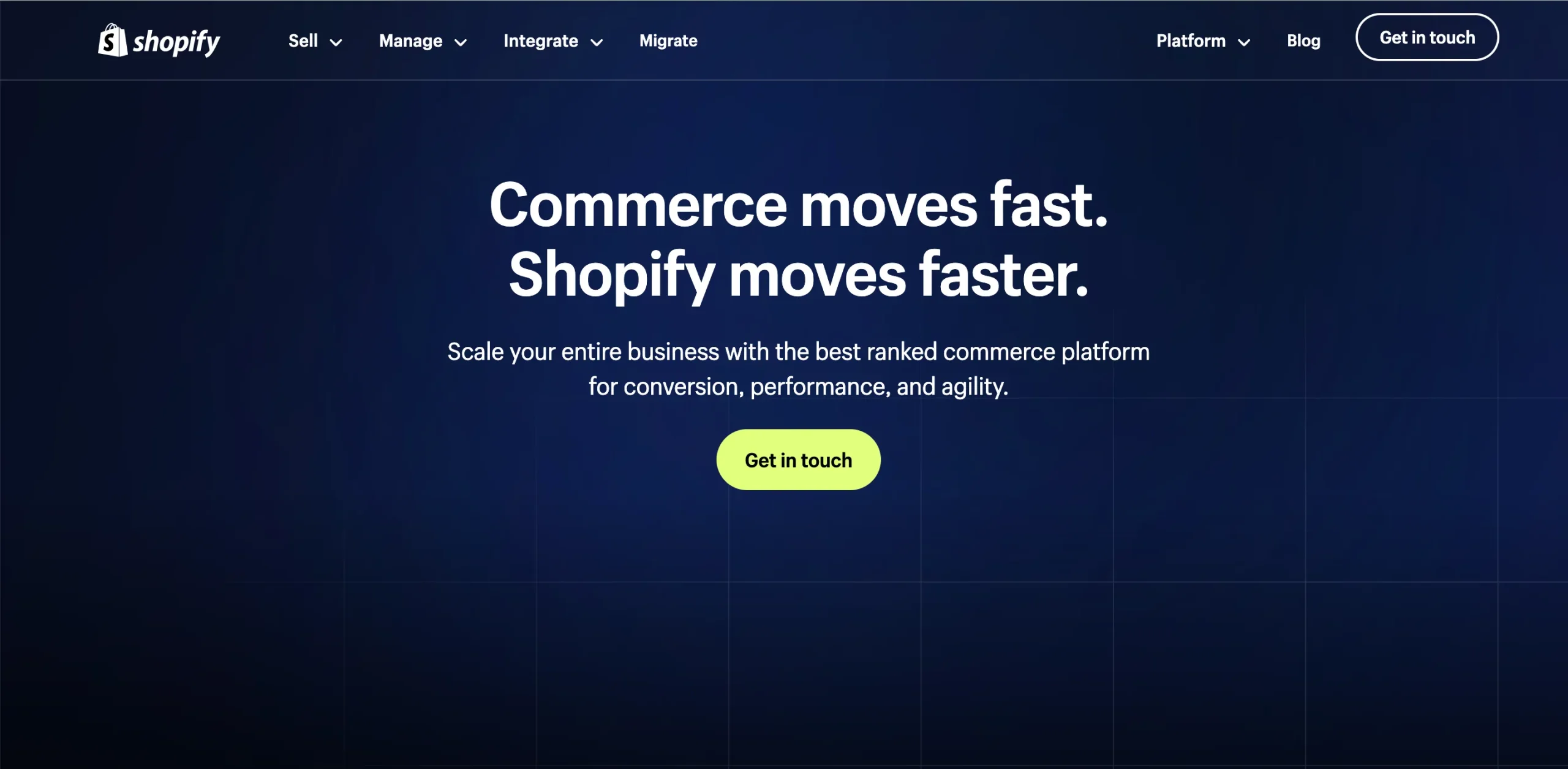
The platform is particularly well-suited for businesses in eCommerce, retail, and fashion, where multi-channel selling and seamless customer experiences are critical. Shopify Plus allows businesses to manage orders from various sales channels—such as online stores, physical retail locations, social media, and marketplaces—under one unified system. With powerful automation capabilities, Shopify Plus is designed to handle complex fulfillment workflows while maintaining simplicity, making it an ideal choice for businesses looking to grow and scale.
Key Features
Shopify Plus provides a suite of features that make it an excellent choice for businesses looking to optimize their omnichannel order management processes. Some of the standout features include a unified dashboard, real-time inventory updates, multi-channel sales tracking, and automation for shipping and fulfillment.
- Unified dashboard: Shopify Plus offers a single, easy-to-use dashboard where businesses can manage their entire operation, including orders, inventory, and sales across all channels. This unified approach simplifies order management by providing real-time insights into sales performance and inventory status, making it easier for businesses to keep track of their operations without the need for multiple systems.
- Real-time inventory updates: Keeping track of inventory across multiple channels is essential for any business engaged in omnichannel order management. Shopify Plus provides real-time inventory updates, ensuring that stock levels are synchronized across online stores, physical retail locations, and other sales platforms. This feature helps businesses avoid overselling, stockouts, and other inventory-related issues, allowing for better inventory control and a more seamless customer experience.
- Multi-channel sales tracking: Shopify Plus supports multi-channel sales tracking, allowing businesses to monitor sales across their online stores, in-store point-of-sale (POS) systems, mobile apps, and third-party platforms like Amazon and eBay. This comprehensive tracking system ensures that businesses have a clear view of their sales performance across all channels, helping them make data-driven decisions about inventory management and marketing strategies.
- Shipping and fulfillment automation: One of Shopify Plus’s most valuable features is its ability to automate the shipping and fulfillment process. Businesses can set up workflows that automatically route orders to the nearest fulfillment center, generate shipping labels, and update customers on the status of their orders. The platform integrates with popular shipping carriers, providing real-time shipping rates and tracking information to ensure fast and accurate deliveries. This automation not only saves time but also improves the overall efficiency of the order fulfillment process.
Benefits
Shopify Plus offers several key benefits that make it an attractive option for businesses looking to streamline their omnichannel order management processes.
- Seamless integration with multiple sales channels: Shopify Plus integrates seamlessly with a wide range of sales channels, from eCommerce stores and physical retail locations to social media platforms and online marketplaces. This flexibility allows businesses to reach customers wherever they shop while managing all orders, inventory, and fulfillment from a single platform. The ability to manage multi-channel operations under one system simplifies order management and ensures consistency across all touchpoints.
- Support for BOPIS (Buy Online, Pick Up In-Store): As customer expectations evolve, many businesses are adopting BOPIS to offer greater convenience. Shopify Plus supports BOPIS, allowing customers to order products online and pick them up in-store. This feature not only enhances the customer experience by providing flexible fulfillment options but also drives additional foot traffic to physical stores, increasing the potential for in-store sales.
- Robust customization: Shopify Plus offers extensive customization options, allowing businesses to tailor their order management workflows to fit their specific needs. Whether it’s customizing the checkout experience, automating specific fulfillment tasks, or integrating with third-party apps, Shopify Plus provides the flexibility to adapt to any business model. This level of customization ensures that businesses can scale their operations without being constrained by rigid systems.
Target Industries
Shopify Plus is particularly well-suited for businesses in eCommerce, retail, and fashion industries. These sectors require flexible and scalable solutions to manage multi-channel sales, streamline inventory management, and deliver a seamless customer experience across both online and physical store environments.
- eCommerce: For pure-play eCommerce businesses, Shopify Plus provides the tools necessary to manage high order volumes, automate fulfillment, and optimize the customer experience. The platform’s integration with popular marketing and sales tools ensures that businesses can reach a wider audience while maintaining efficient operations.
- Retail: Brick-and-mortar retailers looking to expand into the online space or adopt an omnichannel approach will find Shopify Plus’s integration between POS systems and online stores particularly beneficial. The platform’s real-time inventory management and support for BOPIS make it easy to provide a seamless experience for customers shopping both in-store and online.
- Fashion: The fashion industry often deals with high order volumes, seasonal sales spikes, and the need for fast fulfillment. Shopify Plus helps fashion brands streamline their order management, ensuring that inventory is up-to-date across all channels and that orders are processed and fulfilled quickly. Additionally, the platform’s robust customization options allow fashion brands to create a unique shopping experience that reflects their brand identity.
Suitable For
Shopify Plus is ideal for mid-sized to large businesses with high order volumes and complex omnichannel operations. It is particularly well-suited for businesses that are scaling rapidly or expanding into new sales channels. The platform’s flexibility and automation features make it a good fit for businesses looking to streamline their operations without sacrificing the ability to customize workflows and customer experiences. Smaller businesses may find Shopify Plus’s features to be more than they need, but for businesses looking to grow, the platform provides the scalability and support required to manage increasing complexity.
Pricing
Shopify Plus operates on a customized pricing model based on the specific needs of the business, starting at around $2,000 per month. The exact cost can vary depending on factors such as order volume, sales channels, and the level of customization required. Businesses with higher order volumes or those that need extensive customization may see additional costs for implementation and integrations.
While the initial investment may be higher than standard Shopify plans, Shopify Plus’s advanced features—such as automation, multi-channel management, and real-time inventory updates—make it a cost-effective solution for businesses that require a scalable platform. For enterprises with significant growth potential, the return on investment is substantial, as Shopify Plus helps optimize order management, reduce manual processes, and improve the overall customer experience.
Case Study: Gymshark
Gymshark, a fitness apparel and accessories brand, experienced rapid growth and needed a scalable solution to manage orders across its expanding eCommerce business and physical retail presence. As their brand grew, they faced challenges in managing high order volumes, keeping inventory synchronized across all channels, and delivering a consistent customer experience online and in-store.
Gymshark adopted Shopify Plus to manage their omnichannel order management processes. The platform provided them with a unified dashboard to track orders, manage inventory in real-time, and automate fulfillment workflows. Shopify Plus’s support for BOPIS (Buy Online, Pick Up In-Store) allowed Gymshark to offer a flexible fulfillment option for customers, which aligned with their expanding retail presence. The integration of multi-channel sales tracking also gave Gymshark better visibility into sales performance across their website, mobile app, and physical stores.
With Shopify Plus, Gymshark achieved streamlined order processing and faster delivery times, significantly improving their ability to meet growing customer demand. The platform’s automation features reduced manual intervention in the fulfillment process, resulting in fewer errors and improved accuracy. Additionally, Gymshark was able to offer a consistent customer experience across both their online and offline channels, ensuring that customers enjoyed the same level of service regardless of where they shopped. Shopify Plus allowed Gymshark to scale efficiently and continue expanding their operations while maintaining operational excellence.
Brightpearl
Brightpearl is a leading omnichannel order management system designed specifically for retailers, wholesalers, and eCommerce businesses. As a cloud-based platform, Brightpearl offers a fully integrated solution for managing orders, inventory, and customers, streamlining the entire fulfillment process. Built with scalability in mind, the system enables businesses to handle increasing order volumes while maintaining efficiency and accuracy across multiple sales channels. Brightpearl is known for its seamless integration with popular eCommerce platforms, point-of-sale (POS) systems, and marketplaces, making it an ideal choice for businesses looking to unify their operations under a single, powerful system.
With its comprehensive suite of tools, Brightpearl is particularly well-suited for businesses that need real-time visibility into their operations, from inventory management to customer relationships. It empowers retailers and wholesalers to manage complex fulfillment processes, automate routine tasks, and gain insights through real-time analytics. Brightpearl’s flexibility and ability to centralize data across various channels make it a top choice for businesses looking to optimize their omnichannel order management and grow sustainably.
Key Features
Brightpearl offers a range of features that cater specifically to the needs of retailers and wholesalers engaged in omnichannel order management. Key features include integrated order, inventory, and customer management, real-time analytics, multi-channel integration, and automation tools, all of which are essential for streamlining operations and improving fulfillment efficiency.
- Integrated order, inventory, and customer management: One of Brightpearl’s core strengths is its ability to unify order, inventory, and customer data across all sales channels. This integrated approach allows businesses to manage everything from a centralized dashboard, reducing the complexity of handling multiple systems. Whether an order comes from an online store, a physical retail location, or a marketplace like Amazon, Brightpearl ensures that all data is synchronized in real time. This integration provides businesses with complete visibility over their operations, ensuring that they can manage orders, track inventory levels, and maintain accurate customer records from a single platform.
- Real-time analytics: Brightpearl’s real-time analytics feature is essential for businesses that need to make data-driven decisions quickly. The platform provides real-time insights into sales performance, order processing times, and inventory turnover, allowing businesses to spot trends, forecast demand, and optimize their operations accordingly. By using real-time data, businesses can respond more effectively to changes in demand, adjust inventory levels, and ensure that they are always meeting customer expectations.
- Multi-channel integration: Brightpearl integrates seamlessly with a variety of sales channels, including major eCommerce platforms (such as Shopify, Magento, and BigCommerce), POS systems, and marketplaces like eBay and Amazon. This multi-channel integration enables businesses to manage orders and inventory from all channels in one place, ensuring that stock levels are updated in real time and orders are processed without delays. Brightpearl also offers integrations with third-party logistics providers, further simplifying the fulfillment process.
- Automation tools: Automation is a key feature of Brightpearl’s omnichannel order management solution. The platform allows businesses to automate repetitive tasks such as order routing, invoicing, and inventory replenishment. These automation tools help reduce manual labor, minimize the risk of errors, and improve overall efficiency in the fulfillment process. For example, businesses can set up automated workflows to route orders to the nearest fulfillment center based on stock availability and proximity to the customer, ensuring faster delivery times and lower shipping costs.
Benefits
Brightpearl offers a range of benefits that make it an ideal solution for retailers, wholesalers, and eCommerce businesses. The platform is specifically designed to meet the needs of these industries, providing tailored solutions that help streamline order processing and improve fulfillment efficiency.
One of the primary benefits of Brightpearl is its ability to centralize and automate complex operations, enabling businesses to handle high order volumes with ease. By integrating order, inventory, and customer management into a single system, Brightpearl eliminates the need for businesses to juggle multiple platforms, reducing the risk of errors and delays. This not only improves operational efficiency but also enhances the customer experience, as orders are processed and fulfilled more quickly and accurately.
In addition, Brightpearl’s real-time analytics give businesses the insights they need to optimize their operations. Whether it’s identifying underperforming products, forecasting demand, or tracking order fulfillment times, businesses can use these insights to make smarter, data-driven decisions. This helps retailers and wholesalers reduce costs, avoid stockouts, and ensure that they always have the right products in stock to meet customer demand.
Brightpearl’s automation tools further enhance efficiency by eliminating manual processes that can slow down operations. With automated workflows for tasks like order routing, invoicing, and inventory replenishment, businesses can ensure that their operations run smoothly without constant manual intervention. This level of automation is particularly valuable for businesses experiencing rapid growth, as it allows them to scale their operations without a corresponding increase in overhead.
Target Industries
Brightpearl is particularly well-suited for businesses in retail, wholesale, and eCommerce industries. The platform’s omnichannel order management capabilities and real-time data integration make it an ideal choice for businesses operating across multiple sales channels and fulfillment locations.
- Retail: For retailers managing both online and offline sales, Brightpearl provides the tools necessary to manage inventory, process orders, and offer seamless customer experiences. Its integration with POS systems and eCommerce platforms allows retailers to synchronize inventory across stores and online channels, ensuring that stock levels are always accurate.
- Wholesale: Brightpearl is an excellent solution for wholesalers managing large order volumes and multiple distribution channels. Its centralized system allows wholesalers to track inventory across warehouses, process bulk orders efficiently, and automate invoicing and payments. Brightpearl’s real-time analytics also help wholesalers forecast demand and optimize stock levels, ensuring they can meet customer needs without overstocking.
- eCommerce: For pure-play eCommerce businesses, Brightpearl’s integration with major platforms like Shopify, Magento, and BigCommerce simplifies order management and inventory tracking across multiple online stores. Its multi-channel integration ensures that businesses can manage all their sales platforms from one system, improving efficiency and reducing errors.
Suitable For
Brightpearl is suitable for mid-sized to large retailers, wholesalers, and eCommerce businesses that are looking to scale their operations while maintaining control over complex order fulfillment processes. The platform is particularly well-suited for businesses that operate across multiple sales channels and fulfillment centers, as it provides the necessary tools to manage high order volumes and streamline operations efficiently. Small businesses with simpler needs may find Brightpearl’s advanced features more than they require, but for businesses experiencing growth or managing a large, multi-channel operation, Brightpearl offers the scalability and flexibility needed to succeed.
Pricing
Brightpearl operates on a custom pricing model, tailored to the specific needs of each business. The pricing depends on factors such as the number of users, the volume of transactions, and the level of customization required. Typically, businesses can expect to pay a monthly subscription fee, which covers access to the platform’s core features, integrations, and support. Additional costs may arise for implementation services, custom workflows, and advanced integrations with third-party systems.
Given its enterprise-level capabilities, Brightpearl’s pricing is more suitable for mid-sized and larger businesses that need a robust solution for managing their omnichannel operations. While the platform represents a significant investment, the return on investment (ROI) is substantial for businesses looking to improve efficiency, reduce manual labor, and scale their operations. Businesses should contact Brightpearl directly for a tailored pricing quote based on their specific requirements.
Case Study: LeMieux
LeMieux, a fast-growing equestrian brand, faced significant challenges managing orders from multiple platforms and maintaining accurate stock levels across several locations. As the company expanded, it needed an omnichannel order management solution that could handle orders from both its eCommerce store and wholesale operations, while ensuring inventory was synchronized across all sales channels.
LeMieux adopted Brightpearl as its centralized order management system. The platform provided LeMieux with a unified system for managing multi-channel orders, inventory, and customer data. With Brightpearl’s real-time inventory updates and automation tools, LeMieux was able to streamline its order processing and ensure that stock levels were always up to date across its various sales channels. Brightpearl’s integration with LeMieux’s eCommerce and wholesale platforms also enabled the company to manage its customer relationships more effectively, improving both order accuracy and customer satisfaction.
By implementing Brightpearl, LeMieux improved its order accuracy and reduced fulfillment times, allowing the company to scale its operations while maintaining high levels of customer satisfaction. The platform’s real-time analytics provided LeMieux with valuable insights into sales trends and inventory performance, helping the company optimize its stock levels and reduce waste. As a result, LeMieux was able to grow its business more efficiently and continue expanding into new markets without compromising on service quality.
Odoo
Odoo is a powerful and highly flexible enterprise resource planning (ERP) system that offers a complete suite of applications, including omnichannel order management. What sets Odoo apart is its modular approach, allowing businesses to choose and integrate the specific modules they need, such as order processing, inventory management, and CRM. Its open-source nature provides endless customization opportunities, making it one of the most adaptable systems for companies looking to build a solution tailored to their unique operational requirements.
Odoo’s versatility makes it suitable for businesses across a variety of industries, from manufacturing and retail to service-based organizations. The platform supports multi-channel sales by integrating both online and in-store operations, ensuring that businesses have a single source of truth for orders, inventory, and customer data. Its ability to scale with growing business needs, along with comprehensive real-time data and reporting capabilities, makes Odoo an attractive option for businesses looking for an all-in-one omnichannel order management solution.
Key Features
Odoo is packed with features that make it a powerful omnichannel order management system. The following key features demonstrate Odoo’s ability to streamline order processing and improve operational efficiency for businesses with complex omnichannel needs.
- Omnichannel order processing: Odoo’s order management system allows businesses to process orders from multiple sales channels—online stores, in-store point-of-sale (POS) systems, and marketplaces—through a centralized platform. This ensures that orders are processed efficiently regardless of the sales channel, reducing manual intervention and the risk of errors. The unified system also ensures that businesses can track all customer orders in real time, providing complete visibility and control over the entire order lifecycle.
- Real-time inventory management: Odoo provides real-time visibility into inventory levels across all locations, whether in warehouses, retail stores, or distribution centers. This feature is essential for managing stock levels accurately, preventing stockouts, and ensuring that businesses can fulfill orders without delays. Odoo’s inventory management system automatically updates stock levels as orders are placed, returned, or fulfilled, making it easy to maintain accurate inventory records across all channels.
- Multi-channel sales (online, in-store): Odoo supports the integration of multiple sales channels, including eCommerce platforms and in-store POS systems, allowing businesses to seamlessly manage orders from various touchpoints. Whether a customer makes a purchase online, in-store, or through a marketplace, Odoo consolidates all orders into a single platform, ensuring that businesses can manage sales and customer data efficiently. This multi-channel capability enables businesses to provide a consistent customer experience across all platforms.
- Shipping integrations: Odoo integrates with major shipping carriers, allowing businesses to automate the shipping process, including label generation, tracking, and real-time shipping rate calculations. By connecting with carriers directly, Odoo enables businesses to streamline their fulfillment processes, reducing the time spent manually managing shipping logistics. This feature ensures faster order fulfillment and improves customer satisfaction by providing accurate shipping information and timely deliveries.
- Returns management: Handling returns efficiently is critical for maintaining customer satisfaction in an omnichannel environment. Odoo’s returns management system allows businesses to process returns quickly, whether customers return items purchased online or in-store. The platform provides a simple workflow for managing returns, updating inventory, and processing refunds or exchanges. This streamlined process ensures that returned products are quickly re-integrated into inventory, reducing losses and improving operational efficiency.
Benefits
One of Odoo’s most significant advantages is its modular architecture, which allows businesses to customize the platform to meet their specific needs. With over 30 core applications and more than 16,000 third-party apps available through the Odoo marketplace, businesses can choose only the modules that are most relevant to their operations. This modularity makes Odoo a flexible and cost-effective solution, as businesses can expand the system as their needs grow without paying for unnecessary features.
Odoo’s open-source nature is another key benefit, offering unmatched flexibility for customization. Businesses with in-house developers or access to third-party developers can tailor Odoo to suit their unique requirements, whether it involves modifying workflows, integrating with other systems, or building custom modules. This flexibility makes Odoo an ideal solution for businesses that have complex operational needs or those looking for a scalable system that can evolve as they grow.
In addition, Odoo’s scalability ensures that businesses can continue using the platform as they expand. Whether a company is growing its eCommerce presence, adding new retail locations, or increasing its product lines, Odoo can accommodate these changes by simply adding the necessary modules or customizations. This scalability, combined with the ability to automate routine tasks, helps businesses reduce manual labor and optimize operations, allowing them to scale efficiently.
Target Industries
Odoo is highly versatile, making it suitable for a wide range of industries, particularly manufacturing, retail, and service industries.
- Manufacturing: Odoo offers a comprehensive set of tools for manufacturers, including production planning, bill of materials management, and inventory tracking. These features, combined with omnichannel order management, enable manufacturers to manage production workflows while ensuring that customer orders are fulfilled efficiently.
- Retail: Retailers benefit from Odoo’s integrated POS systems, inventory management, and omnichannel order processing. The platform allows retailers to manage sales across both online and offline channels, ensuring that inventory is synchronized and that orders are processed seamlessly across all touchpoints.
- Service industries: Service-based businesses can use Odoo to manage customer relationships, sales, and project management, while also benefiting from the platform’s omnichannel capabilities for handling customer orders and service requests. The flexibility of Odoo’s modular system makes it easy to tailor the platform to meet the specific needs of service-oriented businesses.
Suitable For
Odoo is suitable for small, medium, and large businesses that require a flexible and scalable system to manage complex operations across multiple channels. The platform is particularly well-suited for businesses that have specific customization needs, such as those in manufacturing or retail, as Odoo’s open-source nature allows for extensive tailoring.
Small businesses can start with a basic set of modules and gradually add more features as their needs grow, while larger businesses with more complex operations can take advantage of Odoo’s robust functionality to manage high order volumes and multiple sales channels efficiently.
Pricing
Odoo’s pricing is highly flexible, as it operates on a per-module, per-user subscription model. Businesses can choose only the modules they need, which helps control costs. Odoo offers a free Community version, which includes basic features and is ideal for small businesses or those with minimal customization needs. For more advanced functionality, businesses can opt for the Enterprise version, which starts at around $24 per user, per month.
Customization and implementation costs vary depending on the complexity of the business’s requirements. While the base price for modules is relatively affordable, businesses looking for extensive customization or integration with other systems may incur additional development costs. Overall, Odoo’s pricing structure is highly competitive for businesses that need a scalable and customizable omnichannel order management solution, especially compared to more rigid, off-the-shelf platforms.
Case Study: Toyota
Toyota Material Handling France is a member of the Toyota Industries Corporation, which operates in 5 regions in the material handling industry. Toyota Material Handling faced issues with managing their complex distribution network and highly customizable trucks, which represent 40% of their business. Their old, custom-built system was inefficient and difficult to maintain, especially for the factory in Italy, where the system could not handle order processing, production, or shipments effectively.
After exploring alternatives, Toyota chose Odoo ERP, implemented by Smile, an official Odoo partner. Odoo’s modular, out-of-the-box solution provided a flexible, cost-effective system that streamlined operations without the need for a full ERP, offering quick implementation and ROI.
In just six months, Toyota Material Handling fully integrated Odoo into their operations, benefiting from lower maintenance costs, faster implementation, and continuous feature upgrades. The open nature of Odoo also allowed Toyota’s in-house IT team to develop custom features, adding long-term value to the company. With Odoo, Toyota is gradually moving towards consolidating all operations on a single platform, improving overall efficiency.
Oracle Order Management Cloud
Oracle Order Management Cloud is a leading solution designed to manage the complexities of omnichannel order management for large enterprises, B2B businesses, and companies with supply chain-heavy operations. As part of Oracle’s suite of cloud-based applications, this system integrates advanced order processing capabilities with powerful analytics, real-time visibility, and automated workflows to streamline the entire order lifecycle from capture to fulfillment.
Oracle Order Management Cloud is built to address the challenges of modern, complex supply chains by offering tools that ensure order accuracy, enhance customer satisfaction, and enable businesses to meet increasingly demanding customer expectations. It excels at handling high-volume, multi-channel orders, automating intricate workflows, and optimizing fulfillment across diverse geographic regions. The system is designed for businesses that operate on a global scale, providing capabilities that allow for seamless collaboration and order orchestration between multiple entities, distribution centers, and third-party logistics providers.
Key Features
Oracle Order Management Cloud is equipped with a wide range of features designed to support businesses with complex, high-volume omnichannel operations. The following key features highlight Oracle’s capabilities in optimizing order management processes:
- Advanced order orchestration: Oracle Order Management Cloud’s advanced order orchestration capabilities allow businesses to automate and optimize every step of the order fulfillment process. By using configurable business rules, businesses can control how orders are processed, routed, and fulfilled across multiple channels. This flexibility ensures that the most efficient and cost-effective fulfillment paths are selected, taking into account factors like inventory availability, customer location, and shipping costs. This orchestration helps businesses minimize manual intervention, reduce fulfillment errors, and ensure orders are delivered on time.
- Real-time order status: Providing customers with real-time updates on the status of their orders is critical in today’s fast-paced retail and B2B environments. Oracle Order Management Cloud offers real-time visibility into every stage of the order process, from order capture to shipping and delivery. Businesses can track order statuses across channels, allowing them to promptly address any potential issues that may arise. This transparency helps improve customer satisfaction by keeping customers informed and reducing the likelihood of missed or delayed orders.
- Multi-channel order capture: Oracle supports multi-channel order capture, enabling businesses to take orders from various sources, including eCommerce platforms, retail stores, mobile applications, and call centers. This capability ensures that businesses can manage all incoming orders from a single platform, regardless of the sales channel. The system integrates with a wide range of front-end systems, ensuring that orders are captured accurately and processed efficiently across all touchpoints.
- Global order promising: One of Oracle Order Management Cloud’s standout features is its global order promising (GOP) functionality, which allows businesses to offer accurate delivery dates and fulfillment options across all sales channels. GOP takes into account factors such as real-time inventory availability, supply chain constraints, shipping schedules, and customer locations to provide realistic delivery timeframes. This feature not only improves customer satisfaction by setting accurate expectations but also optimizes fulfillment by routing orders to the most appropriate warehouses or distribution centers.
Benefits
Oracle Order Management Cloud offers several key benefits that make it an ideal solution for large enterprises and businesses that require advanced omnichannel order management capabilities:
- Comprehensive order management: Oracle Order Management Cloud is designed to handle complex and high-volume orders with ease. Its powerful orchestration tools allow businesses to automate and streamline their order fulfillment processes, reducing manual labor and improving efficiency. The system’s ability to manage orders across multiple channels ensures that businesses can maintain a consistent and seamless customer experience, regardless of where the order originates.
- Improved accuracy: One of the primary benefits of Oracle Order Management Cloud is its focus on improving order accuracy. By automating order processing and incorporating real-time data from multiple systems, businesses can reduce the likelihood of errors, such as incorrect shipments or missed delivery windows. This accuracy is critical for maintaining customer satisfaction and minimizing costly returns or re-shipments.
- Enhanced customer satisfaction: Oracle’s robust features, such as real-time order tracking and global order promising, contribute to higher levels of customer satisfaction. By providing customers with accurate delivery timelines and keeping them informed throughout the fulfillment process, businesses can build trust and loyalty. Additionally, Oracle’s ability to handle large volumes of orders without compromising speed or accuracy helps businesses meet customer expectations even during peak seasons.
- Scalability: Oracle Order Management Cloud is built for large-scale businesses, making it highly scalable to accommodate growth. Whether a business is expanding its geographic footprint or adding new sales channels, Oracle’s flexible cloud infrastructure and customizable workflows can support this growth without sacrificing performance or efficiency.
Target Industries
Oracle Order Management Cloud is particularly well-suited for large enterprises, B2B companies, and supply chain-heavy businesses. These industries often deal with complex order processes, high volumes of transactions, and multiple fulfillment locations, all of which can be efficiently managed through Oracle’s advanced order management capabilities.
- Large enterprises: For companies operating on a global scale with multiple distribution centers, warehouses, and sales channels, Oracle provides the tools necessary to manage orders efficiently across regions. Its global order promising and advanced orchestration features are designed to handle the complexity of large-scale operations.
- B2B businesses: Oracle Order Management Cloud is ideal for B2B businesses that need to manage intricate order processes, such as custom configurations, volume orders, and long-term contracts. The platform supports integration with back-end systems like ERP and CRM, allowing businesses to manage customer relationships and order fulfillment seamlessly.
- Supply chain-heavy businesses: Companies with complex supply chains benefit from Oracle’s ability to track inventory in real time, manage multi-location fulfillment, and optimize the order routing process. The system’s integration with other Oracle supply chain management tools ensures that businesses can maintain visibility and control over every aspect of their logistics operations.
Suitable For
Oracle Order Management Cloud is most suitable for large enterprises and B2B companies that need a highly scalable and customizable order management system capable of handling complex, multi-channel operations. It is particularly well-suited for businesses with global supply chains or those managing high volumes of orders across multiple regions and fulfillment locations. Companies that need to coordinate complex workflows, track real-time data across various systems, and ensure accurate order fulfillment will find Oracle’s advanced tools beneficial for streamlining their operations.
Smaller businesses with simpler order management needs may find Oracle’s robust capabilities more than they require. However, for larger organizations or those with intricate supply chains, Oracle Order Management Cloud provides the flexibility and scalability to grow with their business.
Pricing
Oracle Order Management Cloud operates on a subscription-based pricing model, with costs varying based on the size of the business, the number of users, and the specific modules required. Oracle typically offers custom pricing packages for its enterprise solutions, which can include a combination of order management, supply chain management, and other Oracle Cloud applications.
Businesses can expect implementation costs to be significant, especially for larger enterprises with complex workflows that require customization and integration with other systems. Oracle also offers additional pricing for advanced features such as global order promising, AI-driven automation, and machine learning capabilities.
While Oracle’s pricing is on the higher end of the spectrum, the platform’s extensive features and ability to handle complex, global operations make it a worthwhile investment for large-scale businesses. The system’s potential for delivering a high return on investment (ROI) through improved efficiency, reduced errors, and enhanced customer satisfaction makes it a strategic choice for businesses that need advanced omnichannel order management capabilities.
Case Study: Alcar
Alcar, a global leader in the production of steel and alloy wheels, needed to modernize its order management and supply chain processes. As the company grew, its top priority was to implement a more flexible and efficient system for planning and managing orders across its global operations.
Alcar adopted Oracle IoT (Internet of Things) technology integrated with Oracle Order Management Cloud to transform its operations. The system’s embedded AI capabilities enabled Alcar to analyze sensor data from its production lines, identify trends, predict potential failures, and take proactive measures to avoid disruptions. With Oracle’s global order promising and real-time analytics, Alcar was able to improve its planning processes, optimize inventory management, and ensure timely order fulfillment.
By implementing Oracle Order Management Cloud, Alcar significantly reduced downtime and enhanced its maintenance processes. The company achieved improved order accuracy, faster fulfillment times, and greater operational flexibility, allowing it to meet customer demands more efficiently. The integration of AI-driven insights and real-time order data helped Alcar streamline its supply chain, reduce costs, and improve customer satisfaction.
Salesforce Order Management
Salesforce Order Management is part of the Salesforce Commerce Cloud suite, designed to offer businesses a comprehensive solution for managing the entire order lifecycle, from capture to fulfillment, across multiple channels. Known for its seamless integration with Salesforce CRM, Salesforce Order Management allows businesses to leverage deep customer insights to provide a personalized and consistent shopping experience across all touchpoints. This powerful platform is ideal for companies looking to unify their customer data, sales channels, and order management processes within a single system, streamlining operations and enhancing customer satisfaction.
Salesforce Order Management is particularly well-suited for businesses operating in retail, eCommerce, and B2B industries, where managing large volumes of orders across various channels is a critical challenge. By combining order management with Salesforce’s industry-leading CRM capabilities, businesses can ensure that customer interactions are aligned with their order processes, enabling greater transparency and a more cohesive experience across both digital and physical touchpoints.
Key Features
Salesforce Order Management comes with a robust set of features that enhance the efficiency of omnichannel order management. These key features provide businesses with the tools needed to streamline order processing, manage inventory across multiple channels, and deliver a seamless customer experience:
- Seamless integration with Salesforce CRM: One of the standout features of Salesforce Order Management is its deep integration with Salesforce CRM. This connection allows businesses to link order management with customer data, providing a more personalized experience across all customer touchpoints. Every order can be associated with customer preferences, history, and profiles, allowing businesses to offer targeted recommendations, promotions, and services. This ensures a consistent and unified customer journey, whether the order is placed online, in-store, or through another channel.
- Centralized order management: Salesforce Order Management enables businesses to manage all of their orders from a centralized platform, regardless of the sales channel. Whether an order is placed via a company’s website, mobile app, in-store POS system, or third-party marketplace, the platform consolidates these orders into a single view. This centralization helps businesses maintain accurate order tracking, inventory management, and fulfillment across multiple sales platforms, eliminating the need for disparate systems and ensuring smooth operational workflows.
- Multi-channel order capture: In an omnichannel environment, capturing and managing orders from multiple channels is essential for delivering a seamless shopping experience. Salesforce Order Management supports multi-channel order capture, ensuring that businesses can process orders from a variety of sources, including eCommerce platforms, social media, in-store, and call centers. The platform’s ability to unify orders from these different channels into a single system allows for better order tracking and coordination across the entire business.
- Automation for fulfillment processes: To enhance efficiency, Salesforce Order Management offers automation capabilities for key fulfillment processes. This includes automatic order routing, real-time inventory updates, and shipping integrations. Businesses can automate routine tasks such as sending order confirmations, processing payments, and generating shipping labels, which reduces the need for manual intervention and minimizes the chances of errors. By automating these processes, businesses can ensure faster order fulfillment and improved accuracy in managing high volumes of orders.
Benefits
Salesforce Order Management provides a range of benefits that make it an attractive solution for businesses looking to streamline their omnichannel order management while delivering a better customer experience. Some of the key benefits include:
- Consistent customer experience: One of the most significant advantages of Salesforce Order Management is its ability to integrate deeply with Salesforce CRM, allowing businesses to deliver a consistent and personalized customer experience across all touchpoints. By having a unified view of each customer’s order history, preferences, and interactions, businesses can provide tailored recommendations, cross-sell opportunities, and personalized communications, whether the customer is shopping online or in-store. This level of personalization improves customer satisfaction and fosters greater loyalty.
- Enhanced reporting and analytics: Salesforce Order Management includes robust reporting and analytics capabilities, giving businesses valuable insights into their order fulfillment processes, customer behavior, and sales performance. By using real-time data and comprehensive reports, businesses can track key metrics such as order processing times, fulfillment rates, and inventory turnover. These insights help businesses optimize their operations, identify areas for improvement, and make data-driven decisions that enhance the overall efficiency of their order management processes.
- Scalable and flexible: Salesforce Order Management is designed to scale with businesses as they grow. Whether a business is managing hundreds or thousands of orders per day, the platform can handle increasing volumes without sacrificing performance or accuracy. Its flexible architecture allows businesses to customize workflows and integrate with other Salesforce tools, such as Marketing Cloud and Service Cloud, to create a fully tailored solution that meets their unique needs.
- Improved fulfillment accuracy and speed: With automation features such as order routing, real-time inventory updates, and shipping integrations, Salesforce Order Management helps businesses reduce fulfillment times and improve accuracy. These automation tools ensure that orders are processed quickly and efficiently, leading to faster deliveries and fewer errors. This, in turn, enhances customer satisfaction by ensuring that orders are fulfilled on time and as expected.
Target Industries
Salesforce Order Management is particularly well-suited for retail, eCommerce, and B2B industries, where managing large order volumes and maintaining a consistent customer experience across channels are essential. These industries can take advantage of Salesforce’s deep customer data integration, robust automation tools, and multi-channel capabilities to streamline their order management processes and improve overall operational efficiency.
- Retail: Salesforce Order Management helps retailers manage orders from both online and brick-and-mortar stores, providing a single platform to track customer purchases, process returns, and fulfill orders. The platform’s integration with Salesforce CRM also enables retailers to personalize interactions with customers, improving loyalty and retention.
- eCommerce: For eCommerce businesses, Salesforce Order Management offers multi-channel support, enabling them to capture and fulfill orders from websites, mobile apps, and third-party marketplaces. The platform’s real-time inventory tracking and automation tools ensure that eCommerce businesses can process high order volumes without compromising speed or accuracy.
- B2B: B2B companies benefit from Salesforce Order Management’s ability to handle complex order workflows, such as bulk orders, custom pricing, and long-term contracts. The platform’s integration with Salesforce CRM allows B2B businesses to manage customer relationships more effectively, while its advanced order management tools ensure that orders are fulfilled accurately and on time.
Suitable For
Salesforce Order Management is suitable for mid-sized to large businesses that require a centralized and scalable platform to manage complex omnichannel order processes. It is particularly beneficial for businesses that already use Salesforce CRM, as the integration between order management and customer data creates a more cohesive and efficient system. Salesforce Order Management is ideal for businesses that need to capture and fulfill orders from multiple channels while providing a consistent and personalized customer experience.
Smaller businesses with simpler order management needs may find the platform’s extensive features to be more than necessary. However, for businesses with high order volumes, multiple sales channels, and a focus on customer relationships, Salesforce Order Management provides a comprehensive solution that can scale with their growth.
Pricing
Salesforce Order Management operates on a subscription-based pricing model, with costs varying depending on the number of users, the volume of transactions, and the specific features required. Pricing is typically customized based on the needs of the business, and businesses should expect higher costs for more advanced features such as automation, real-time analytics, and multi-channel integrations.
While Salesforce Order Management’s pricing is on the higher end, especially when combined with Salesforce CRM, its robust capabilities and ability to unify customer data with order processes offer significant value for businesses looking to improve their omnichannel operations. Businesses should contact Salesforce directly for a customized quote based on their specific requirements.
Case Study: L’Oreal
As one of the world’s leading beauty and cosmetics brands, L’Oreal needed an omnichannel order management solution to manage customer orders from both online and offline channels while ensuring a consistent and seamless experience across all touchpoints. The company faced challenges in integrating its growing eCommerce presence with its traditional retail operations and needed a platform that could centralize order data while providing real-time visibility.
L’Oreal implemented Salesforce Order Management to streamline its order processing across all sales channels. By integrating Salesforce CRM with its order management system, L’Oreal was able to unify customer data, providing personalized experiences based on each customer’s purchase history and preferences. The platform’s automation tools enabled L’Oreal to speed up order fulfillment, reducing processing times and ensuring that orders were routed to the correct fulfillment centers.
With Salesforce Order Management, L’Oreal saw a significant reduction in order processing times, which led to faster deliveries and improved customer satisfaction. The company also benefited from greater visibility into its inventory levels, allowing it to optimize stock management and prevent stockouts. By delivering a seamless customer experience across both online and offline channels, L’Oreal increased customer loyalty and retention, ultimately driving long-term business growth.
Kibo Order Management
Kibo Order Management is a leading platform designed to optimize omnichannel order management by providing real-time visibility into inventory and orders, dynamic order routing, and flexible fulfillment options. With a focus on improving fulfillment efficiency and enhancing customer satisfaction, Kibo supports complex order scenarios, enabling businesses to adapt to changing customer demands and market conditions. The platform’s advanced tools for order orchestration, inventory management, and returns handling make it a comprehensive solution for retailers, eCommerce businesses, and logistics providers looking to streamline their omnichannel operations.
Kibo’s omnichannel capabilities allow businesses to manage orders from multiple sales channels—whether online, in-store, or through third-party marketplaces—ensuring that inventory is synchronized and that customers receive a consistent experience no matter where they make a purchase. As consumer expectations for fast and flexible fulfillment continue to rise, Kibo’s dynamic approach to order routing and real-time inventory visibility empowers businesses to meet these demands while minimizing costs and improving operational efficiency.
Key Features
Kibo Order Management offers a variety of features that support businesses in optimizing their omnichannel order management processes. The platform’s key features include real-time inventory and order visibility, omnichannel fulfillment capabilities, intelligent order routing, and flexible returns management.
- Real-time inventory and order visibility: Kibo provides businesses with real-time visibility into their inventory across all locations, including warehouses, stores, and distribution centers. This real-time data ensures that businesses can accurately manage stock levels, avoid stockouts, and optimize fulfillment decisions based on current inventory availability. With a single view of inventory across all channels, businesses can make informed decisions about where to fulfill orders, reducing the risk of overstocking or understocking.
- Omnichannel fulfillment: Kibo supports a wide range of omnichannel fulfillment options, including ship-from-store, buy online pick up in-store (BOPIS), curbside pickup, and same-day delivery. These options give businesses the flexibility to offer customers multiple ways to receive their orders, improving the overall shopping experience. Kibo’s omnichannel fulfillment capabilities ensure that businesses can seamlessly integrate their online and physical store operations, providing a unified experience for both customers and staff.
- Intelligent order routing: Kibo’s intelligent order routing feature dynamically allocates orders to the best fulfillment location based on factors such as proximity to the customer, stock availability, delivery time, and shipping costs. This dynamic routing helps businesses minimize shipping costs and reduce delivery times, while also ensuring that orders are fulfilled efficiently. Kibo’s routing algorithms consider real-time data to optimize order fulfillment, making it easier for businesses to meet customer expectations for fast, reliable delivery.
- Flexible returns management: Managing returns effectively is crucial for maintaining customer satisfaction, and Kibo’s flexible returns management system allows businesses to streamline the returns process across all sales channels. Customers can return products through any channel—whether they purchased online or in-store—and Kibo ensures that the returned items are processed efficiently, with real-time inventory updates to ensure accurate stock levels. This flexibility simplifies the returns process for both customers and businesses, helping to reduce friction and build customer loyalty.
Benefits
Kibo Order Management offers several key benefits that make it a standout choice for businesses looking to optimize their omnichannel fulfillment processes.
- Dynamic order orchestration: One of the core benefits of Kibo is its ability to provide dynamic order orchestration, which allows businesses to optimize fulfillment decisions based on cost, delivery speed, and customer preferences. Kibo’s intelligent order routing system automatically allocates orders to the most appropriate fulfillment center, considering real-time factors such as inventory availability, shipping costs, and customer location. This dynamic orchestration ensures that businesses can fulfill orders quickly and at the lowest possible cost, while also improving customer satisfaction by meeting delivery expectations.
- Support for complex order scenarios: Kibo is designed to handle a variety of complex order scenarios, making it ideal for businesses with diverse fulfillment needs. Whether businesses are managing large, multi-item orders, split shipments, or orders that require special handling, Kibo’s flexible order management system can accommodate these complexities. This capability is particularly beneficial for retailers and eCommerce businesses that need to manage different types of orders, from direct-to-consumer shipments to wholesale orders, all within the same platform.
- Improved customer satisfaction: Kibo’s focus on enhancing the customer experience through fast, flexible fulfillment options and seamless returns management leads to higher customer satisfaction. By offering multiple fulfillment options and ensuring that orders are delivered on time, Kibo helps businesses meet the growing demands of modern consumers, who expect both convenience and speed. In addition, Kibo’s real-time order tracking and notifications keep customers informed throughout the fulfillment process, building trust and encouraging repeat business.
- Reduced operational costs: By optimizing order routing and fulfillment based on factors such as proximity and shipping costs, Kibo helps businesses reduce their overall operational expenses. The platform’s ability to integrate real-time data into its decision-making process ensures that businesses can allocate orders in the most efficient way possible, reducing unnecessary shipping costs and improving overall profitability.
Target Industries
Kibo Order Management is particularly well-suited for businesses in retail, eCommerce, and logistics, where managing large volumes of orders across multiple sales channels and fulfillment locations is a critical challenge.
- Retail: For retailers with both brick-and-mortar stores and online sales channels, Kibo provides a unified solution for managing orders and inventory across all locations. The platform’s real-time inventory visibility and omnichannel fulfillment capabilities allow retailers to offer customers a seamless shopping experience, whether they are buying online or in-store.
- eCommerce: Kibo is an excellent choice for eCommerce businesses looking to optimize their fulfillment processes. The platform’s dynamic order routing and flexible fulfillment options ensure that eCommerce businesses can meet customer expectations for fast and reliable deliveries, while also managing inventory effectively across multiple warehouses and distribution centers.
- Logistics: Companies in the logistics industry benefit from Kibo’s ability to manage complex order routing and fulfillment across large networks of fulfillment centers. The platform’s real-time data and intelligent order orchestration tools make it easier for logistics providers to optimize their operations, reduce costs, and ensure timely deliveries.
Suitable For
Kibo Order Management is suitable for mid-sized to large businesses that require a robust and scalable omnichannel order management platform. It is particularly beneficial for businesses that operate across multiple sales channels, including both online and physical locations, and need to manage complex order fulfillment scenarios. Kibo’s advanced features, such as dynamic order routing and real-time inventory visibility, make it an ideal choice for businesses looking to optimize their fulfillment processes while reducing costs and improving customer satisfaction.
Smaller businesses may find Kibo’s extensive capabilities more than they need, but for businesses with high order volumes and diverse fulfillment requirements, Kibo provides the flexibility and scalability necessary to support growth.
Pricing
Kibo operates on a custom pricing model, with costs depending on the size of the business, the number of users, and the specific features required. As an enterprise-grade solution, Kibo’s pricing reflects its advanced capabilities, and businesses should expect to pay higher costs compared to more basic order management systems. Kibo’s pricing typically includes a subscription fee, along with additional costs for implementation, customization, and integration with other systems.
While the upfront investment may be higher, Kibo’s ability to optimize fulfillment processes and reduce operational costs provides a strong return on investment (ROI) for businesses looking to scale their operations and improve efficiency. Businesses interested in Kibo should contact the company directly for a detailed pricing quote based on their specific needs and requirements.
Case Study: Office Depot
Office Depot, a leading office supply retailer, needed to optimize its omnichannel fulfillment process across hundreds of locations, while offering customers flexible options such as in-store pickup and delivery. The company faced challenges in managing its vast inventory across multiple fulfillment centers and ensuring that orders were routed efficiently to reduce delivery times and shipping costs.
Office Depot implemented Kibo’s dynamic order routing system to optimize its fulfillment process. Kibo’s platform allowed Office Depot to allocate orders to the nearest fulfillment center based on factors such as inventory availability, customer location, and delivery times. This dynamic routing helped Office Depot ensure that customers could choose between in-store pickup or delivery, with the platform automatically selecting the most efficient fulfillment option for each order.
By using Kibo’s intelligent order routing system, Office Depot improved its overall fulfillment efficiency, resulting in faster deliveries and lower shipping costs. The company was able to provide customers with more flexible fulfillment options, enhancing the overall shopping experience. As a result, Office Depot saw increased customer satisfaction and loyalty, while also reducing its operational expenses related to shipping and fulfillment.
Extensiv
Extensiv (previously known as Skubana) is a robust omnichannel order management platform designed specifically for eCommerce businesses and direct-to-consumer (D2C) brands. As a centralized system, Extensiv helps businesses streamline their order fulfillment by consolidating sales channels, automating recurring tasks, and providing real-time insights into inventory levels. Extensiv’s key strength lies in its ability to manage orders and inventory from multiple sources—including online marketplaces, eCommerce websites, and third-party logistics providers—within a single, easy-to-use platform. This capability makes Extensiv a popular choice for small to medium-sized businesses that need a comprehensive solution to handle the complexity of growing operations across various channels.
By simplifying the omnichannel order management process, Extensiv enables businesses to focus on scaling their operations while maintaining efficiency and reducing operational costs. Its suite of features is designed to optimize every stage of the fulfillment process, from order capture and inventory management to shipping and returns, making it an essential tool for businesses that want to improve their fulfillment performance and deliver better customer experiences.
Key Features
Extensiv offers a variety of powerful features that help eCommerce businesses streamline their omnichannel order management processes. The platform’s key features include multi-channel order management, real-time inventory tracking, shipping management, and automation for recurring tasks.
- Multi-channel order management: One of Extensiv’s core features is its ability to centralize order management across multiple sales channels. Whether a business is selling on Amazon, Shopify, Walmart, or eBay, Extensiv consolidates all orders into a single dashboard, providing businesses with a unified view of their sales activity. This centralized approach ensures that businesses can efficiently manage orders from all channels without the need to switch between different platforms, reducing the risk of errors and improving operational efficiency.
- Real-time inventory tracking: Extensiv’s real-time inventory tracking feature provides businesses with up-to-date insights into their stock levels across all locations. Whether inventory is stored in a warehouse, a third-party logistics (3PL) provider’s facility, or a brick-and-mortar store, Extensiv ensures that businesses always have an accurate view of their available inventory. This real-time visibility helps prevent stockouts and overselling, which can lead to poor customer experiences and missed sales opportunities.
- Shipping management: Extensiv integrates with major shipping carriers to streamline the shipping process. The platform allows businesses to generate shipping labels, track packages, and compare shipping rates from multiple carriers, all within a single system. This integration not only simplifies the shipping process but also ensures that businesses can offer competitive shipping options to customers, reducing shipping costs and improving delivery times.
- Automation for recurring tasks: Extensiv excels at automating repetitive tasks that can bog down eCommerce businesses. From automatic order routing and inventory updates to the generation of purchase orders when stock levels reach a certain threshold, Extensiv helps businesses save time and reduce manual labor. By automating these tasks, businesses can focus on more strategic activities, such as marketing and customer service, while ensuring that their fulfillment operations run smoothly and efficiently.
Benefits
Extensiv offers several key benefits that make it an attractive option for small to medium-sized businesses (SMBs) looking to streamline their omnichannel order management processes. Some of the standout benefits include:
- Ease of use: Extensiv is known for its intuitive user interface, which makes it easy for businesses to manage their orders, inventory, and shipping without requiring extensive technical knowledge. The platform’s centralized dashboard provides businesses with a clear view of their entire operation, allowing them to monitor sales, track inventory, and manage shipping from a single screen. This ease of use is particularly valuable for small to medium-sized businesses that may not have dedicated IT or logistics teams.
- Powerful automation tools: One of Extensiv’s biggest advantages is its automation capabilities. The platform’s ability to automate recurring tasks—such as order routing, inventory replenishment, and shipping label generation—helps businesses save time and reduce human error. By automating these processes, businesses can ensure that orders are fulfilled more quickly and accurately, leading to improved customer satisfaction and fewer fulfillment-related issues.
- Improved fulfillment efficiency: Extensiv’s centralized order management and real-time inventory tracking enable businesses to optimize their fulfillment processes. By having a single source of truth for all orders and inventory data, businesses can make informed decisions about how to allocate stock and fulfill orders from the most appropriate location. This improved efficiency helps reduce fulfillment times, minimize shipping costs, and ensure that customers receive their orders on time.
- Scalability: While Extensiv is ideal for small to medium-sized businesses, it is also built to scale with growing operations. As businesses expand their sales channels and order volumes, Extensiv can accommodate increased demand without sacrificing performance or accuracy. This scalability ensures that businesses can continue using the platform as they grow, making it a long-term solution for omnichannel order management.
Target Industries
Extensiv is particularly well-suited for eCommerce businesses and direct-to-consumer (D2C) brands. These industries often face the challenge of managing large volumes of orders from multiple sales channels while maintaining accurate inventory records and ensuring timely fulfillment.
- eCommerce: For eCommerce businesses selling across multiple platforms—such as Shopify, Amazon, and eBay—Extensiv provides a unified solution for managing orders and inventory. Its multi-channel capabilities allow eCommerce businesses to streamline their operations and prevent issues like overselling or stockouts, which can harm customer satisfaction and sales performance.
- Direct-to-consumer (D2C) brands: D2C brands benefit from Extensiv’s real-time inventory tracking and automation tools, which help them manage fulfillment more efficiently. Whether selling through their own websites or third-party platforms, D2C brands can use Extensiv to centralize order management and ensure that customers receive their products on time and without errors. The platform’s scalability also makes it an ideal solution for D2C brands experiencing rapid growth and increasing order volumes.
Suitable For
Extensiv is suitable for small to medium-sized businesses that require a centralized and scalable platform to manage their omnichannel order fulfillment. The platform is particularly beneficial for businesses that sell through multiple channels and need to automate routine tasks to improve efficiency. Extensiv’s ease of use and powerful automation tools make it an ideal choice for businesses that want to focus on growth while minimizing the complexities of managing orders, inventory, and shipping.
While larger enterprises with more complex fulfillment needs may require additional customization or more advanced features, Extensiv provides all the essential tools that SMBs need to manage their operations efficiently. Its flexibility and scalability ensure that businesses can continue using the platform as they grow, making it a long-term solution for growing eCommerce and D2C brands.
Pricing
Extensiv operates on a subscription-based pricing model, with costs varying depending on the number of users, order volume, and the specific features required. Pricing for Extensiv typically starts around $1.000 per month, making it a competitive option for small to medium-sized businesses looking for a scalable solution to manage their omnichannel order fulfillment.
In addition to the subscription fee, businesses may also incur costs for implementation and integration with other systems, such as third-party logistics providers or accounting software. While the upfront costs may be higher compared to some basic order management platforms, Extensiv’s advanced features and automation capabilities provide a strong return on investment (ROI) for businesses looking to streamline their operations and reduce fulfillment errors.
Case Study: Death Wish Coffee
Death Wish Coffee, a fast-growing direct-to-consumer coffee brand, faced challenges in managing multi-channel sales orders efficiently while scaling their business. As their order volumes increased, Death Wish Coffee needed a centralized system to manage orders from multiple platforms, including their own website and third-party marketplaces. The company also struggled with inventory management, leading to occasional stockouts and overselling, which affected customer satisfaction.
Death Wish Coffee implemented Extensiv to centralize its order management and streamline its fulfillment process. With Extensiv, the company was able to manage orders from all sales channels in a single dashboard, ensuring that inventory levels were synchronized in real-time across all platforms. Extensiv’s automation tools allowed Death Wish Coffee to automate repetitive tasks, such as order routing, inventory updates, and shipping label generation, reducing the time spent on manual processes.
By using Extensiv, Death Wish Coffee significantly improved its fulfillment efficiency and reduced order errors. The company was able to handle peak demand periods more smoothly, ensuring that customers received their orders on time and without issues. Extensiv’s real-time inventory tracking also helped Death Wish Coffee maintain accurate stock levels, preventing stockouts and overselling. As a result, the company saw improved customer satisfaction and was able to scale its operations more effectively.
Zoho Inventory
Zoho Inventory is an affordable and robust omnichannel order management system tailored for small and mid-sized businesses. As part of the larger Zoho suite of cloud-based business tools, Zoho Inventory enables businesses to manage their orders and inventory seamlessly across multiple sales channels, including eCommerce platforms, retail stores, and online marketplaces. It is particularly well-suited for businesses that require a simple yet powerful solution to streamline their order fulfillment processes without the high costs associated with enterprise-level systems.
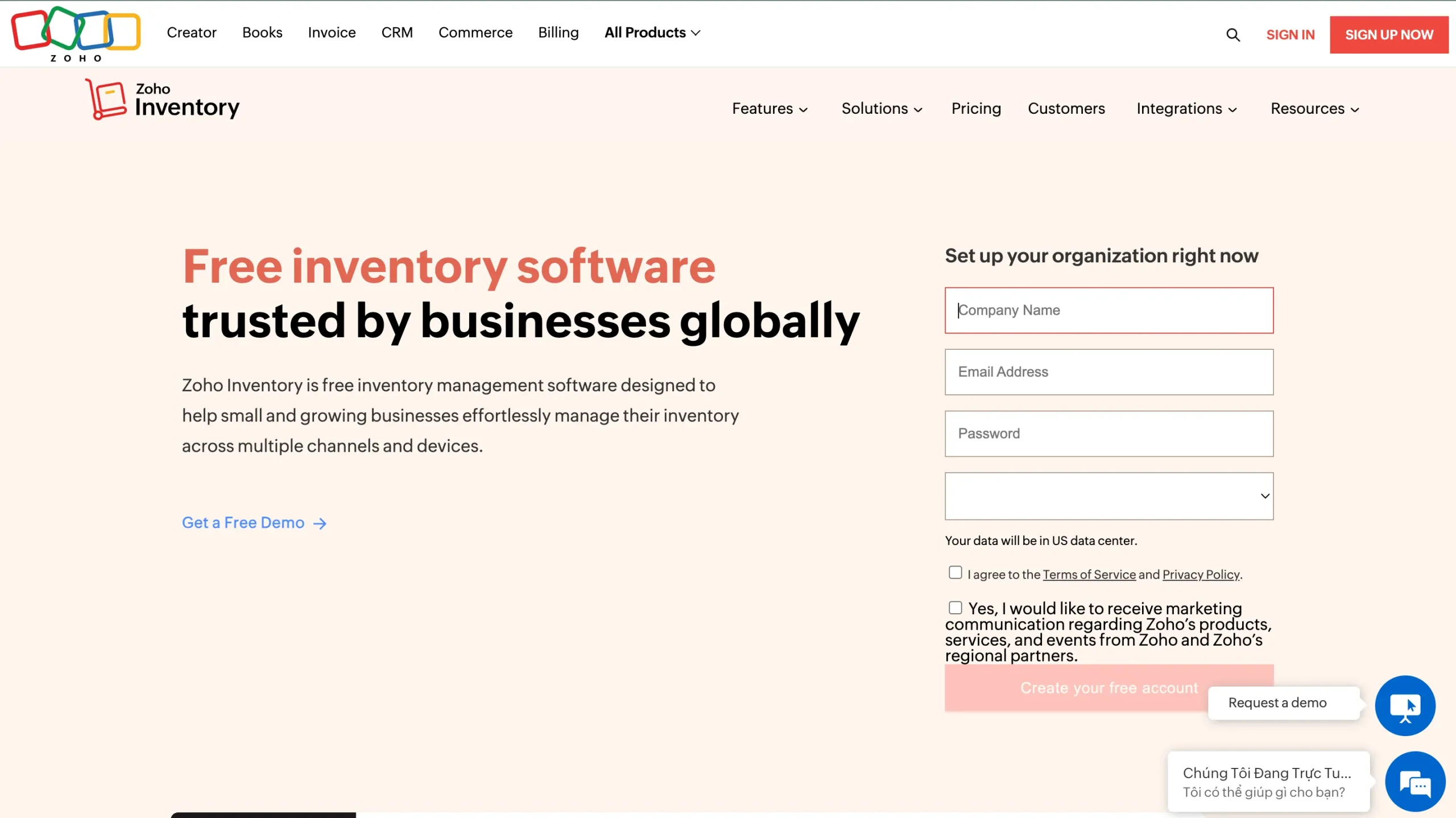
Designed with ease of use in mind, Zoho Inventory provides businesses with the tools they need to control inventory, automate shipping and fulfillment, and track sales performance in real time. Whether selling on Shopify, Amazon, eBay, or through their own eCommerce store, Zoho Inventory helps businesses centralize order management while ensuring accuracy and efficiency in every stage of the fulfillment process. It’s especially valuable for businesses looking to scale their operations without overextending resources, making it a popular choice among small and mid-sized enterprises.
Key Features
Zoho Inventory comes with a comprehensive set of features that address the essential needs of small to mid-sized businesses. These key features include multi-channel order management, inventory control, shipping and fulfillment automation, and seamless integration with leading eCommerce platforms.
- Multi-channel order management: Zoho Inventory’s multi-channel order management capabilities allow businesses to manage orders from various platforms in one centralized system. This includes integration with popular eCommerce platforms such as Shopify, WooCommerce, and Magento, as well as online marketplaces like Amazon and eBay. By consolidating orders from multiple sources, businesses can track, manage, and fulfill them from a single dashboard, eliminating the need to toggle between different systems and reducing the risk of errors.
- Inventory control: Keeping accurate track of inventory is critical for ensuring timely fulfillment and preventing stockouts or overstocking. Zoho Inventory provides real-time inventory updates, enabling businesses to monitor stock levels across multiple warehouses, retail locations, or distribution centers. This feature helps businesses maintain optimal stock levels, forecast demand, and ensure that inventory is available where it’s needed most, minimizing disruptions to the fulfillment process.
- Shipping and fulfillment automation: Zoho Inventory streamlines the shipping and fulfillment process by automating routine tasks such as order routing, shipping label generation, and order status updates. Integration with major shipping carriers allows businesses to compare shipping rates, print shipping labels, and track shipments in real time, ensuring faster and more accurate deliveries. This automation not only saves time but also reduces human error, leading to improved customer satisfaction.
- Integration with eCommerce platforms: Zoho Inventory integrates seamlessly with major eCommerce platforms, making it easy for businesses to manage sales and inventory across multiple online stores. These integrations allow businesses to sync product listings, update inventory levels in real time, and manage orders from multiple channels without the need for manual data entry. This ensures that inventory is always up-to-date across all platforms, preventing overselling and stock discrepancies.
Benefits
Zoho Inventory offers several key benefits that make it an ideal solution for small and mid-sized businesses looking for a cost-effective omnichannel order management system.
- Affordability: One of the biggest advantages of Zoho Inventory is its affordability. The platform is designed to provide comprehensive order and inventory management features without the high costs associated with more complex, enterprise-level systems. This makes it accessible for small and mid-sized businesses that need to streamline their operations without stretching their budget. Zoho Inventory offers various pricing tiers, allowing businesses to choose a plan that suits their specific needs and scale as they grow.
- Ease of use: Zoho Inventory is known for its intuitive interface, making it easy for businesses to navigate and manage orders, inventory, and fulfillment tasks. Its user-friendly design allows businesses to get up and running quickly, with minimal training required. This ease of use is especially beneficial for small businesses that may not have dedicated IT or logistics teams to manage complex systems.
- Seamless omnichannel management: Zoho Inventory’s ability to centralize orders and inventory from multiple sales channels ensures that businesses can manage their operations more efficiently. By providing a single source of truth for orders and inventory, businesses can avoid issues such as overselling, stockouts, and fulfillment delays. This seamless integration with eCommerce platforms and marketplaces also ensures that customers receive a consistent and reliable shopping experience, regardless of the sales channel they use.
- Automation and real-time visibility: The platform’s automation features help businesses save time by eliminating manual processes associated with order routing, inventory updates, and shipping tasks. Real-time visibility into inventory levels ensures that businesses can make informed decisions about stock replenishment and fulfillment priorities, helping them reduce costs and improve operational efficiency.
- Scalability: While Zoho Inventory is designed for small to mid-sized businesses, it also offers scalability to accommodate growing operations. As businesses expand their sales channels or increase order volumes, Zoho Inventory can scale with them, providing the necessary tools to manage larger inventories and more complex fulfillment processes. This scalability ensures that businesses can continue using the platform as they grow, without needing to transition to a more expensive or complex system.
Target Industries
Zoho Inventory is well-suited for small businesses, eCommerce companies, and wholesale operations that need a cost-effective solution for managing their orders and inventory across multiple sales channels.
- Small businesses: For small businesses with limited resources, Zoho Inventory offers an affordable and easy-to-use solution for managing orders, inventory, and fulfillment tasks. Its simple interface and powerful automation tools help small businesses reduce manual labor, streamline operations, and improve customer satisfaction without the need for extensive technical expertise.
- eCommerce: eCommerce companies selling through platforms like Shopify, WooCommerce, or Amazon can benefit from Zoho Inventory’s multi-channel management capabilities. By consolidating orders from different online stores and marketplaces, eCommerce businesses can improve operational efficiency, prevent stock discrepancies, and ensure faster fulfillment across all channels.
- Wholesale: Zoho Inventory also caters to wholesale businesses that need to manage large volumes of stock and multiple sales channels. Its real-time inventory tracking and integration with shipping carriers make it easy for wholesalers to manage inventory across multiple locations, fulfill orders efficiently, and keep customers informed about their order status.
Suitable For
Zoho Inventory is best suited for small to mid-sized businesses that need an affordable, scalable solution for managing orders and inventory across multiple channels. Its ease of use and automation features make it an ideal choice for businesses with limited technical expertise or resources, allowing them to streamline their operations and focus on growth.
While larger enterprises with more complex fulfillment needs may require additional functionality or customization, Zoho Inventory provides all the essential tools that small and mid-sized businesses need to manage their omnichannel order management processes efficiently. The platform’s flexibility and affordability make it a long-term solution for businesses looking to scale their operations without overspending on software.
Pricing
Zoho Inventory operates on a tiered subscription pricing model, with plans designed to accommodate businesses of various sizes and order volumes. Pricing starts at around $39 per month for the basic plan, which includes essential features such as multi-channel order management, inventory tracking, and shipping integrations. Higher-tier plans, which offer more advanced features and support for larger order volumes, are available at higher price points, with the highest-tier plan offering comprehensive functionality for growing businesses.
In addition to the monthly subscription fee, businesses may incur additional costs for integration with other Zoho applications or third-party services, such as payment gateways or shipping carriers. However, Zoho Inventory remains one of the most affordable options on the market, making it an excellent choice for small businesses and startups that need to manage orders and inventory without breaking the bank.
Case Study: The Souled Store
The Souled Store, a rapidly growing eCommerce brand specializing in pop culture merchandise, needed an affordable solution to manage its expanding inventory and multi-channel orders. As the company’s sales increased, The Souled Store struggled to keep track of stock across multiple sales channels, leading to occasional stockouts and fulfillment delays. The company required a solution that could automate order processing and provide real-time visibility into inventory levels to support their business growth.
The Souled Store implemented Zoho Inventory to centralize its order management and streamline its fulfillment processes. With Zoho Inventory, the company was able to automate routine tasks such as order routing and inventory updates, ensuring that stock levels were updated in real time across all sales channels. The platform’s integration with The Souled Store’s eCommerce platforms allowed the company to manage orders from its website, marketplaces, and retail outlets in one place, improving overall efficiency and reducing the risk of stockouts.
By using Zoho Inventory, The Souled Store significantly improved its operational efficiency and reduced fulfillment errors. The company was able to process orders faster, ensuring timely deliveries and enhancing customer satisfaction. Zoho Inventory’s real-time inventory tracking also helped The Souled Store prevent stockouts and maintain accurate stock levels, supporting their continued business growth. As a result, the company was able to scale its operations more effectively, meeting the demands of its growing customer base.
Cin7
Cin7 is a comprehensive omnichannel order management system designed to help businesses streamline their order and inventory processes across multiple sales channels and locations. With a focus on integrating inventory management, warehouse operations, and real-time data synchronization, Cin7 offers robust tools for handling both B2B and B2C orders, making it an ideal choice for businesses that need to manage complex inventory and order workflows. Cin7 provides businesses with end-to-end visibility and control over their operations, ensuring that inventory levels, sales data, and fulfillment processes are always accurate and up-to-date.
Cin7’s all-in-one platform brings together the tools needed for managing inventory, orders, and supply chains. The platform’s ability to handle a wide range of business types—from eCommerce and retail to wholesale—allows companies to operate more efficiently while reducing costs associated with stockouts, overstocking, and order delays. Cin7 is particularly well-suited for businesses operating across multiple locations or with diverse fulfillment needs, offering scalability and flexibility to adapt to growing demands.
Key Features
Cin7 offers a range of features designed to help businesses optimize their omnichannel order management processes. The platform’s key features include multi-channel order management, inventory optimization, warehouse management, real-time data synchronization, and support for both B2B and B2C order processing.
- Multi-channel order management: Cin7 enables businesses to manage orders from various sales channels, including eCommerce platforms, brick-and-mortar stores, and third-party marketplaces, in one centralized platform. This multi-channel capability allows businesses to consolidate orders from multiple sources and ensure that all sales data is captured in real-time, making it easier to manage order fulfillment and track performance across channels.
- Inventory optimization: With Cin7’s advanced inventory optimization tools, businesses can maintain accurate stock levels and prevent issues such as stockouts and overstocking. The platform provides real-time insights into inventory levels across all locations, helping businesses make informed decisions about purchasing and stock replenishment. By optimizing inventory levels, businesses can reduce holding costs and improve the efficiency of their supply chain operations.
- Warehouse management: Cin7’s warehouse management capabilities allow businesses to automate and optimize warehouse operations, including order picking, packing, and shipping. The platform enables businesses to track inventory movements within warehouses and distribution centers, ensuring that stock is always accurately accounted for and that orders are fulfilled as quickly as possible. This warehouse management functionality is particularly beneficial for businesses with multiple locations or those that rely on third-party logistics providers.
- Real-time data synchronization: Cin7 provides real-time data synchronization across all sales channels and locations, ensuring that businesses always have up-to-date information on orders, inventory levels, and customer data. This synchronization helps businesses reduce errors caused by manual data entry and ensures that all departments, from sales to logistics, are working with accurate and current information.
- B2B and B2C order processing: Cin7 supports both B2B and B2C order processing, making it ideal for businesses that serve both wholesale and retail customers. The platform allows businesses to handle bulk orders from wholesalers while also managing smaller, direct-to-consumer transactions. This flexibility ensures that businesses can meet the needs of all their customers, regardless of order size or complexity.
Benefits
Cin7 provides several key benefits that make it an attractive choice for businesses seeking an all-in-one solution for managing their inventory and order workflows. Some of the primary benefits include:
- Comprehensive inventory and warehouse management: Cin7’s robust inventory and warehouse management capabilities make it ideal for businesses with complex stock and fulfillment needs. The platform’s ability to track inventory in real time across multiple locations ensures that businesses always have a clear view of their stock levels, enabling them to optimize their purchasing and inventory replenishment strategies. Additionally, Cin7’s warehouse management tools help businesses streamline operations within distribution centers, reducing fulfillment times and improving accuracy.
- Efficient multi-channel order processing: Cin7’s multi-channel order management tools allow businesses to handle orders from multiple sales channels efficiently. Whether processing orders from online marketplaces, retail locations, or B2B customers, Cin7 centralizes all order data in one place, ensuring that businesses can track and fulfill orders without missing a beat. This efficiency helps businesses reduce order processing times and improve customer satisfaction.
- Real-time synchronization for accurate data: One of the biggest advantages of Cin7 is its real-time data synchronization, which ensures that all parts of the business have access to the same, up-to-date information. This feature is particularly valuable for businesses that operate across multiple locations or have multiple sales channels, as it helps reduce errors caused by outdated or inaccurate data. Real-time synchronization also ensures that stock levels are accurate, preventing issues like overselling or stockouts.
- Support for B2B and B2C customers: Cin7’s flexibility in handling both B2B and B2C orders makes it an ideal solution for businesses that serve a diverse customer base. The platform’s ability to manage bulk wholesale orders alongside smaller retail orders ensures that businesses can meet the needs of all their customers, regardless of order size or complexity. This dual functionality makes Cin7 a valuable tool for businesses looking to expand into new markets or grow their customer base.
Target Industries
Cin7 is particularly well-suited for retail, wholesale, and multi-location businesses that need a comprehensive solution for managing their inventory, orders, and fulfillment processes across multiple channels and locations.
- Retail: For retailers, Cin7 provides the tools needed to manage both online and in-store sales from a single platform. Its multi-channel order management and inventory optimization features ensure that retailers can maintain accurate stock levels and fulfill orders quickly, regardless of the sales channel.
- Wholesale: Wholesale businesses benefit from Cin7’s ability to handle large, bulk orders while optimizing inventory levels across multiple warehouses and locations. Cin7’s support for B2B order processing ensures that wholesalers can manage complex transactions and maintain accurate inventory records, making it easier to serve their customers efficiently.
- Multi-location businesses: Businesses with multiple retail or warehouse locations can leverage Cin7’s real-time data synchronization and warehouse management tools to ensure that inventory and order data is always up-to-date across all locations. This functionality helps businesses optimize their fulfillment processes, reduce stock discrepancies, and improve overall operational efficiency.
Suitable For
Cin7 is best suited for mid-sized to large businesses that need a powerful and flexible platform to manage complex inventory and order workflows. It is particularly beneficial for businesses that operate across multiple locations, whether in retail, wholesale, or eCommerce, as the platform’s real-time synchronization and multi-location management tools provide the visibility and control needed to optimize operations.
Cin7 is also ideal for businesses that serve both B2B and B2C customers, as its support for both order types allows businesses to manage wholesale and retail transactions within the same platform. While smaller businesses may find Cin7’s feature set more extensive than they require, mid-sized and larger businesses that need robust inventory and warehouse management capabilities will find Cin7 a valuable tool for scaling their operations.
Pricing
Cin7 operates on a subscription-based pricing model, with costs determined by the number of users, locations, and sales channels. Pricing for Cin7 typically starts at around $299 per month, making it a competitive option for mid-sized to large businesses that require a comprehensive solution for managing their omnichannel order and inventory workflows. Additional costs may apply for businesses that require extensive customization, integration with third-party systems, or support for a large number of users or locations.
While Cin7’s pricing may be higher than some other solutions designed for smaller businesses, its advanced features and scalability make it a cost-effective solution for businesses that need to manage complex, multi-location operations. Businesses interested in Cin7 should contact the company directly for a customized pricing quote based on their specific needs.
Case Study: Stedi
Stedi, a multi-location retail and wholesale business, faced challenges in managing both B2B and B2C orders while optimizing inventory across its various locations. The company needed an order management system that could handle orders from multiple sales channels, track inventory in real time, and streamline warehouse operations to reduce fulfillment times and improve overall efficiency.
Stedi implemented Cin7 as its centralized order and inventory management system. Cin7’s real-time synchronization of inventory and order data allowed Stedi to maintain accurate stock levels across all locations, ensuring that orders were fulfilled quickly and accurately. The platform’s multi-channel order management tools enabled Stedi to handle both retail and wholesale orders from a single system, improving the efficiency of its fulfillment process.
By using Cin7, Stedi saw significant improvements in inventory accuracy and order processing times. The company was able to reduce stock discrepancies, optimize warehouse operations, and fulfill orders more quickly, resulting in better overall business performance. Cin7’s ability to handle both B2B and B2C orders allowed Stedi to serve its diverse customer base more effectively, helping the company scale its operations and improve customer satisfaction.
Challenges in Omnichannel Order Management
Complexity of System Integration
Integrating Legacy Systems with New Omnichannel Solutions
Many businesses have invested heavily in legacy systems that have become deeply embedded in their operational workflows. However, these older systems were often designed for single-channel or limited multi-channel operations and lack the robust features needed to handle the complexities of omnichannel order management. For instance, legacy systems may not support real-time inventory updates across multiple sales channels or lack the flexibility to handle varied order routing processes required by omnichannel models.
Integrating these older systems with new omnichannel order management platforms requires significant technical expertise, as legacy systems often use outdated architecture or proprietary technology. Businesses must ensure that the various systems—such as point-of-sale (POS) systems, eCommerce platforms, and third-party logistics (3PL) software—can communicate with one another in real-time to provide an accurate, synchronized view of orders, inventory, and fulfillment across all channels.
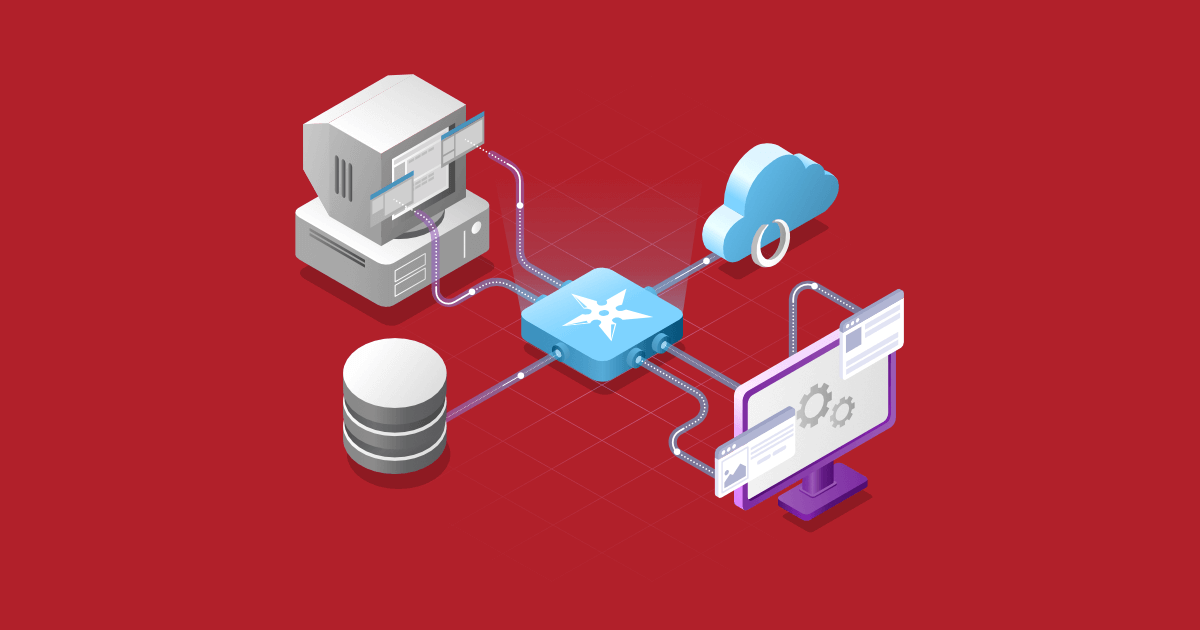
Without proper integration, businesses risk creating data silos, where different parts of the organization operate on disparate systems with limited visibility into the full operational picture. For example, a business’s eCommerce platform may not have access to the latest inventory data from physical stores, leading to stockouts or overselling on online channels. Similarly, customer orders placed through different platforms may not be consolidated, causing delays in fulfillment and a fragmented customer experience.
To overcome these challenges, businesses often need to invest in middleware or custom-built solutions to bridge the gap between legacy systems and modern omnichannel platforms. This process requires careful planning, as well as collaboration between IT teams, system vendors, and third-party consultants to ensure that data flows smoothly between systems, reducing the risk of disruptions or inconsistencies in order management processes.
Potential IT Bottlenecks and Challenges in System Synchronization
Another significant challenge in omnichannel order management is the potential for IT bottlenecks, particularly in the synchronization of different systems and platforms. With multiple sales channels, fulfillment centers, and third-party logistics providers, businesses must ensure that all systems are synchronized in real time to provide accurate and up-to-date information on inventory levels, order statuses, and shipping timelines.
Synchronization challenges often arise when businesses attempt to connect multiple systems that were not originally designed to work together. For example, a company’s inventory management system may operate on a different platform than its eCommerce software, leading to delays in data transmission or inconsistencies in stock levels. These synchronization issues can create bottlenecks in the order fulfillment process, resulting in delayed shipments, misallocated inventory, or inaccurate stock availability data displayed to customers.
In some cases, these IT bottlenecks can be compounded by the need to integrate with third-party systems, such as marketplace platforms like Amazon, eBay, or Walmart. These external systems have their own data formats and synchronization protocols, which may not align perfectly with a business’s internal systems. As a result, businesses must manage the complexity of integrating external sales channels with their omnichannel order management system to ensure that all orders are captured and processed correctly.
IT teams often face the challenge of managing large volumes of data from multiple sources, and ensuring that this data is processed and synchronized across various systems without errors or delays. System outages, connectivity issues, or software updates can further complicate the synchronization process, potentially leading to interruptions in order processing and fulfillment.
To address these challenges, businesses must ensure that they have robust IT infrastructure in place, with the capacity to handle high volumes of transactions and real-time data synchronization across all channels. This may involve upgrading existing systems, deploying cloud-based solutions, or working with third-party service providers to ensure that systems remain up-to-date and fully synchronized. Additionally, regular system audits and monitoring are essential for identifying potential bottlenecks and ensuring that synchronization issues are resolved before they impact the customer experience.
Data Management and Security
Handling Large Volumes of Customer, Inventory, and Transaction Data
Omnichannel order management relies heavily on real-time data, which includes customer profiles, order histories, inventory availability, shipping details, and financial transactions. As businesses expand their operations across online platforms, physical stores, and third-party marketplaces, the volume of data they must manage grows exponentially. This data originates from various sources—eCommerce platforms, point-of-sale (POS) systems, warehouse management systems (WMS), and customer relationship management (CRM) software—creating a complex network of information that must be accurately tracked and managed.
Handling such large volumes of data presents significant challenges. For one, businesses need to ensure that the data is synchronized in real time across all systems, allowing them to maintain an accurate picture of inventory levels, order statuses, and customer interactions. A delay in data synchronization, for example, could result in overselling, stockouts, or delayed deliveries, negatively affecting customer satisfaction and loyalty. Real-time visibility is essential in omnichannel order management, as it allows businesses to respond quickly to changes in demand, shifts in inventory, or supply chain disruptions.

Moreover, the sheer volume of transactional data can strain a company’s data management infrastructure. As more orders flow in from multiple sales channels, businesses must ensure that their systems can handle the increased data load without causing bottlenecks or performance issues. Poorly managed data can lead to inaccurate reports, inefficient fulfillment, and ultimately, dissatisfied customers. Additionally, as businesses expand into international markets, they face the added complexity of managing data in different currencies, languages, and regional compliance requirements.
To mitigate these challenges, businesses must invest in robust data management systems that can centralize information from all sales channels and touchpoints. Cloud-based omnichannel order management solutions can offer scalable data storage and processing capabilities, ensuring that businesses can manage large volumes of data without performance degradation. These systems also provide real-time data visibility, enabling businesses to make informed decisions about inventory allocation, order fulfillment, and customer service.
Additionally, businesses must implement rigorous data governance practices to ensure the accuracy and reliability of their data. This includes regularly auditing data for discrepancies, establishing clear protocols for data entry and management, and training staff to handle data consistently across all departments. By prioritizing data accuracy and integrity, businesses can streamline their omnichannel order management processes and reduce the risk of errors.
Ensuring Data Security and Compliance with Regulations (e.g., GDPR)
In addition to managing large volumes of data, ensuring data security is a critical challenge in omnichannel order management. With businesses handling sensitive customer information, such as payment details, addresses, and order histories, the risk of data breaches or unauthorized access is a growing concern. A security breach can have severe consequences, not only leading to financial losses but also damaging the company’s reputation and eroding customer trust.
Moreover, businesses operating across multiple regions must comply with stringent data privacy regulations, such as the General Data Protection Regulation (GDPR) in Europe or the California Consumer Privacy Act (CCPA) in the United States. These regulations impose strict requirements on how businesses collect, store, and process customer data, with significant penalties for non-compliance. For example, under GDPR, businesses are required to obtain explicit consent from customers before collecting their data, provide transparent information about how data is used, and allow customers to request the deletion of their personal data. Non-compliance can result in hefty fines and legal action.
Ensuring data security and compliance with these regulations in an omnichannel environment presents several challenges. First, businesses must safeguard data across multiple platforms and systems, including eCommerce websites, POS systems, CRM platforms, and third-party logistics providers. Each of these systems must be equipped with robust security measures, such as encryption, firewalls, and secure authentication protocols, to prevent unauthorized access. Data transmitted between systems must also be protected using secure communication channels to prevent interception by malicious actors.
Another challenge lies in managing access to data. With multiple teams handling different aspects of omnichannel order management—such as sales, customer service, and fulfillment—businesses must implement strict access controls to ensure that only authorized personnel can view or modify sensitive customer information. This requires setting up role-based access permissions, where employees are granted access to only the data necessary for their specific roles. Implementing multi-factor authentication (MFA) for system access can also provide an additional layer of security, reducing the risk of unauthorized logins.
In terms of compliance, businesses must ensure that their data management practices align with the legal requirements of the regions in which they operate. For example, businesses must maintain accurate records of customer consent, implement data retention policies, and provide customers with the ability to access, update, or delete their personal data upon request. Ensuring compliance can be particularly challenging for businesses that operate across multiple regions with different regulatory requirements.
To overcome these challenges, businesses should consider using an omnichannel order management system with built-in data security features and compliance tools. Many modern platforms offer GDPR-compliant data handling practices, such as automatic anonymization of customer data after a certain period, tracking of customer consent, and tools for responding to customer data requests. Additionally, businesses should conduct regular security audits to identify potential vulnerabilities and ensure that their systems comply with the latest security standards and regulations.
Inventory Allocation and Fulfillment Challenges
Deciding on Stock Allocation Across Multiple Locations
For businesses with an omnichannel strategy, deciding how to allocate stock across multiple locations—such as warehouses, brick-and-mortar stores, and distribution centers—can be a complex task. Unlike in traditional retail models, where inventory might be centralized in one or two locations, omnichannel order management requires a more dynamic approach to inventory distribution. Each sales channel must have sufficient inventory to meet customer demand, but businesses also need to avoid overstocking or understocking at any particular location.
One of the most challenging aspects of stock allocation is predicting demand for each location. Demand can fluctuate significantly across channels depending on seasonal trends, promotions, or regional preferences. For example, a specific product might sell well in certain regions or through a particular online marketplace, but if the inventory is not adequately distributed, businesses may struggle to fulfill orders in a timely manner, leading to delays and stockouts in certain locations while other warehouses or stores are overstocked.
Omnichannel businesses must rely on advanced demand forecasting tools and real-time data analytics to make informed decisions about how to allocate stock across their network of fulfillment locations. These tools can analyze historical sales data, market trends, and customer behavior to provide insights into which products are likely to sell well in specific regions or channels. This allows businesses to allocate stock strategically, ensuring that the right amount of inventory is available where it is needed most, reducing the risk of stockouts while minimizing excess inventory.
In addition, businesses must consider the role of different fulfillment strategies, such as ship-from-store, buy online pick up in-store (BOPIS), and direct-to-consumer (D2C) shipping from warehouses. Each of these fulfillment models places unique demands on inventory allocation. For example, BOPIS requires that physical stores maintain adequate stock to fulfill online orders, while ship-from-store models require real-time inventory visibility at the store level to prevent stockouts and ensure that customer orders can be fulfilled efficiently.
Managing these diverse fulfillment models requires seamless coordination between systems, as well as real-time data on inventory levels across all locations. Businesses need to implement robust inventory management systems that provide visibility into stock levels at every touchpoint in the supply chain, from warehouses to retail stores. Without this visibility, businesses may inadvertently allocate too much inventory to one channel while leaving another understocked, leading to imbalances in their supply chain.
Ensuring All Channels Can Meet Demand Without Overextending Resources
In addition to managing inventory allocation, businesses must also ensure that their fulfillment capabilities are sufficient to meet demand across all channels without overextending resources. Omnichannel order management demands a delicate balance between maximizing efficiency and maintaining flexibility to adapt to fluctuations in demand. If resources are stretched too thin, businesses risk falling short of customer expectations, leading to delays, backorders, or poor customer experiences.
One of the primary challenges businesses face in this regard is ensuring that their fulfillment infrastructure can handle high order volumes across all sales channels, especially during peak periods such as holidays or promotional events. During these times, the demand for certain products can surge dramatically, and if businesses do not have the necessary inventory in place or the fulfillment capacity to handle the increase in orders, they risk disappointing customers and losing potential sales.
To prevent this, businesses must implement scalable fulfillment strategies that allow them to ramp up operations as needed. This may involve working with third-party logistics providers (3PLs) that can provide additional warehouse space or shipping capacity during busy periods, or leveraging flexible fulfillment models like ship-from-store, which allows businesses to use their physical retail locations as mini-fulfillment centers to reduce shipping times and costs.
At the same time, businesses must avoid overextending resources by stocking too much inventory or investing in unnecessary fulfillment infrastructure. Overstocking not only ties up valuable capital but also increases the risk of unsold inventory, particularly for seasonal products with short sales windows. Similarly, investing in additional warehouse space or fulfillment technology that is only needed during peak periods can lead to wasted resources during slower times.
To strike the right balance, businesses must use demand forecasting tools to anticipate fluctuations in demand and adjust their inventory and fulfillment strategies accordingly. By analyzing data from all sales channels, businesses can identify patterns in customer behavior and adjust stock levels and fulfillment resources in real time. This allows them to optimize their supply chain, ensuring that inventory is available when and where it is needed, without overcommitting resources to any one channel or location.
Another key factor in managing omnichannel fulfillment without overextending resources is automating key processes. Automation can significantly improve efficiency by reducing the need for manual intervention in tasks such as order processing, inventory updates, and shipping label generation. Automated systems can allocate orders to the most appropriate fulfillment center based on factors like proximity to the customer, stock availability, and shipping costs, ensuring that orders are fulfilled as quickly and cost-effectively as possible.
For businesses with complex omnichannel operations, automation also plays a crucial role in managing returns, which can be a significant drain on resources if not handled efficiently. By automating the returns process and integrating it with the broader omnichannel order management system, businesses can streamline reverse logistics, minimize the costs associated with restocking and reshipping, and improve customer satisfaction.
Returns and Reverse Logistics
Managing Returns Across Different Sales Channels
In an omnichannel environment, managing returns across different sales channels involves coordinating return policies, processes, and logistics for both online and offline sales. Customers may purchase a product online and wish to return it in-store or buy something in a physical location and return it through an online process. This flexibility is a core element of modern customer expectations, but it also presents a significant challenge for businesses that must ensure seamless coordination between their sales and return channels.
One of the main challenges of omnichannel returns is ensuring that inventory systems are properly synchronized so that returned products are accounted for accurately, whether they are sent back to a warehouse or returned at a retail location. Without real-time data synchronization, businesses risk creating discrepancies in inventory counts, which can lead to stockouts, overselling, or delayed restocking of returned items. Managing these issues is especially critical in industries with fast-moving inventory, such as fashion or electronics, where returned goods must be quickly re-integrated into the supply chain to maximize resale opportunities.

Another challenge is that returns policies may differ across sales channels, particularly for businesses that sell through third-party marketplaces. For example, the return process for an item purchased through Amazon might differ from an item bought directly from a company’s own website. Businesses need to ensure that they can honor these different return policies while maintaining consistency in customer service. This requires integrating return processes from multiple platforms into a single omnichannel order management system that can track returns, generate return labels, and update inventory in real time across all channels.
Additionally, businesses must implement a smooth return process that minimizes friction for customers while efficiently processing returns in the back-end. Customers expect quick refunds or exchanges, and any delays in the returns process can result in dissatisfaction and loss of future business. For example, if a customer buys a product online and returns it in-store, the retail staff must be able to handle the return seamlessly, provide the refund or exchange, and ensure that the inventory system is updated immediately. Achieving this requires robust integration between point-of-sale (POS) systems, warehouse management systems (WMS), and eCommerce platforms to provide a consistent customer experience across all touchpoints.
Balancing Customer Satisfaction with Reverse Logistics Costs
While providing a seamless returns experience is critical for customer satisfaction, reverse logistics—the process of managing the return of goods—can be expensive and resource-intensive. The costs associated with reverse logistics include shipping fees, restocking expenses, labor for handling returned items, and, in some cases, the loss of revenue from unsellable or damaged products. Balancing customer expectations with these costs is one of the biggest challenges in omnichannel order management.
Customers today expect returns to be free or inexpensive, especially in competitive markets such as eCommerce. Offering free returns can significantly improve customer loyalty and increase conversion rates, but it also adds to the cost of doing business. For example, a customer who orders multiple sizes of clothing online with the intention of returning the items that don’t fit creates additional shipping and handling costs for the business. In some industries, return rates can be as high as 30%, particularly in sectors like fashion or electronics. These costs add up, putting pressure on businesses to find ways to streamline the returns process and minimize expenses.
To balance customer satisfaction with the cost of reverse logistics, businesses need to optimize their returns processes. This can involve offering customers multiple return options, such as in-store returns for online purchases or drop-off points that reduce shipping costs. Additionally, businesses can implement automated returns processes that allow customers to generate return labels online, track their returns in real time, and receive automatic refunds once the returned item is processed. These automated solutions not only improve customer satisfaction but also reduce the manual labor required to handle returns.
Another way to manage reverse logistics costs is through effective product inspection and restocking procedures. Not all returned items are resellable, but businesses can minimize losses by quickly inspecting and re-integrating sellable items into their inventory. This requires a well-coordinated process for assessing returned goods, determining whether they can be resold, and updating inventory systems in real time. Businesses with strong reverse logistics systems can turn returns into an opportunity to recapture value by quickly making products available for resale, either through their primary sales channels or through discounted resale on secondary marketplaces.
Additionally, businesses must carefully analyze the data from their returns processes to identify patterns and reduce returns in the future. By understanding why customers are returning products—whether due to sizing issues, product defects, or inaccurate descriptions—businesses can take proactive steps to minimize returns, such as improving product descriptions, offering more accurate sizing guides, or enhancing quality control measures. Reducing the volume of returns not only decreases the burden of reverse logistics but also improves customer satisfaction by delivering products that meet expectations.
Some businesses also choose to adopt selective return policies to mitigate reverse logistics costs, such as offering free returns only on higher-value items or for loyalty program members. This approach allows businesses to provide a high level of service to their best customers while managing the overall cost of returns. For lower-value items, businesses may offer store credit or charge a small restocking fee to offset the costs associated with handling the return. These policies must be communicated clearly to customers to avoid dissatisfaction and to ensure that expectations are managed upfront.
Human Resource and Skill Development
The Need for Specialized Skills to Manage Omnichannel Order Systems
Managing an omnichannel order management system requires specialized skills that go beyond the basic knowledge of inventory management or customer service typically required for traditional retail or eCommerce operations. Employees must have a deep understanding of the entire order fulfillment process, from the moment a customer places an order through various channels—whether online, in-store, or through third-party marketplaces—through to the final delivery, and even returns management. This level of complexity requires specialized knowledge of the systems and technology that support omnichannel operations.
One of the most pressing challenges for businesses implementing omnichannel order management systems is the need for employees who are proficient in using integrated technologies. These systems often include multiple platforms such as enterprise resource planning (ERP) systems, warehouse management systems (WMS), customer relationship management (CRM) software, and real-time data analytics tools. Employees must be able to work across these platforms, ensuring that data flows seamlessly between systems to provide real-time visibility into inventory, orders, and customer interactions.
For instance, employees responsible for managing inventory across multiple channels need to be adept at interpreting data from various sources to ensure that stock levels are accurately maintained and that orders are routed to the correct fulfillment location. This might involve analyzing data from eCommerce platforms, POS systems, and distribution centers to forecast demand, allocate inventory, and adjust stock levels in real time. Similarly, customer service teams must be trained to manage inquiries and complaints across different touchpoints, ensuring that customers receive consistent service whether they are shopping online, in-store, or through a mobile app.
The need for these specialized skills can create significant challenges for businesses, particularly those transitioning from traditional retail models. Finding and retaining employees who possess the technical expertise to manage an omnichannel order management system can be difficult, and the demand for such skills is growing as more businesses adopt omnichannel strategies. In some cases, businesses may need to hire new talent with specific experience in omnichannel operations, while in others, existing staff may need to be upskilled to meet the demands of the new system.
Training Staff on New Systems and Processes
Beyond hiring specialized talent, one of the most significant challenges in adopting an omnichannel order management system is training the existing workforce to use new systems and follow new processes. Moving to an omnichannel model often involves significant changes to how orders are processed, how inventory is managed, and how customer interactions are handled. This means that staff at all levels—whether in warehouses, retail stores, or customer service departments—must be trained to adapt to new ways of working.
For example, warehouse staff who are accustomed to fulfilling orders from a single sales channel may now need to process orders from multiple channels, such as online sales, in-store purchases, and marketplace orders, each of which may have different packaging, shipping, and inventory requirements. This requires not only technical training on the new order management system but also a broader understanding of how the omnichannel fulfillment process works and how their role fits into the larger operation.

Likewise, retail store staff may need training on how to handle online orders through services like buy online, pick up in-store (BOPIS) or ship-from-store. This requires them to use both POS systems and warehouse management tools, as well as maintain real-time communication with online fulfillment centers to ensure that inventory is accurately tracked. Customer service representatives also need to be trained to handle a wider range of customer inquiries, from order tracking to returns, across various channels. They must be familiar with the processes for both in-store and online orders to provide a seamless customer experience.
Training programs must be comprehensive and ongoing, as the technology behind omnichannel order management systems evolves rapidly. Businesses must invest in robust training programs that cover both the technical and operational aspects of omnichannel order management. This could include hands-on workshops, online training modules, and continuous learning programs to ensure that staff remain proficient in the latest tools and technologies.
Additionally, training must be tailored to different roles within the company. For example, warehouse workers may need specific training on scanning, packing, and shipping orders from multiple channels, while managers may need training on how to analyze real-time data to make strategic decisions about inventory allocation and fulfillment optimization. This role-based training ensures that each employee understands how to use the system in the context of their specific responsibilities, leading to smoother operations and fewer errors.
However, the challenge of training goes beyond just teaching staff how to use new technology. It’s also about changing mindsets and fostering a culture that embraces the omnichannel approach. Employees need to understand the importance of providing a consistent customer experience across all channels and how their role contributes to this. For instance, the warehouse worker picking an order for a customer who selected curbside pickup plays just as critical a role in the customer experience as the sales associate handing the item to the customer at the curb. Ensuring that all employees understand the bigger picture can help drive higher engagement and a commitment to the omnichannel strategy.
One way businesses can address this challenge is by appointing change champions within their teams—employees who are early adopters of the new system and can help train and guide others. These champions can serve as a bridge between management and frontline workers, helping to facilitate a smoother transition by addressing concerns, troubleshooting issues, and promoting the benefits of the new omnichannel order management system.
Best Practices for Implementing Omnichannel Order Management
Assessing Business Needs
Evaluating Current Systems and Identifying Gaps
Before implementing a new omnichannel order management system, businesses must begin by evaluating their existing systems and processes to identify gaps that need to be addressed. Most companies already have some level of order management infrastructure in place, whether it’s an enterprise resource planning (ERP) system, a warehouse management system (WMS), or eCommerce platforms that handle online orders. However, these systems may not be fully integrated, leading to silos of information, inefficient workflows, or limited visibility into real-time inventory and order statuses across channels.
Start by assessing the functionality of your existing systems:
- Order Processing: Are your current systems able to handle orders from all sales channels (online, in-store, mobile) seamlessly, or are there delays and errors in order capture, processing, and fulfillment? Evaluate the efficiency of the order routing process and determine whether manual interventions are often required to correct issues.
- Inventory Management: Do your inventory management systems provide real-time visibility into stock levels across all channels and locations? Many businesses struggle with inventory accuracy, which can lead to stockouts, overselling, or overstocking. Ensure that your current system supports real-time updates and can handle the complexity of omnichannel operations.
- Fulfillment and Shipping: Are your fulfillment and shipping processes optimized to deliver a seamless experience across all channels? Assess whether your fulfillment models (e.g., ship-from-store, buy online, pick up in-store) are adequately supported by your existing system, and identify bottlenecks that may be causing delays or increased costs.
- Returns Management: How effective are your returns management processes? Efficient reverse logistics is a key component of omnichannel order management, and your current systems should be able to handle returns across all sales channels with minimal friction for customers.
Once you’ve evaluated your current infrastructure, you can begin identifying specific gaps that are preventing your business from achieving its omnichannel goals. Common gaps include the inability to synchronize inventory across channels, lack of integration between systems (e.g., POS, eCommerce, and warehouse management), and manual processes that slow down order fulfillment. By identifying these gaps, you can create a roadmap for integrating new systems or upgrading existing ones to support a comprehensive omnichannel order management strategy.
Determining the Channels That Require Integration First
After evaluating your current systems and identifying operational gaps, the next step is to determine which sales channels should be prioritized for integration. While an omnichannel order management system is designed to eventually support all sales channels, it’s often not feasible—or advisable—to integrate everything at once. Prioritizing the channels that are most critical to your business’s success ensures a smoother transition and maximizes the return on investment (ROI) of the new system.
Start by evaluating the importance of each sales channel to your overall business strategy. Consider factors such as:
- Sales Volume: Which channels generate the highest sales volume or have the potential for growth? For many businesses, eCommerce platforms or marketplaces like Amazon and eBay represent a significant portion of total sales. These channels should be integrated early in the process to ensure that the majority of your orders are efficiently managed within the new system.
- Customer Engagement: Which channels are most important for customer engagement and satisfaction? Omnichannel customers expect a seamless shopping experience across both online and offline touchpoints. If your brick-and-mortar stores are a key part of your customer experience, integrating in-store systems such as POS and inventory management with your online platforms should be a top priority.
- Fulfillment Complexity: Which channels present the most complexity in terms of fulfillment? Channels that require complex fulfillment processes, such as ship-from-store or buy online, pick up in-store (BOPIS), should be prioritized to ensure that your new omnichannel order management system can handle the operational complexity of these models. Integrating these channels early helps avoid stock discrepancies, delays in order fulfillment, or customer dissatisfaction.
- Operational Bottlenecks: Which channels are currently experiencing the most inefficiencies or operational challenges? If certain sales channels are frequently plagued by delays in order processing, inventory inaccuracies, or fulfillment issues, these should be prioritized for integration to ensure that your new system immediately addresses key pain points.
By determining the order in which channels should be integrated, you can approach omnichannel order management implementation in a phased manner. For example, you might start by integrating your eCommerce platform with your warehouse management system to ensure that online orders are processed efficiently and inventory is updated in real time. From there, you can integrate additional channels, such as physical retail locations or third-party marketplaces, to create a fully synchronized omnichannel ecosystem.
Additionally, it’s essential to consider the customer experience during this integration process. Customers should not experience disruptions or inconsistencies as your business transitions to a new system. Phasing the integration of sales channels allows you to maintain high levels of service across all channels while gradually rolling out new capabilities and features.
Choosing the Right OMS
Key Considerations: Scalability, Compatibility, Ease of Use
When selecting an OMS for omnichannel order management, businesses must evaluate the system against several key criteria to ensure it meets both current and future needs. The most important considerations include scalability, compatibility with existing systems, and ease of use.
Scalability
As businesses grow and expand their omnichannel operations, their OMS must be able to scale accordingly. Scalability is one of the most critical factors to consider when choosing an OMS because what works for your business today may not suffice in a few years as order volumes increase, new sales channels are added, and customer expectations evolve.

A scalable OMS should be able to handle increases in order volume, inventory complexity, and fulfillment demands without sacrificing performance or efficiency. This is especially important for businesses experiencing rapid growth or seasonal fluctuations in demand. For instance, during peak shopping periods like Black Friday or holiday seasons, the OMS must be capable of processing a high volume of orders in real time while ensuring inventory levels are accurately updated across all channels.
Additionally, scalability includes the ability to integrate new sales channels as your business expands into different markets. Whether you’re adding new eCommerce platforms, opening physical stores, or expanding into international markets, the OMS should support the addition of these channels without major disruptions. An OMS that scales easily helps businesses maintain flexibility and efficiency as they grow, preventing the need for a costly system overhaul in the future.
Compatibility
Compatibility with your existing technology stack is another vital consideration. Most businesses already have established systems for enterprise resource planning (ERP), customer relationship management (CRM), point-of-sale (POS), and warehouse management (WMS). The OMS you choose must integrate seamlessly with these systems to ensure data flows freely between all parts of your operation, providing a real-time, unified view of inventory, orders, and customer information.
Incompatible systems can lead to data silos, where information is trapped within separate systems, resulting in inefficiencies, errors, and delayed decision-making. For example, if your OMS does not integrate well with your ERP or WMS, your teams may struggle to coordinate inventory management across channels, leading to stockouts, overstocking, or inaccurate order fulfillment.
To avoid these challenges, look for an OMS with built-in integration capabilities or one that supports open APIs. Open APIs allow your OMS to communicate with other systems, enabling the seamless exchange of data between platforms. Compatibility also extends to third-party systems, such as shipping carriers, marketplace platforms (e.g., Amazon, eBay), and payment gateways. The more adaptable the OMS, the easier it will be to connect and optimize your entire omnichannel ecosystem.
Ease of Use
Ease of use is often overlooked but is essential for ensuring smooth day-to-day operations. An OMS that is overly complex or difficult to navigate can slow down your staff, lead to errors, and hinder adoption across teams. The right OMS should be intuitive and user-friendly, enabling staff from various departments—such as customer service, warehouse operations, and retail stores—to use it efficiently without extensive training.
A user-friendly OMS not only improves operational efficiency but also enhances staff satisfaction and productivity. Employees are more likely to embrace a system that simplifies their tasks, reduces manual effort, and provides them with clear, actionable data. Moreover, an easy-to-use OMS allows businesses to onboard new staff more quickly and ensures that teams can handle seasonal fluctuations in demand without the need for extensive retraining.
When evaluating the ease of use of an OMS, businesses should consider whether the system offers customizable dashboards, automation tools, and real-time reporting features that streamline workflows. Automation is especially important, as it allows businesses to reduce the manual processing of orders, inventory updates, and fulfillment tasks. Additionally, the OMS should provide clear, real-time visibility into key metrics such as order statuses, inventory levels, and customer data, enabling staff to make informed decisions quickly and efficiently.
Aligning OMS Capabilities with Your Business’s Long-Term Goals
While scalability, compatibility, and ease of use are critical factors, businesses must also ensure that their OMS aligns with their long-term strategic goals. The OMS you choose should not only solve current challenges but also support future growth and innovation. Aligning your OMS with your business’s long-term goals involves considering how the system can adapt to changes in market trends, customer expectations, and business expansion plans.
Supporting Future Sales Channels and Markets
As businesses expand into new markets or introduce additional sales channels, their OMS must be able to handle this increased complexity. Whether your long-term plan involves expanding into international markets, launching a mobile commerce platform, or partnering with additional third-party marketplaces, the OMS should provide the flexibility to integrate these new channels seamlessly.

An omnichannel strategy is dynamic, with new platforms and sales models emerging regularly. For example, the rise of social commerce—selling directly through platforms like Instagram or Facebook—requires businesses to integrate these channels into their order management workflows. Choosing an OMS that can quickly adapt to new sales models or integrate with emerging technologies helps future-proof your operations, ensuring that your business can stay competitive as the retail landscape evolves.
Optimizing Customer Experience
Long-term business success increasingly depends on providing an exceptional customer experience across all touchpoints. The OMS plays a critical role in delivering a seamless, personalized experience by providing accurate real-time data on orders, inventory, and customer preferences.
For example, businesses that prioritize customer loyalty and retention should choose an OMS that supports advanced customer relationship management features, such as order history tracking, personalized promotions, and tailored product recommendations. An OMS that integrates with CRM systems enables businesses to deliver consistent, high-quality service, regardless of whether a customer shops online, in-store, or through mobile platforms.
Data-Driven Decision-Making
As businesses grow, data becomes an invaluable asset for making strategic decisions. A powerful OMS should offer advanced analytics and reporting capabilities that provide insights into sales performance, inventory trends, and customer behavior. These data-driven insights help businesses optimize inventory allocation, improve order fulfillment, and anticipate future demand.

When choosing an OMS, consider whether the system offers robust data visualization tools, customizable reports, and the ability to integrate with business intelligence (BI) platforms. These features ensure that your leadership team has access to the information they need to make informed decisions and support the long-term growth of the business.
Flexibility for Customization and Expansion
Finally, the ideal OMS should be flexible enough to evolve with your business as it expands or changes direction. Some businesses may require custom workflows, unique fulfillment models, or specialized integrations with industry-specific software. The OMS you choose should offer customization options that allow you to tailor the system to your specific operational needs.
Additionally, as your business grows, your OMS should be able to accommodate higher volumes of orders, customers, and products. Choosing an OMS with a flexible architecture ensures that it can scale without performance issues or the need for a complete system replacement, saving your business time and money in the long run.
Ensuring Data Accuracy and Real-Time Synchronization
Setting Up Real-Time Data Flow
In an omnichannel order management system, real-time data flow between various sales channels—such as eCommerce platforms, retail locations, mobile apps, and third-party marketplaces—and the back-end systems managing inventory and fulfillment is critical. Accurate, up-to-the-minute data allows businesses to optimize inventory levels, route orders efficiently, and fulfill customer orders on time. Without real-time data, businesses risk facing operational bottlenecks, missed sales opportunities, and customer dissatisfaction due to unanticipated stockouts or delayed shipments.
One of the first steps in setting up real-time data flow is to ensure that all sales channels are integrated with your order management system (OMS). This means that data from every sales channel, whether it be a website, physical store, or third-party platform like Amazon or eBay, is fed directly into the OMS. For instance, as soon as a customer makes a purchase, the order information should be immediately reflected in the system, updating inventory levels, triggering the fulfillment process, and providing the customer with real-time updates on order status and delivery expectations.
To achieve this level of synchronization, businesses must implement seamless integrations between their sales platforms, warehouse management systems (WMS), and fulfillment centers. APIs (Application Programming Interfaces) play a critical role in this process, allowing systems to communicate and exchange data in real time. When sales data flows freely between all systems, businesses can monitor inventory and sales performance in real time, which reduces the likelihood of overselling or running into inventory shortages.
For example, in a scenario where a customer places an order online for in-store pickup, the real-time data flow ensures that inventory is accurately updated in the system, and the store staff is notified immediately to prepare the order. Similarly, if a customer orders an item through a marketplace that is fulfilled from a third-party warehouse, the system should automatically adjust inventory levels across all channels to reflect the sale, ensuring that other sales platforms don’t oversell the same product.
In addition to real-time data flow between sales channels, it’s essential to ensure that data is synchronized with fulfillment centers. Real-time synchronization between order management and fulfillment systems ensures that orders are routed to the most appropriate fulfillment center or warehouse based on factors such as proximity, stock availability, and shipping cost. This level of synchronization helps to minimize fulfillment times, reduce shipping costs, and improve overall customer satisfaction.
Real-time data flow also plays a critical role in managing inventory replenishment. As inventory levels are continuously updated, businesses can implement automated reorder triggers to restock popular items before they sell out. This prevents stockouts, which are particularly problematic in an omnichannel environment where customers expect products to be available across all sales channels at all times. Automated replenishment systems that rely on real-time data can ensure that stock is allocated where it’s needed most, whether in a physical store or an online fulfillment center.
Using a Unified Dashboard for Centralized Monitoring
To manage the complexities of omnichannel order management, businesses need a centralized system that provides real-time visibility into all aspects of their operations. A unified dashboard is an essential tool for monitoring sales, inventory, fulfillment, and customer interactions across all channels. This dashboard consolidates data from various systems into one interface, allowing teams to monitor key performance metrics, make informed decisions, and address issues in real time.
A unified dashboard serves as the central hub for managing omnichannel operations, providing an at-a-glance view of the entire order management process. By having all data centralized in one place, businesses can reduce the risk of miscommunication, minimize delays in order processing, and ensure that every department has access to the same information.
Some key benefits of using a unified dashboard include:
- Real-time inventory tracking: A unified dashboard enables businesses to track inventory levels across all locations—whether warehouses, retail stores, or third-party logistics providers—in real time. This visibility ensures that stock levels are accurate, preventing overselling and stockouts. With inventory data centralized, businesses can also make better decisions about when and where to allocate stock, ensuring that the right products are available in the right locations at the right time.
- Order status monitoring: The dashboard provides real-time updates on the status of all orders, from the moment a customer places an order to when it is fulfilled and shipped. This transparency allows teams to proactively manage orders and resolve issues before they escalate. For example, if an order is delayed due to inventory shortages or fulfillment bottlenecks, the system can flag the issue so that the appropriate teams can take action.
- Fulfillment performance: A unified dashboard provides insights into fulfillment efficiency, helping businesses optimize their order routing and shipping processes. By monitoring performance across all fulfillment centers, businesses can identify bottlenecks, improve delivery times, and reduce costs. The dashboard can also provide valuable data on shipping performance, such as average delivery times and shipping costs, which can be used to improve logistics strategies.
- Customer service coordination: Customer service teams benefit from having access to real-time data on order statuses and inventory levels. When customers inquire about their orders, support staff can quickly check the unified dashboard to provide accurate updates or resolve issues. Having this real-time data at their fingertips reduces response times and improves the overall customer experience.
- Data-driven decision making: The dashboard’s real-time reporting capabilities enable businesses to analyze sales trends, inventory turnover, and fulfillment performance. By leveraging this data, businesses can make informed decisions about inventory allocation, pricing strategies, and promotional campaigns. Real-time insights also enable businesses to be more agile, quickly adapting to changes in demand or market conditions.
- Improved collaboration: With a centralized system, all teams—from sales and customer service to warehouse operations—can access the same real-time data, improving collaboration across departments. This unified approach ensures that everyone is working from the same set of information, reducing the risk of miscommunication and ensuring that decisions are made based on accurate, up-to-date data.
Moreover, the use of automation in conjunction with a unified dashboard can significantly enhance the efficiency of omnichannel order management. For example, automated alerts can notify teams when stock levels are running low or when an order is delayed, prompting immediate action to resolve the issue. Automation can also streamline routine tasks such as generating shipping labels, updating inventory, and routing orders to the nearest fulfillment center, allowing teams to focus on higher-level decision-making.
Employee Training and Adoption
Strategies to Ensure Smooth Transition and Employee Buy-In
Transitioning to an omnichannel order management system often involves significant changes to workflows, technology, and daily tasks for employees. A smooth transition depends on having a well-thought-out strategy to get employees on board early, address their concerns, and ensure they understand how the changes will benefit both the business and their own work. Securing employee buy-in is crucial because it reduces resistance to change and promotes a culture of collaboration, where teams are motivated to embrace new tools and processes.
Communicate the Benefits Early and Often
One of the most effective ways to ensure employee buy-in is to clearly communicate the benefits of the new omnichannel order management system. Employees need to understand how the new system will improve their day-to-day tasks, reduce manual errors, and enhance overall efficiency. Emphasize that the implementation is not just about improving business outcomes but also about making their jobs easier by automating repetitive tasks, providing better real-time visibility into inventory and order statuses, and reducing the manual effort required to complete tasks.
For example, warehouse staff might initially be concerned about learning a new system or changing established workflows, but if they see that the new system streamlines order fulfillment and inventory management—reducing the time they spend on manual data entry or physical stock counting—they’ll be more likely to embrace the change. Similarly, customer service teams can be shown how the system will provide faster access to real-time data, enabling them to offer more accurate and responsive service to customers.
Involve Employees in the Implementation Process
Engaging employees in the implementation process from the start can also foster a sense of ownership and reduce resistance to change. Involving key stakeholders from different departments—such as warehouse staff, sales teams, and customer service representatives—in the planning and implementation phases ensures that the system is designed to meet the practical needs of end users.

One way to involve employees is by appointing change champions or super users from each department. These individuals can act as liaisons between management and frontline workers, providing valuable feedback on the system’s usability, identifying potential bottlenecks, and helping their colleagues understand the new processes. Change champions also play a key role in training and supporting their teams during the transition, acting as in-house experts who can answer questions and troubleshoot issues as they arise.
By giving employees a voice in the implementation process, businesses can better tailor the system to real-world use cases and create a sense of shared responsibility for the success of the transition. This approach also helps uncover potential issues before full deployment, reducing disruptions to daily operations once the system goes live.
Gradual Rollout and Piloting
Instead of rolling out the omnichannel order management system across all departments and locations at once, businesses may benefit from a phased implementation or pilot program. A gradual rollout allows employees to adapt to the system in stages, minimizing the impact on day-to-day operations and giving teams time to get comfortable with the new processes before they are fully implemented company-wide.
For instance, businesses could begin by introducing the system in a single fulfillment center or a small subset of retail stores, gathering feedback from employees and addressing any challenges they face during the transition. This pilot phase provides an opportunity to fine-tune the system, identify training gaps, and make adjustments to workflows before scaling up to the entire organization. As each phase is completed successfully, the system can be expanded to additional locations or departments, ensuring a smoother transition overall.
Addressing Employee Concerns
Change can be daunting for employees, especially when it involves learning new technology or adjusting to different workflows. Businesses must proactively address any concerns or anxieties employees may have about the new omnichannel order management system. This could include fears of job displacement due to automation or concerns about the difficulty of learning new tools.

Transparent communication is key. Reassure employees that the new system is designed to make their work more efficient, not replace their roles. Highlight how the system will reduce repetitive tasks and enable them to focus on higher-value activities that improve customer service or streamline operations. Offering open forums, Q&A sessions, or workshops where employees can voice their concerns and receive clear, honest answers can help alleviate anxiety and build trust in the new system.
Training Staff on New Omnichannel Order Management Tools and Processes
Effective training is the foundation of successful omnichannel order management implementation. The more comprehensive and practical the training, the faster employees can adapt to the new system and the fewer errors and disruptions will occur during the transition. Training programs should be designed to meet the specific needs of different roles within the company, as each department will interact with the omnichannel order management system in unique ways.
Role-Based Training
Different teams within the organization—such as warehouse staff, retail employees, customer service representatives, and sales teams—will use the omnichannel order management system in different ways. Therefore, it’s important to tailor training programs to the specific needs and workflows of each role.
- Warehouse staff: Training for warehouse staff should focus on the order fulfillment process, including how to use the system to track inventory, pick and pack orders, and update stock levels in real time. Automation tools that streamline tasks like scanning barcodes or printing shipping labels should be highlighted to demonstrate how the system will make their jobs more efficient.
- Retail staff: In-store employees will need to understand how the system integrates online and offline sales channels. For instance, training should cover how to handle buy online, pick up in-store (BOPIS) orders, how to access real-time inventory data for customer inquiries, and how to process returns from online purchases.
- Customer service representatives: Customer service teams should be trained on how to use the system to track order statuses, resolve customer inquiries, and manage returns or exchanges. The training should also include how to access customer history and preferences to provide a more personalized and efficient service.
- Sales teams: Sales staff who manage B2B or wholesale orders may need training on how to input and track larger, bulk orders across multiple locations, monitor delivery timelines, and ensure that stock is allocated efficiently across different regions.
Hands-On Training
To maximize the effectiveness of training programs, businesses should incorporate hands-on training sessions where employees can interact directly with the new omnichannel order management system. This practical approach allows employees to experience the system in real time, learn the ins and outs of the tools they’ll be using, and ask questions along the way. Simulating common scenarios—such as fulfilling an order, processing a return, or checking inventory levels—helps employees gain confidence in using the system before it goes live.
Interactive training methods, such as guided walkthroughs, role-playing scenarios, or live demonstrations, tend to be more engaging and effective than passive methods like videos or instruction manuals. Providing employees with opportunities to experiment with the system and practice using it in real-world situations ensures they are better prepared for the system’s full implementation.
Ongoing Support and Continuous Learning
Training shouldn’t end once the omnichannel order management system is up and running. As the system evolves—whether through updates, new features, or changes in business processes—employees will need ongoing training and support to stay up to date with the latest tools and best practices.
Offering continuous learning opportunities, such as refresher courses, online tutorials, or regular workshops, helps employees stay proficient in using the system and ensures that new staff members are brought up to speed quickly. A knowledge base or help center, where employees can access training materials, FAQs, and troubleshooting guides, provides ongoing support and enables staff to resolve minor issues independently.
In addition to formal training sessions, businesses should encourage a culture of peer support, where more experienced employees can help their colleagues navigate the system and solve problems. Change champions or super users can play a key role in providing day-to-day support and training for their teams, answering questions and sharing best practices.
Measuring Training Effectiveness
Finally, businesses should track and evaluate the effectiveness of their training programs to ensure that employees are fully prepared to use the new omnichannel order management system. Regular assessments, quizzes, or performance reviews can help identify areas where additional training is needed, allowing businesses to address knowledge gaps before they become larger issues. Gathering feedback from employees on the training process can also provide valuable insights into what worked well and where improvements can be made for future training sessions.
Employee training and adoption are critical components of successfully implementing an omnichannel order management system. By developing strategies to ensure a smooth transition, involving employees in the process, and providing role-based, hands-on training, businesses can ensure that their teams are well-prepared to operate within the new system. With the right support and ongoing learning opportunities, employees will not only adopt the system more quickly but also help the business maximize the benefits of its omnichannel strategy, driving operational efficiency and improving the overall customer experience.
Creating a Customer-Centric Order Management Strategy
Using Customer Insights to Refine Order Management Workflows
The foundation of a customer-centric order management strategy lies in using customer insights to tailor and improve workflows. In omnichannel order management, customers interact with businesses across various touchpoints—whether they are browsing products online, visiting a physical store, or engaging with customer service representatives. Each of these interactions generates valuable data that businesses can use to understand customer preferences, shopping habits, and pain points.
By analyzing data from different channels, businesses can identify patterns and trends that help refine their order management processes. For example, customer insights can reveal which fulfillment options (e.g., home delivery, buy online pick up in-store, or curbside pickup) are most popular among different customer segments. If data shows that a significant portion of customers prefers in-store pickup, businesses can adjust their inventory allocation and order routing workflows to ensure that stores are well-stocked and ready to fulfill these orders efficiently. This approach not only reduces the likelihood of stockouts but also improves the overall customer experience by ensuring faster, more convenient service.

In addition to fulfillment preferences, customer insights can be used to optimize order processing workflows. For example, data from repeat customers can be used to streamline order handling, particularly for loyal customers who frequently purchase the same products. Businesses can create workflows that prioritize these orders, ensuring they are processed and fulfilled more quickly, leading to faster delivery times and higher customer satisfaction.
Customer insights also play a critical role in demand forecasting, a key aspect of omnichannel order management. By analyzing historical purchasing data, businesses can predict which products are likely to see increased demand during specific times of the year or during promotions. This allows businesses to adjust inventory levels and fulfillment processes in anticipation of demand spikes, reducing the risk of stockouts or delayed shipments. For instance, retailers may see an uptick in demand for certain products leading up to the holiday season. Armed with this knowledge, they can allocate stock more effectively across channels and fulfillment centers, ensuring that inventory is available where it’s most needed.
Moreover, customer feedback and reviews provide valuable insights into areas where order management workflows can be improved. If customers frequently complain about delayed deliveries, long wait times for in-store pickups, or confusing return processes, businesses can use this feedback to address inefficiencies in their omnichannel order management system. By listening to customers and incorporating their insights into decision-making, businesses can create a more responsive and customer-friendly order management strategy.
Implementing Personalization and Predictive Analytics for a Better Customer Experience
Personalization is increasingly becoming a cornerstone of customer-centric strategies in omnichannel order management. Customers today expect tailored experiences, from product recommendations to personalized promotions and customized delivery options. Implementing personalization in the order management process helps businesses not only meet but exceed customer expectations, resulting in stronger loyalty and higher conversion rates.
One way to implement personalization in omnichannel order management is through customized fulfillment options. For example, businesses can offer personalized delivery choices based on a customer’s purchase history or geographic location. A customer who frequently chooses curbside pickup may be presented with this option as the default during checkout, saving time and improving the overall shopping experience. Similarly, customers who typically prefer fast shipping may automatically be offered expedited delivery options, providing convenience while still giving them the flexibility to choose other alternatives.
Personalization also extends to the post-purchase experience. Using customer data, businesses can send personalized notifications about order status, delivery updates, or potential delays. Customers appreciate timely, relevant communication, and personalized order tracking updates can help reduce anxiety about when and how their order will arrive. By keeping customers informed at each stage of the order management process, businesses can enhance the sense of transparency and reliability, which builds trust and drives repeat purchases.
Another key component of a customer-centric order management strategy is the use of predictive analytics. Predictive analytics involves using historical and real-time data to anticipate future customer behavior and trends, allowing businesses to make proactive decisions about inventory management, order fulfillment, and customer service. When applied to omnichannel order management, predictive analytics can help businesses anticipate demand, optimize order routing, and even identify potential bottlenecks in the supply chain before they occur.
For instance, predictive analytics can be used to forecast which products are likely to see increased demand in certain regions based on past sales data and current market trends. Businesses can then adjust their inventory levels and allocate stock to the appropriate fulfillment centers, ensuring that popular products are available for customers when they need them. Predictive analytics can also help businesses identify trends in customer behavior that indicate a preference for specific fulfillment methods or delivery times, allowing them to adjust their order management workflows accordingly.
In addition, predictive analytics can be used to improve the returns process, which is often a pain point in omnichannel order management. By analyzing past return data, businesses can identify patterns in product returns—such as specific items that are frequently returned due to sizing issues or defects—and take steps to reduce the likelihood of returns. For example, businesses may decide to provide more detailed product descriptions or sizing guides based on insights from return data, thereby improving customer satisfaction and reducing the cost of reverse logistics.
Another application of predictive analytics is in fraud detection and prevention. By analyzing transaction data and customer behavior, businesses can identify suspicious patterns that may indicate potential fraud, such as unusually large orders or multiple orders placed from different locations in a short time frame. Implementing fraud detection measures early in the order process helps protect both the business and the customer, ensuring a secure and trustworthy shopping experience.
Finally, a customer-centric order management strategy should be designed with customer retention in mind. Predictive analytics can help businesses identify at-risk customers—those who may be dissatisfied with their experience or who haven’t made a repeat purchase in a while—and engage them with personalized offers or incentives to re-engage. For example, businesses can send targeted promotions to customers who abandoned their carts or offer exclusive discounts to loyal customers who haven’t made a purchase in a few months. By leveraging predictive analytics to identify and address these opportunities, businesses can enhance customer retention and encourage repeat purchases.
Conclusion
Omnichannel order management has become an essential component for modern businesses operating in an increasingly complex and competitive marketplace. As customers interact with brands across multiple sales channels—whether online, in-store, or through mobile platforms—businesses must ensure that their order management systems can keep pace with these evolving expectations. A robust omnichannel order management system allows businesses to streamline operations, provide seamless customer experiences, and improve fulfillment efficiency. By integrating real-time data flow across sales channels, inventory management, and fulfillment centers, businesses can ensure that they are well-equipped to meet the demands of today’s consumers.
In the era of eCommerce, where convenience and speed are paramount, a comprehensive and agile order management system serves as a significant competitive advantage. Businesses that can effectively manage orders across multiple touchpoints while maintaining accurate inventory levels and delivering on time are more likely to foster customer loyalty and outpace their competitors. Additionally, the ability to personalize the shopping experience and anticipate customer needs through predictive analytics further enhances customer satisfaction and drives growth.


